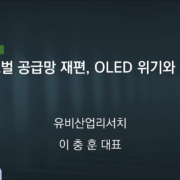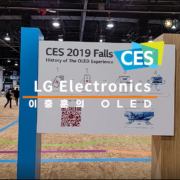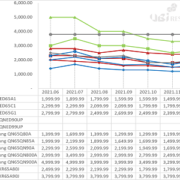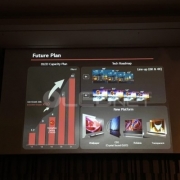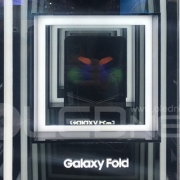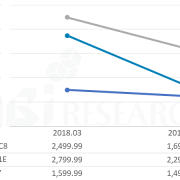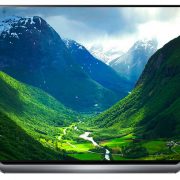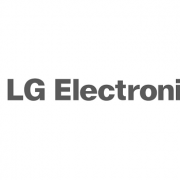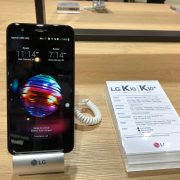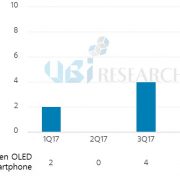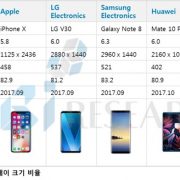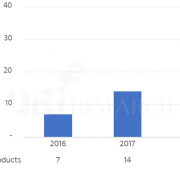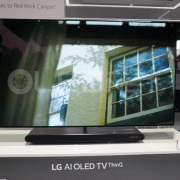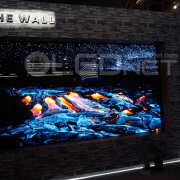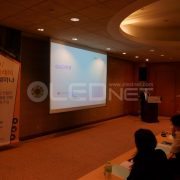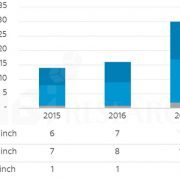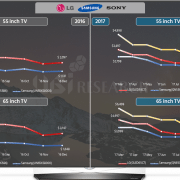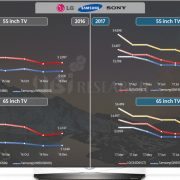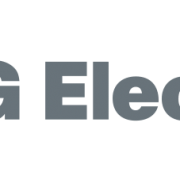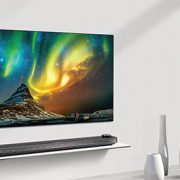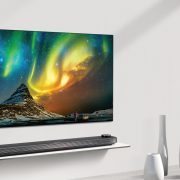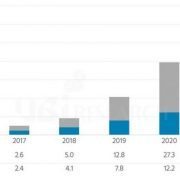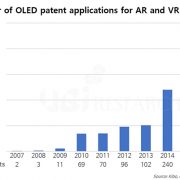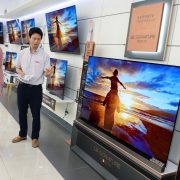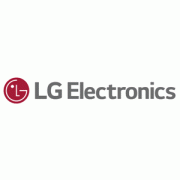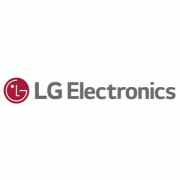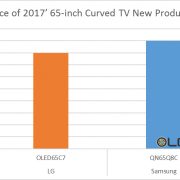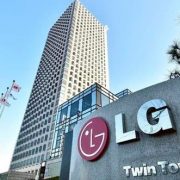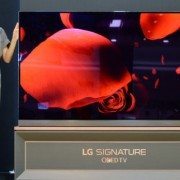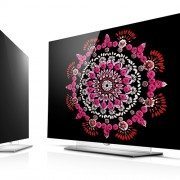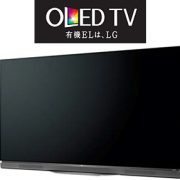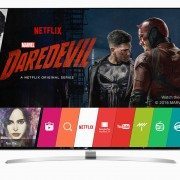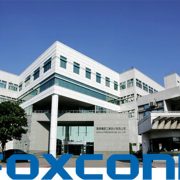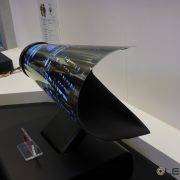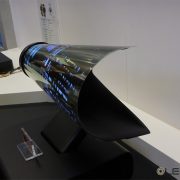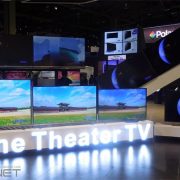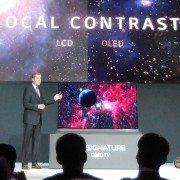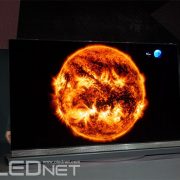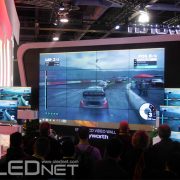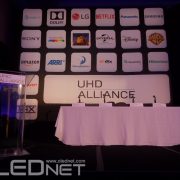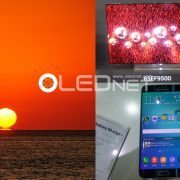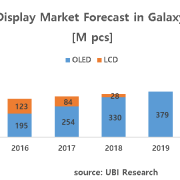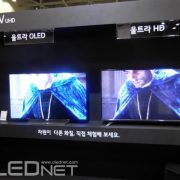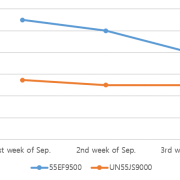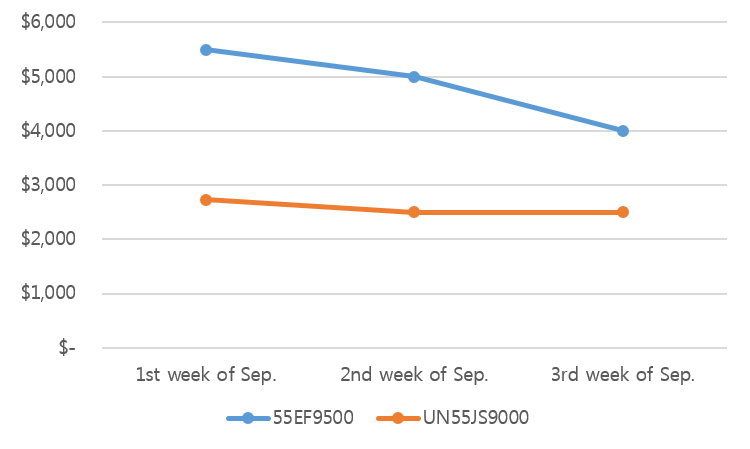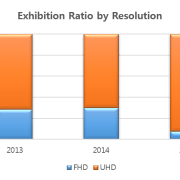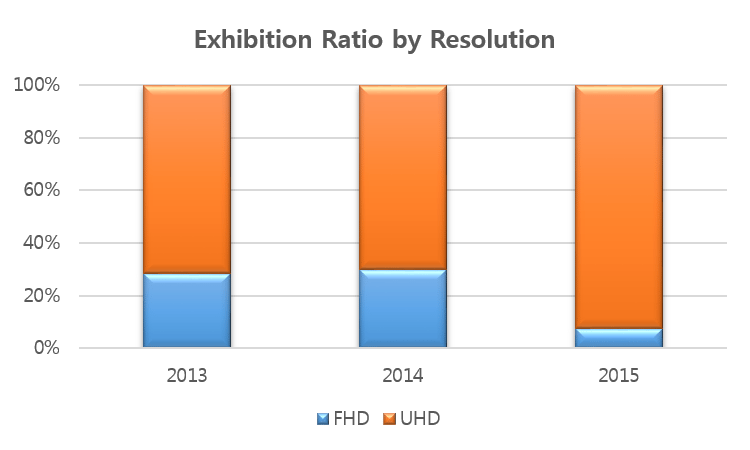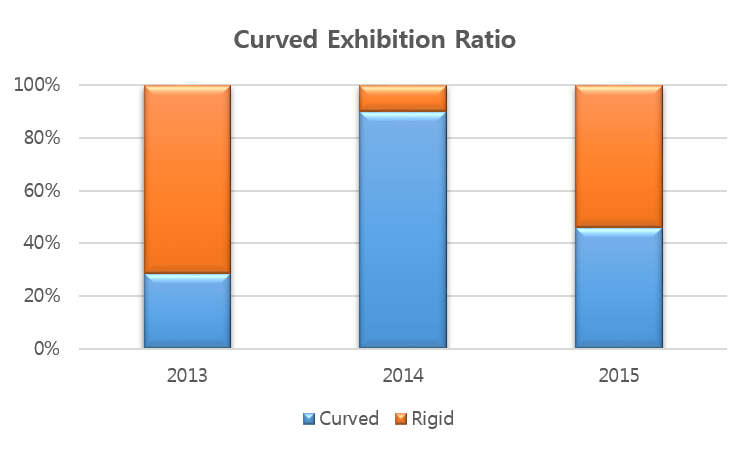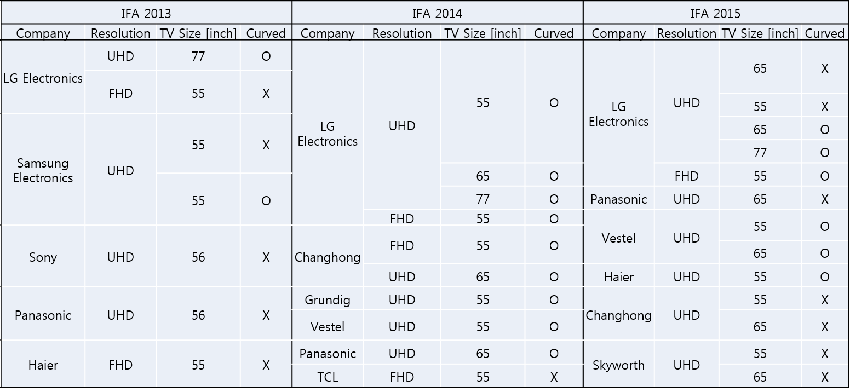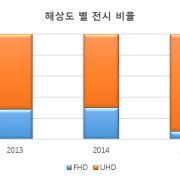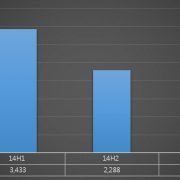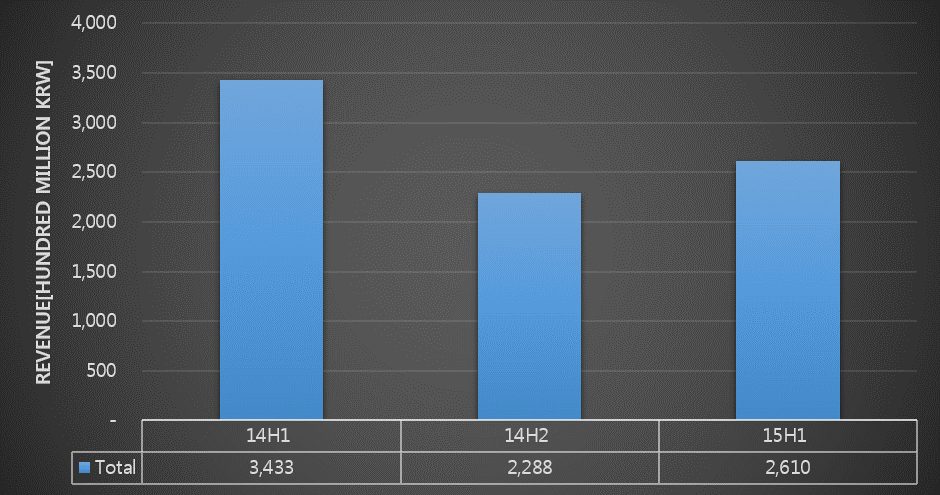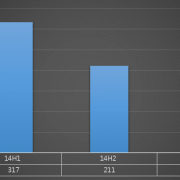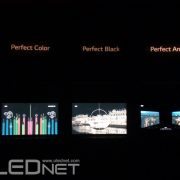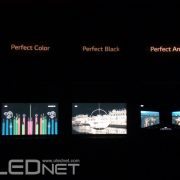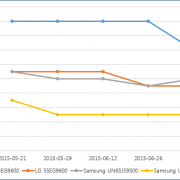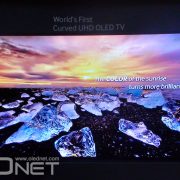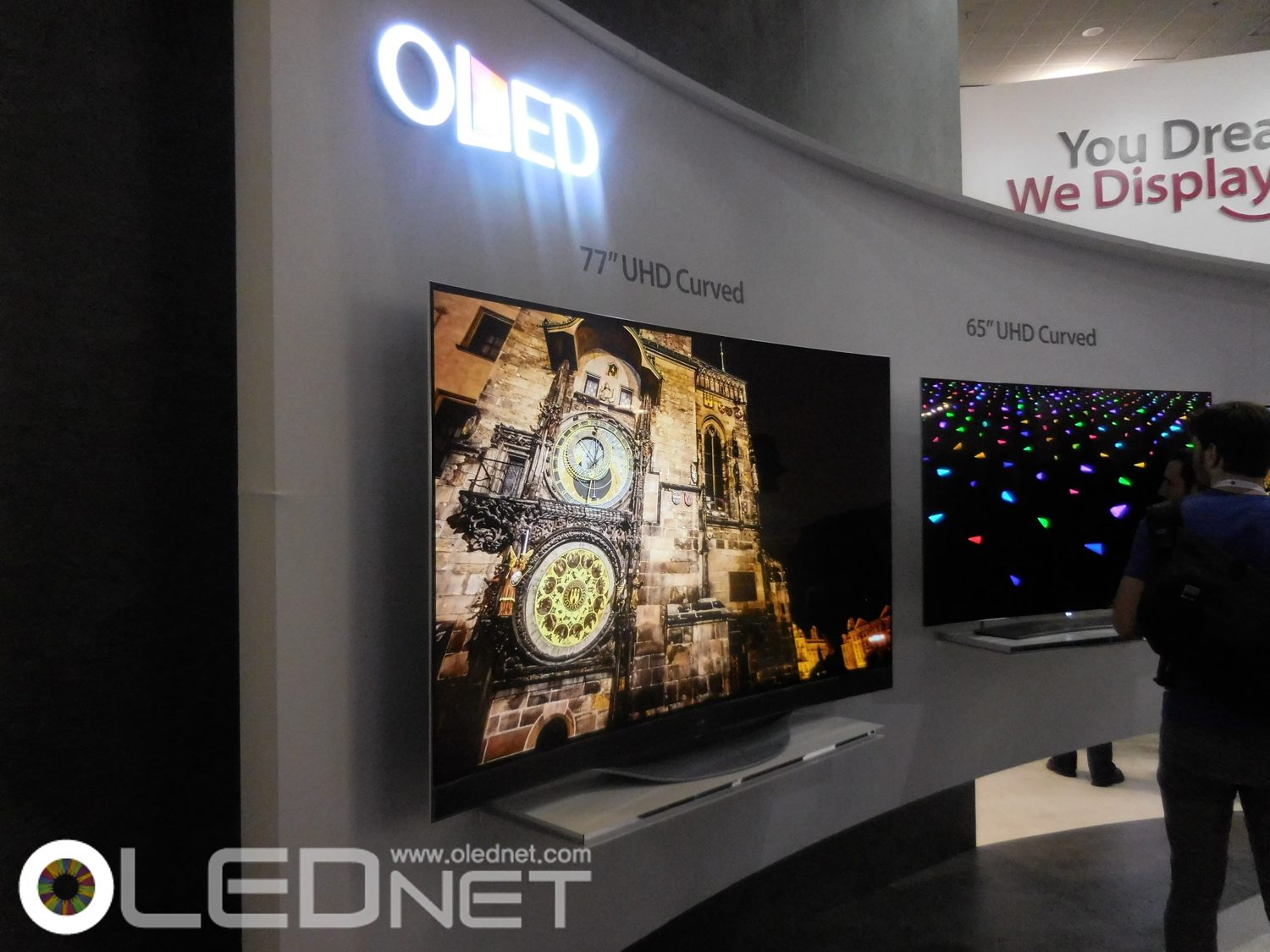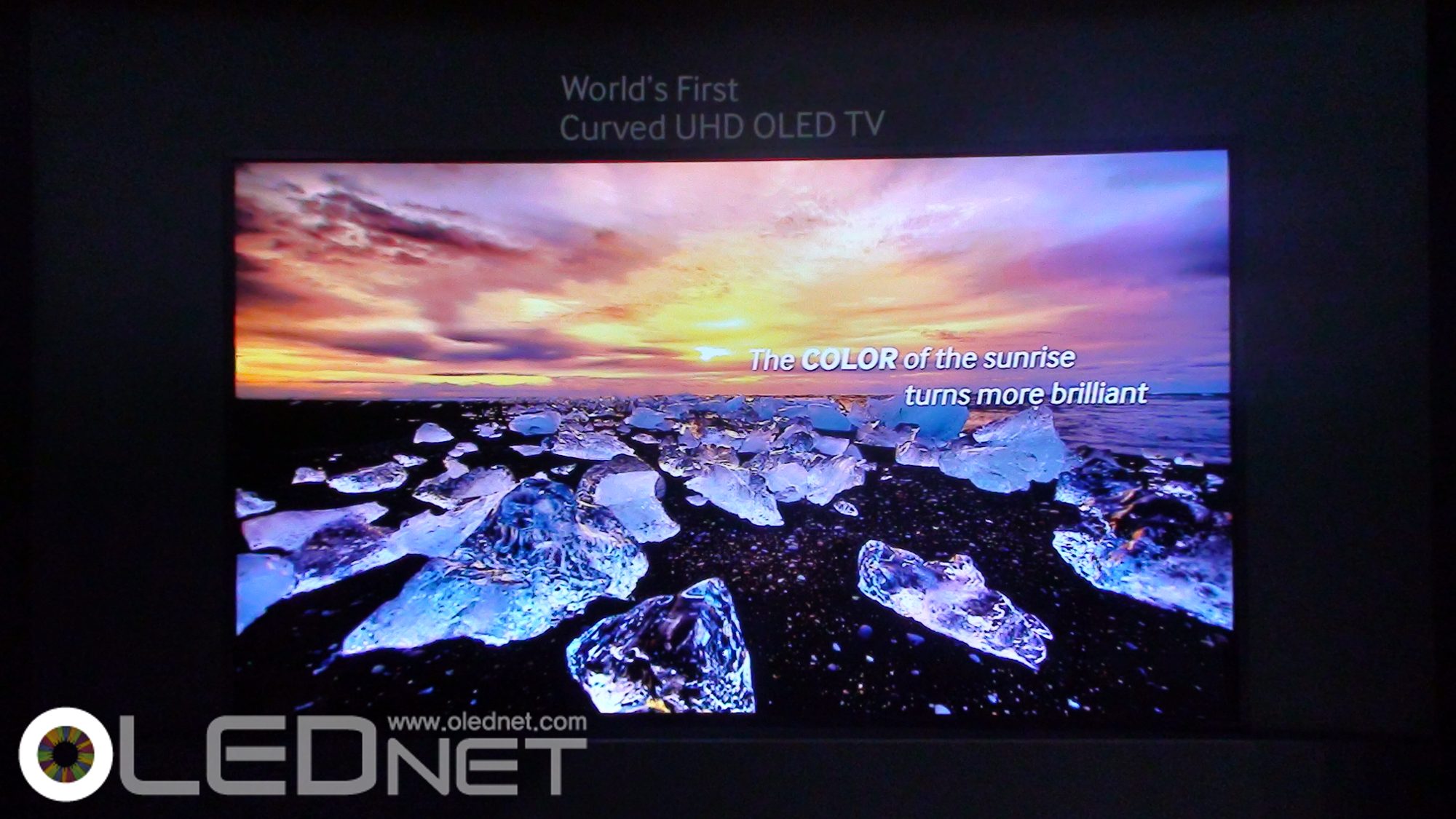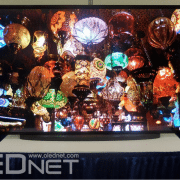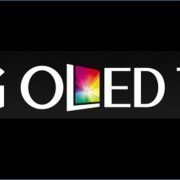글
[동영상][CES2022] LG Electronics Booth
/카테고리: OLED 비디오, 시장 /작성자: olednet2021년 65인치 프리미엄 TV 가격 동향 분석
/카테고리: 디스플레이, 포커스온 /작성자: olednet지난 2021년 65인치 기준 삼성전자의 QNED TV와 LG전자와 Sony의 OLED TV 가격을 분석하였다.
삼성전자는 4K 하이엔드 모델인 QN90A와 8K모델인 QN800A, QN900A을 시작으로 보급형 모델인 QN80A와 QN85A을 순차적으로 출시하였다. 출시가격은 4K 모델인 QN90A와 QN85A, QN80A가 각각 2,600달러와 2,200달러, 1,700달러, 8K 모델인 QN900A와 QN800A의 가격은 5,000달러와 3,500달러로 책정되었다. LG전자는 하이엔드 모델인 G1을 시작으로 보급형 모델인 A1, C1모델을 출시하였다. 출시가격은 G1와 C1, A1 모델순으로 각각 3,000달러와 2,300달러, 2,000달러였다. Sony는 XR65A80J와 XR65A90J 두 제품을 출시하였다. 출시가격은 XR65A90J는 4,000달러, XR65A80J는 2,800달러였다.
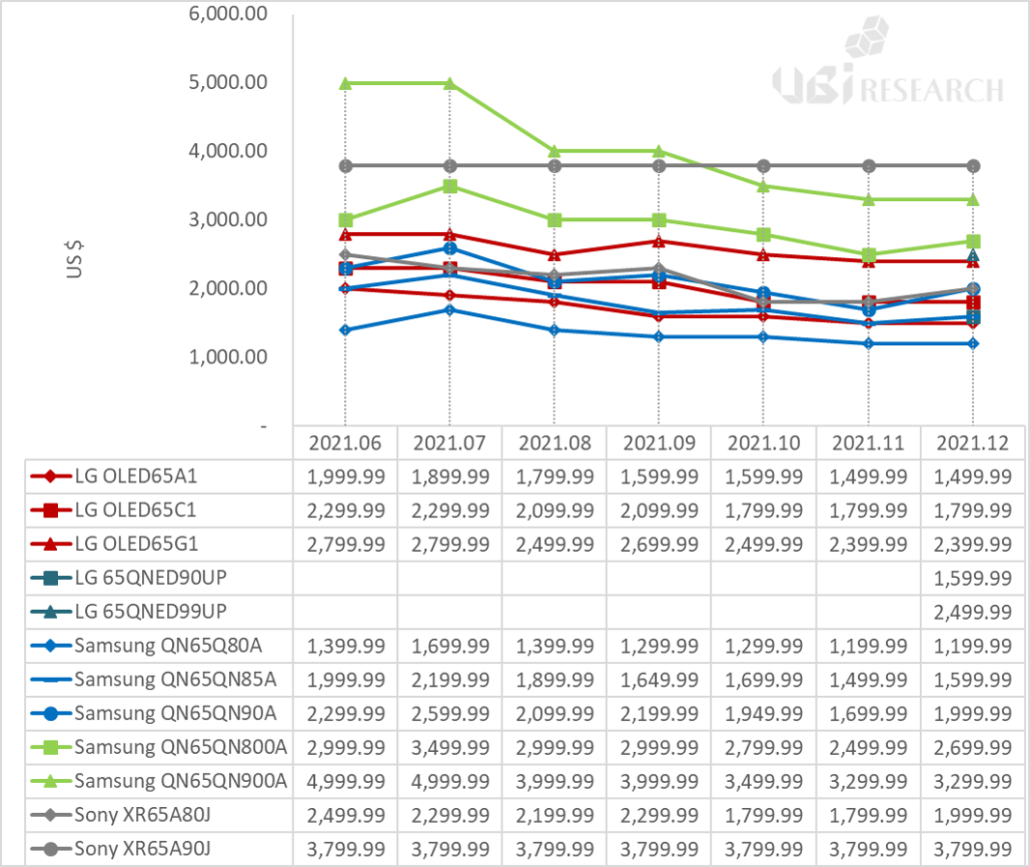
2021년에는 2020 도쿄 올림픽과 블랙프라이데이 등의 행사에 발 맞춘 업체들의 공격적인 마케팅이 눈에 띄었다.
삼성전자는 도쿄 올림픽과 블랙프라이데이로 인한 두번의 가격인하로 8K 모델인 QN900A와 QN800A가 출시 가격 대비 각각 1,700달러와 800달러 낮은 가격을 형성하고 있다. 4K 모델도 마찬가지로 90A와 85A, 80A순으로 출시 가격 대비 각각 700달러와 800달러, 500달러의 가격을 인하하며 LG전자의 동급 모델보다 평균 300달러 낮은 가격대를 형성하고 있다.
LG전자의 TV들도 마찬가지로 도쿄올림픽의 영향을 받는 6월을 시작으로 출시 가격 대비 평균 300달러의 가격 인하 마케팅을 진행하였고, 블랙프라이데이의 영향을 받는 10월부터는 평균 200달러의 가격을 낮췄다. 한편 LG전자의 8K QNED TV인 65QNED99UP 모델은 2,500달러로 위 표의 8K모델들 중 가장 저렴한 가격이었다.
끝으로 Sony의 XR65A80J모델은 11월 1,800달러로 출시 가격 대비 1,000달러까지 가격이 떨어졌으나 12월에 2,000달러까지 가격을 회복하였고 하이엔드 모델인 X65A90J는 출시 다음달 200달러의 가격 인하 이후로는 가격 변동이 없었다.
LG전자, 2019년형 77인치 OLED TV 초기가격 2018년형 대비 2,000불 인하
/카테고리: 세트, 포커스온 /작성자: olednetLG전자가 2019년형 OLED TV 라인업과 가격, 출시 일자를 공개하였으며, 77인치 모델인 OLED77C9과 OLED77W9의 초기 가격을 각각 6,999불과 12,999불로 확정하였다.
이는 2018년형 77인치 OLED TV 모델 대비 2,000불 인하한 가격으로써, LG전자가 최근 TV 시장에서 불고있는 대형 TV 구입 트렌드를 적극 활용하겠다는 전략으로 풀이된다.
LG전자가 공개한 2019년형 OLED TV 라인업은 다음과 같다.

LG전자는 조만간 88인치 OLED TV도 출시할 것으로 예상된다. LG전자의 OLED 패널 공급 업체인 LG Display는 UBI Research가 주최한 ‘2019 OLED Korea Conference’에서 premium TV 시장을 주도하기 위한 전략 중 하나로 88인치 크기의 초대형 OLED TV를 언급하기도 하였다.
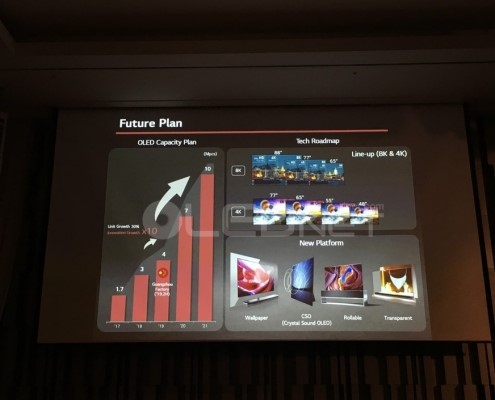
Premium TV 시장에서 OLED TV가 더 낮아진 초기 가격과 향후 출시될 88인치 모델로 더욱 더 큰 영향력을 발휘할 수 있을지 귀추가 주목된다.
[MWC 2019] 각 스마트폰 업체, 새로운 폼팩터인 ‘폴더블 폰’ 경쟁 치열
/카테고리: Exhibition, 디스플레이, 포커스온 /작성자: oled현지시간으로 2019년 2월 25일부터 29일까지 스페인 바르셀로나에서 열리고 있는 MWC 2019에서 삼성전자와 Huawei, TCL, LG전자 등, 각 스마트폰 업체들이 새로운 폼팩터인 폴더블 폰을 대대적으로 홍보를 벌이고 있다.
먼저, 삼성전자는 지난 ‘삼성 갤럭시 언팩 2019’에서 공개한 폴더블 폰인 ‘Galaxy Fold’를 대중들에게 공개하며 큰 관심을 이끌었다.
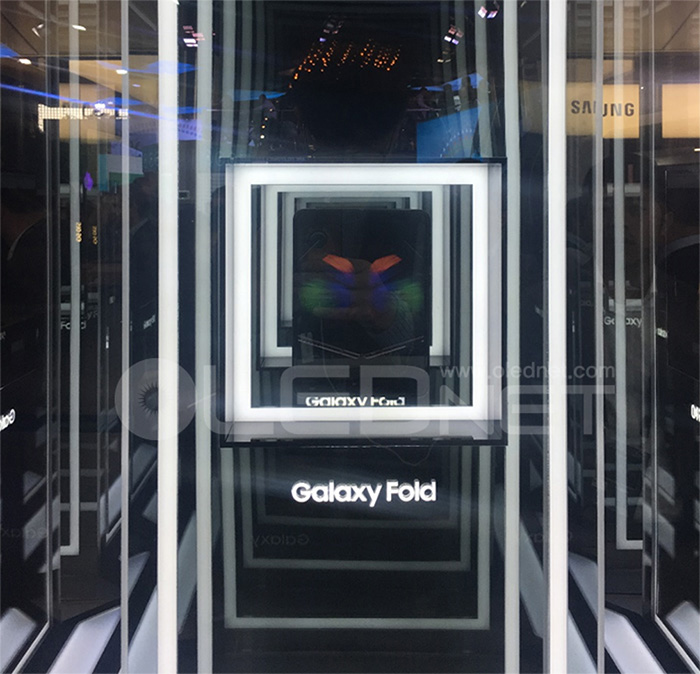
인폴딩 방식의 ‘Galaxy Fold’는 7.3인치 QXGA+ 해상도의 OLED가 적용 됐으며, 접었을 때는 4.6인치 HD+ 해상도의 OLED를 갖춘 컴팩트한 사이즈의 스마트폰으로 사용할 수 있는 것이 특징이다.
이어서, Huawei는 아웃폴딩 방식의 ‘Mate X’를 공개했다. ‘Mate X’는 전면의 6.6인치 메인 OLED와 후면의 6.38인치 OLED로 둘러 쌓여 있으며, OLED를 펼쳤을 때는 8.7인치로써 삼성전자의 ‘Galaxy Fold’보다 1.4인치가 더 크다.
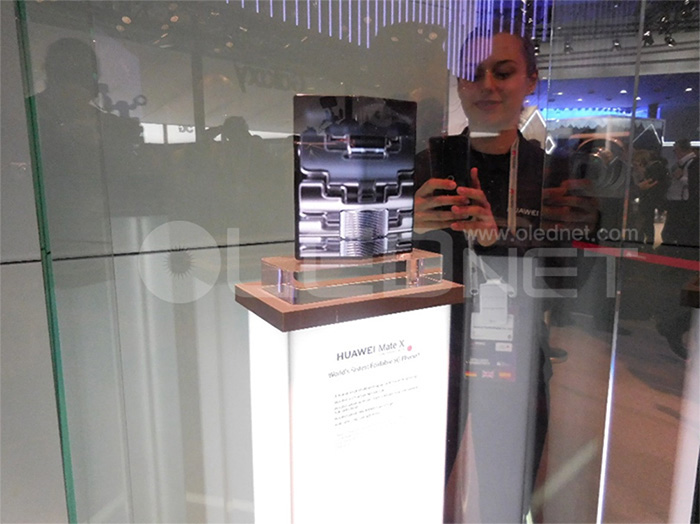
‘Mate X’의 전면 OLED는 19.5:9 화면비에 2480×1148 해상도이며, 후면 OLED는 25:9 화면비에 2480×892 해상도로써, 펼치면 8:7.1 화면비에 2480×2200 해상도가 된다.
이어서 접이식 어플리케이션에 적용 가능한 ‘DragonHinge’ 기술을 공개한 TCL도 프로토 타입의 폴더블 폰을 공개하였다. 인폴딩 방식의 7.2인치 OLED가 적용 되었으며 업체 관계자는 2021년 안에 상용화하여 시장에 출시하는 것이 목표라고 밝혔다.
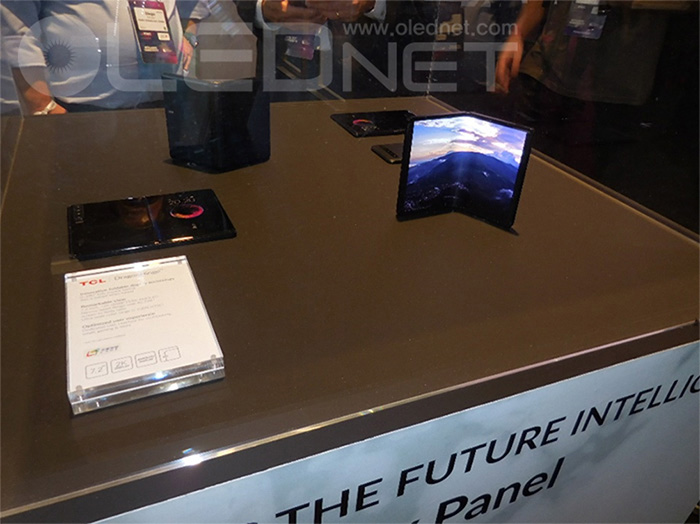
마지막으로 LG전자는 더블 폴딩 방식의 V50을 공개했다. 스마트폰에 화면 달린 커버를 붙이는 방식으로 폴더블 폰과 유사한 실용성을 구현한 V50은 멀티태스킹이나 게임 등을 손쉽게 할 수 있도록 설계되었다.
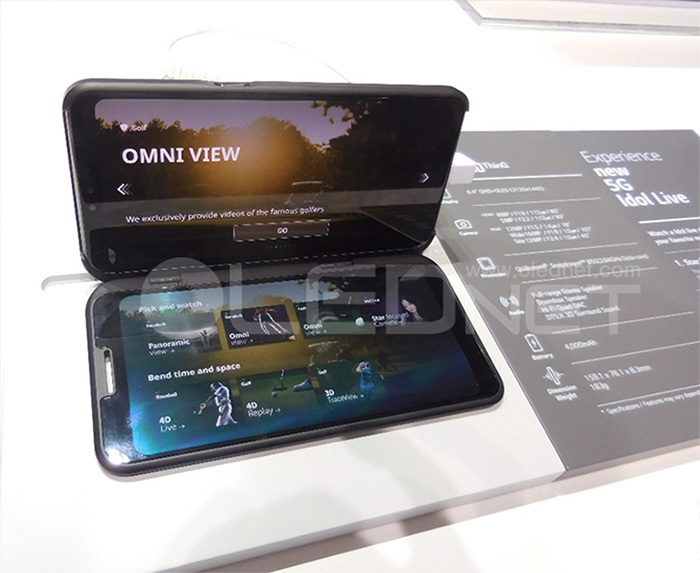
55 inch와 65 inch 프리미엄 OLED TV 가격 프리미엄 LCD TV에 근접
/카테고리: 세트, 시장, 포커스온 /작성자: olednet최근 Sony의 65 inch OLED TV인 XBR65A1E가 Best Buy 기준으로 Samsung Electronics의 QN65Q7보다 불과 US$ 300 비싼 것으로 조사되는 등 프리미엄 TV 시장에서의 OLED TV와 LCD TV의 가격 경쟁이 치열해지고 있다.
1월 16일 기준 Best Buy에서 LG Electronics의 OLED TV 중 기본 모델인 C8 시리즈와 Sony의 A1E 시리즈, Samsung Electronics의 Q7F 시리즈의 크기별 가격을 비교하였다.
 <55 inch 프리미엄 TV 가격 비교>
<55 inch 프리미엄 TV 가격 비교>
LG Electronics의 OLED55C8의 가격은 2018년 3월 대비 47% 하락한 US$ 1,700이며 이는 Samsung Electronics의 QN55Q7보다 불과 US$ 200이 비싼 가격이다.

<65 inch 프리미엄 TV 가격 비교>
최근 OLED TV 세트 업체들이 가장 많이 출시하고 있는 65 inch TV 시장에서 LG Electronics의 OLED65C8의 가격은 2018년 3월 대비 30% 하락한 US$ 2,700이며 Sony는 40% 하락한 US$ 2,500으로써, Samsung Electronics의 QN65Q7보다 각각 US$ 500, US% 300이 비싼 가격으로 가격 격차가 크게 줄어들었다.
프리미엄 TV 시장에서 OLED TV가 LCD TV 가격을 빠르게 따라잡고 있는 이유는 LG Display의 대면적 OLED 생산 수율 안정화가 가장 큰 요인으로 분석된다. LG Display는 현재 광저우에 8세대 O대면적 OLED 생산 라인을 건설 중이며 파주 10.5세대 신공장도 대면적 OLED 투자로 확정하였다. 이에 따라 대면적 OLED 생산량이 더욱 더 증가하여 프리미엄 TV 시장 내에서 OLED TV 시장 확대가 더 두드러질 전망이다.
LG OLED TV, 컨슈머리포트 선정 올해 최고의 TV 3년 연속 선정
/0 코멘트/카테고리: 세트, 포커스온 /작성자: OLEDNET미국 소비자 전문 매체인 컨슈머리포트는 최근 발표한 2018 최고의 TV에서 LG Electronics의 65인치 OLED TV인 ‘OLED65C8PUA’가 모든 제품 중 최고 제품으로 선정 됐다고 발표했다.
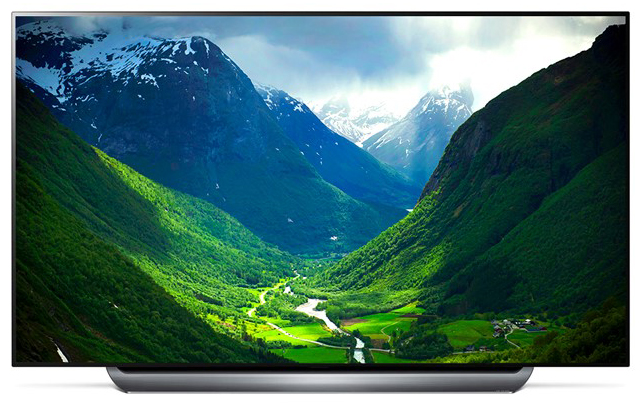
<LG Electronics의 OLED65C8PUA, Source: lg.com>
컨슈머리포트는 OLED65C8이 가격과 성능에서 훌륭한 균형을 이뤘다고 밝히며, 우수한 고화질과 UHD 성능, 무한대의 시야각 등 화질 부분의 우수성과 함께 인공지능 플랫폼인 ThinQ AI 플랫폼도 훌륭하다고 언급했다.
LG Electronics의 OLED TV 시리즈는 2016년 최고 제품으로 선정 된 이후 3년 연속 자리를 지키고 있다. 특히, 올해 출시 된 OLED TV에는 LG Electronics가 독자 개발한 화질칩인 ‘알파9’을 장착하여 노이즈를 기존대비 절반으로 줄이고 더욱 정교한 색좌표로 정확한 색을 구현 하는 등, 화질이 더욱 더 업그레이드 됐다.
한편, LG Electronics의 OLED TV는 premium TV 시장에서 경쟁력을 지속적으로 확보하며 입지를 공고히 하고 있다. LG Electronics는 지난 1분기 컨퍼런스 콜에서 HE 사업부분 1분기 실적이 매출액 4.12조원과 영업이익 5,773억원을 기록했다고 밝히며, 특히 OLED TV와 UHD TV를 중심으로 전년 대비 성장을 주도하여 영업이익률은 14.0%를 달성하였다고 언급했다.
또한, 앞으로 TV 사업을 수익성 중심으로 운영할 것이라 언급하며, 전체 TV 매출 중 OLED TV의 매출 비중이 10% 후반까지 성장할 것으로 기대했다.
LG OLED TV was selected as the best TV for 3 consecutive years.
/0 코멘트/카테고리: 미분류 /작성자: OLEDNETAt the best 2018 TV released recently by Consumer Reports, US consumer magazine, LG Electronics’ 65-inch OLED TV ‘OLED65C8PUA’ was selected as the best product among all the products.

<LG Electronics’ OLED65C8PUA, Source: lg.com>
Consumer Reports notes that the OLED65C8 has a good balance of price and performance. With the excellent quality of images including excellent high definition, UHD performance, and infinite viewing angles, it mentions that ThinQ AI platform, an artificial intelligence platform, is also excellent.
LG Electronics’ OLED TV series has remained in the first place for three consecutive years since being selected as the best product in 2016. In particular, the OLED TV released this year was upgraded to higher quality by installing ‘Alpha 9′, a proprietary image quality chip developed by LG Electronics, to reduce noise to half compared with previous models, and to achieve accurate colors with more sophisticated color coordinates.
On the other hand, LG Electronics’ OLED TV continues to secure its position in the premium TV market. LG Electronics announced at the conference call held on April, 26th that the sales revenue and operating profit of its HE (Home Entertainment) business division were recorded KRW 4.12 trillion and KRW W577.3 billion, respectively in the first quarter of 2018. In particular, OLED TVs and UHD TVs led the growth. The operating margin reached 14.0%.
According to LG Electronics, it will continue to operate TV business with profitability. The proportion of OLED TV sales is expected to grow from 10 percent last year to mid 10% ~20% of the total TV sales this year.
LG Electronics expect OLED TV sales portion to grow to mid 10% ~ 20% of total TV sales this year
/0 코멘트/카테고리: 미분류 /작성자: OLEDNETLG Electronics announced at the conference call held on April, 26th that the sales revenue and operating profit of its HE (Home Entertainment) business division were recorded KRW 4.12 trillion and KRW W577.3 billion, respectively in the first quarter of 2018. The sales declined due to the seasonal weakness, compared with the previous quarter, but grew 7.4% YoY. In particular, OLED TVs and UHD TVs led the growth. Operating profit grew 76.5% YoY thanks to the continued premium product sales growth, material cost drop, and improved cost structure. The operating margin reached 14.0%, which is the first time that the HE division has achieved a double-digit OP margin. As for the second quarter forecast, LG Electronics said, “We expect TV demand to increase slightly compared to the same period of last year due to the impact of sports events on the market. In particular, the rapid growth of the premium TV market is expected to continue.”
LG Electronics also mentioned “With the plan for sales growth to be continued by responding timely to the demand for additional sports events, and strengthening sales of new products, we are going to maintain sound profit structure by increasing sales of OLED TVs and UHD TVs and enhancing cost competitiveness.”
Ha Jin-Ho, Senior Vice President of HE Division, LG Electronics said “ Achieving 14% operating profit in the 1st quarter, 2018 means that we have strengthened our brand centered on value, with no more volume sales.’’ OLED TV has brought synergistic effects, and we will continue to operate TV business with profitability. The proportion of OLED TV sales is expected to grow from 10 percent last year to mid 10% ~20% of the total TV sales this year.” he added.
LG전자, 올해 OLED TV 매출 비중 10% 후반까지 성장 기대
/0 코멘트/카테고리: 시장, 포커스온 /작성자: OLEDNETLG전자가 4월 26일 진행된 2018년 1분기 컨퍼런스 콜을 통해 HE 사업부분 1분기 실적은 매출액 4.12조원, 영업이익 5,773억원을 기록했다고 밝혔다. 매출액은 계절적 비수기 진입 영향으로 전분기 대비 감소하였지만, 전년 동기 대비는 7.4% 성장하였다. 특히, OLED TV와 UHD TV를 중심으로 전년 대비 성장을 주도하였다.
영업이익은 지속적인 프리미엄 제품 판매 확대와 재료비 하락, 원가 구조가 개선되면서 전년 동기 대비 76.5% 증가했다. 영업이익률은 14.0%를 달성하였으며, HE 사업본부가 두 자릿수의 영업이익률을 낸 것은 이번이 처음이다.
2분기 전망에 대해서 LG전자는 “시장 측면에서 스포츠 이벤트 영향으로 TV 수요는 전년 동기 대비 다소 늘어날 것으로 전망하고 있으며, 특히 프리미엄 TV 시장의 빠른 성장세는 지속 유지될 것으로 예상된다”고 밝혔다.
이에 LG전자에서는 “스포츠 이벤트 추가 수요에 적기 대응하고, 신제품 판매 활동을 강화하여 전년 대비 매출 성장세를 지속해 나가고, OLED TV와 UHD TV의 매출 확대와 꾸준한 원가 경쟁력 제고를 통해 건전한 수익 구조를 유지해 나갈 계획”이라고 밝혔다.
LG전자 HE본부 하진호 전무는 “올해 HE 사업부분에서 영업이익률 14%를 달성한 것은 volume 게임을 지양하고, 프리미엄 제품의 value 중심으로 브랜드를 강화하고 있는 것”이라며 “이에 OLED TV가 작용해서 상승 효과를 보고 있는 것이고, 앞으로도 TV 사업을 수익성 중심으로 운영할 것”이라고 전했다. 또한, “전체 TV 매출 중OLED의 매출 비중은 작년 10%에서 올해는 10% 후반까지 성장할 것으로 기대한다”고 전했다.
2018 MWC- Release of LG Electronics’ V30S model, postponing announcement of new smart phone
/0 코멘트/카테고리: 미분류 /작성자: OLEDNET
LG Electronics released some of its stance, through 2018 MWC, on upgrading the entire mobile lineup, which led to lots of curiosities by the various related articles.
According to the exhibitors, the company will try various strategies from this year and will not necessarily follow its competitors in launching new models. In terms of the overall model reorganization of the G series and the V series, it has decided to concentrate on the essence of the phone for the time being rather than making a big change. With regard to the V30S’s release, it is said that V30S is different from V30 in terms of taking bright and clear pictures in the dark place by improving the illumination including AI application to the camera modules, and the enhancement of the stereo system. Also, V30 users might be able to experience soon the same performance as V30S through software upgrade.
Though it was not revealed at this MWC exhibition, the new premium mobile model to be launched this year will adopt the ‘ ThinQ AI’. It was announced that the new model was released after the V30 in a separate private booth; however, the release time has not yet been confirmed.
Regarding 5G, which is one of the biggest trends in this exhibition, North America and other regions are rapidly moving, and LG Electronics has also been working hard on this inclusive of the development of foldable smart phone.
Unlike last year’s show with various watch models, LG Electronics’ MWC booth is a little reduced as it seems to prepare for the next. The V30S is the only OLED display product, and most of the exhibits highlighted the enhanced performances of the V30S, such as the experience of a Hi-Fi QUAD stereo system through wearing a headset and the experience of a camera’s Bright Mode in the darkroom. In addition, the K10 (K10, K10 + – 5.3 inch HD) series, which are entry level models, has been released through this exhibition.
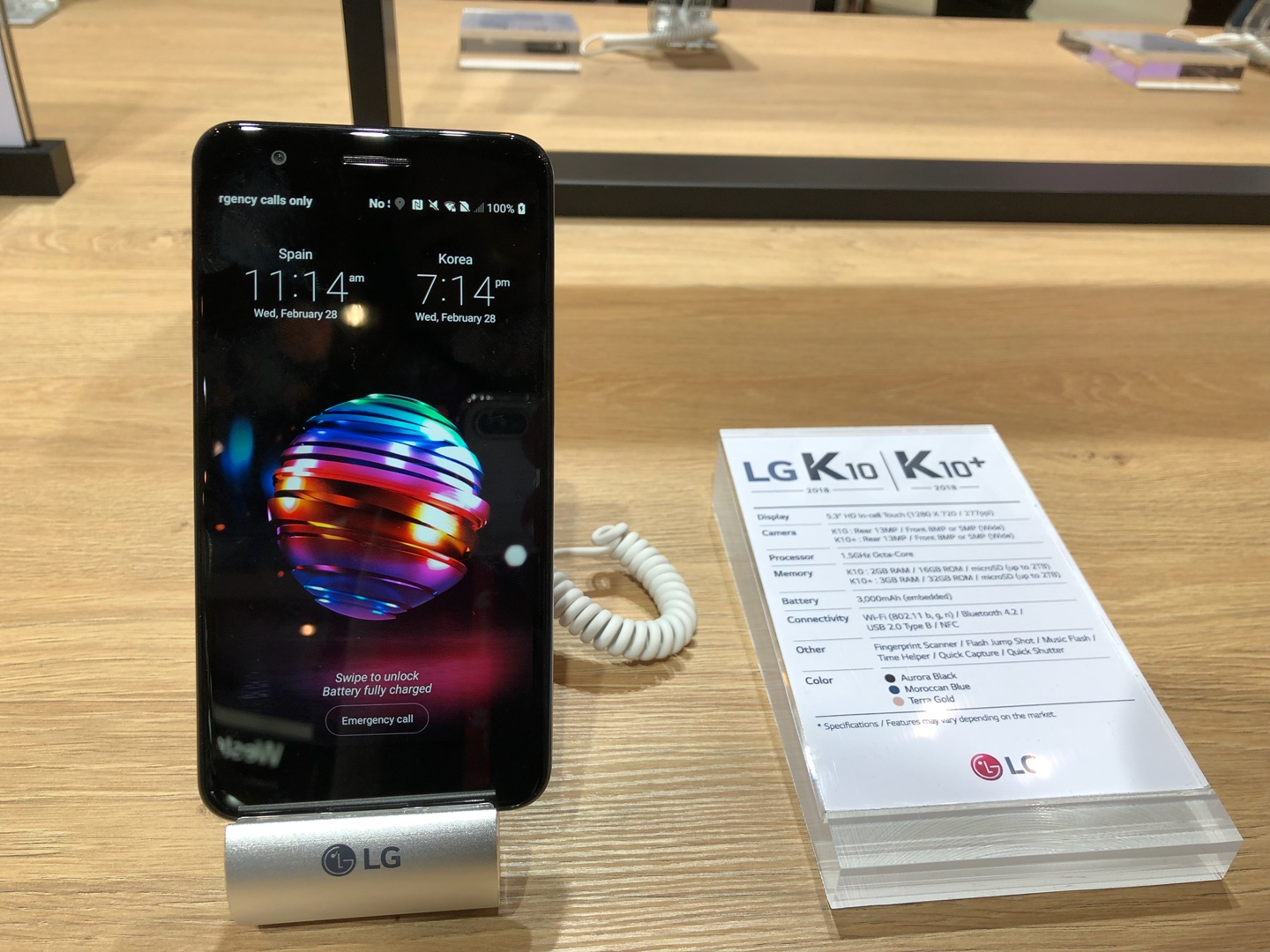
2018 MWC- LG전자 신규 스마트폰 발표 미루고 V30S 모델 공개
/0 코멘트/카테고리: Exhibition, 포커스온 /작성자: OLEDNET
LG전자는 2018 MWC를 통해 그간 다양한 기사들로 궁금증을 자아내게 했던 전면적인 모바일 라인업 업그레이드에 대한 입장을 일부 공개했다.
전시 관계자에 따르면 올해부터는 전략을 다양하게 시도할 것이며 신모델 출시에 관련해 꼭 경쟁사를 따라가지는 않을 것이라고 했다. G시리즈와 V시리즈의 전체적인 모델 개편과 관련해서도 당분간 큰 변화를 주기 보다는 폰의 본질에 집중하고자 한다고 마무리 했다. 또한 V30S의 공개와 관련해 V30와 다른 점은 카메라에 AI가 적용을 비롯한 조도개선을 통한 어두운 곳에서 밝고 선명한 사진을 찍는 점과 스테레오 시스템의 향상 정도라고 밝혔으며, V30 사용자는 조만간 소프트웨어 업그레이드를 통해 동일한 성능을 경험할 수 있을 것이라고 전달했다.
이번 MWC 전시에는 공개하지 않았지만 올해 나올 신규 프리미엄 모바일 모델에도 씽큐AI가 적용될 예정이라고 했다. 별도 프라이빗 부스에서 V30뒤를 이을 해당 신모델을 공개한 것으로 알려졌으며 출시 시기는 아직 확정되지 않았다.
이번 전시장 가장 큰 트렌드중 하나인 5G와 관련해서도 북미등 지역에서 빠르게 움직이고 있는 것으로 파악하고 있으며 LG전자 역시 폴더블 폰 기술개발과 더불어 내부에서 열심히 준비하고 있음을 내비쳤다.
지난해 다양한 시계모델을 전시한 것과 달리 LG전자의 이번 MWC 부스는 다음을 준비하는 것처럼 약간 축소된 분위기다. OLED 디스플레이 적용 제품은 V30S가 유일하며 대부분의 전시가 헤드셋 착용을 통한 Hi-Fi QUAD스테레오 시스템체험, 암실에서의 카메라Bright Mode체험등 V30S의 향상된 성능 하나하나를 강조하는 전시에서 그쳤다. 이밖에 이번 전시를 통해 보급형 모델인 K10(K10, K10+ – 5.3인치 HD)시리즈를 공개하였다.

Full screen OLED Smart phone, becomes a new trend in Smart phones.
/0 코멘트/카테고리: 미분류 /작성자: OLEDNETAs smartphone specs and designs have been leveled up, smartphone makers are pursuing differentiation through display. In particular, full screen OLED smartphones, which have the largest screen size in the limited smartphone size by applying OLED, are becoming a new trend in the smartphone market.
In the first half of 2017, Samsung Electronics introduced full-screen Galaxy S8 and Galaxy S + with OLED and home button removed. In the second half of 2017, full-screen OLED smartphones began to be launched in 2017, with Apple, LG Electronics, and Chinese smartphone set makers lining up to launch OLED-enabled full-screen smartphones. Thus, in 2017, full-screen OLED smartphones began to be launched in earnest.
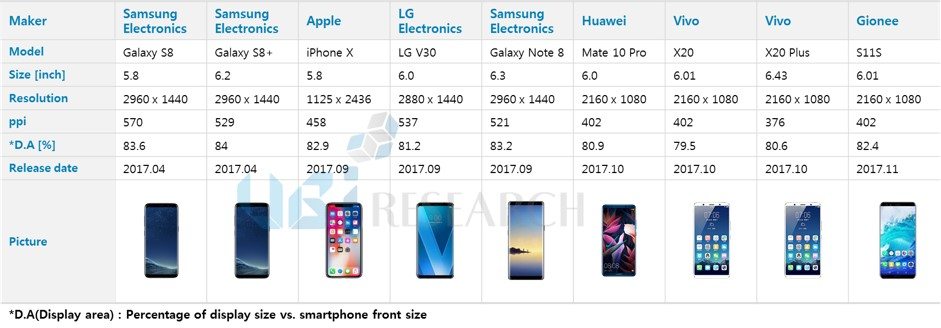
<Major full-screen OLED smartphones released in 2017>
There are fifteen full screen smartphones with OLED applied in 2017, with two new products in 1Q, four new products in 3Q and nine new products in 4Q. Samsung Electronics, Apple, and LG Electronics released full-screen OLED smartphones in 3Q 2017, and Chinese smartphone makers such as Huawei, Gionee and Vivo introduced full-screen OLED smartphones in 4Q 2017.
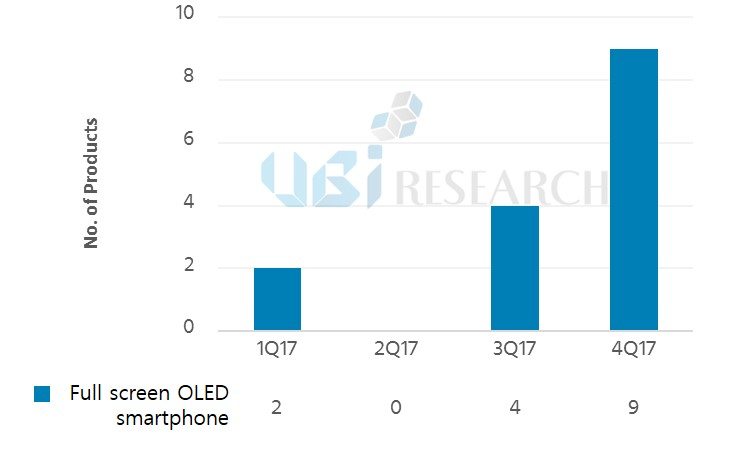
<Number of full-screen OLED smartphones released in 2017 by quarter>
In 2018, more full-screen OLED smartphones are expected to be released than in 2017. Three full-screen OLED smartphones were already launched in January 2018, including Samsung Electronics’ Galaxy A8, and at least two full-screen OLED smartphones are to be launched in February.
According to the ‘2017 Flexible OLED Annual Report’ published by UBI Research in December 2017, full-screen flexible OLED is expected to lead the flexible OLED market with an average market share of 79% by 2022. There is a growing interest in the spread of full-screen OLED smartphones, which has become a new trend for smartphones.
Full screen OLED 스마트폰, 스마트폰의 새로운 트렌드가 되다.
/0 코멘트/카테고리: 디스플레이, 포커스온 /작성자: OLEDNET최근 스마트폰의 사양과 디자인이 상향 평준화 되면서 스마트폰 업체들은 디스플레이를 통한 차별화 전략을 펼치고 있다. 특히, OLED를 적용하여 제한 된 스마트폰 사이즈에서 최대로 큰 화면을 구현한 full screen OLED 스마트폰은 스마트폰 시장에서 새로운 트렌드로 자리잡고 있다.
2017년 상반기에 Samsung Electronics는 OLED를 적용하고 홈 버튼이 제거 된 full screen 형태의 Galaxy S8와 Galaxy S+를 출시하였다. 이 후 2017년 하반기 들어 Apple과 LG Electronics, 중국 스마트폰 세트 업체들이 줄지어 OLED가 적용 된 full screen 형태의 스마트폰을 출시하는 등, 2017년에 본격적으로 full screen OLED 스마트폰이 출시되기 시작하였다.
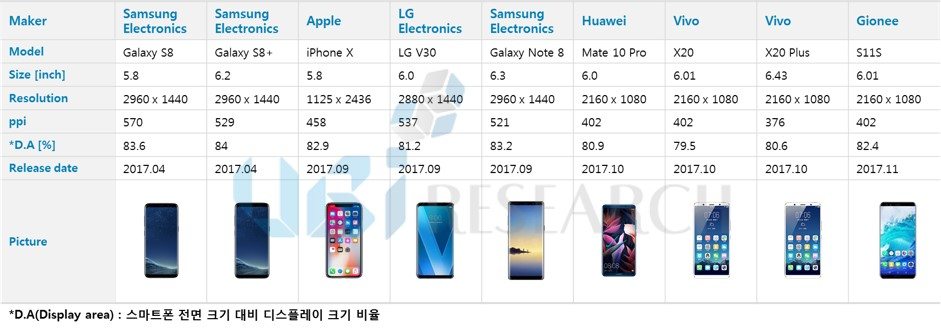
<2017년 출시 된 주요 full screen OLED 스마트폰>
2017년 OLED가 적용 된 full screen 스마트폰은 총 15종이며, 분기별로는 1분기에 2종, 3분기에 4종, 4분기에 9종이 출시되었다. 3분기까지 Samsung Electronics와 Apple, LG Electronics가 full screen OLED 스마트폰을 출시했다고 한다면, 4분기에는 Huawei와 Gionee, Vivo 등 중국 스마트폰 업체에서 주로 full screen OLED 스마트폰을 출시하였다.
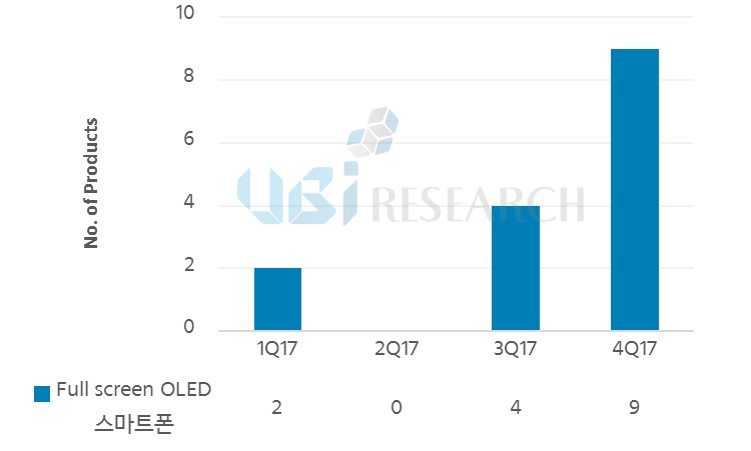
<2017년 분기별 full screen OLED 스마트폰 출시수>
2018년에는 2017년보다 더욱 더 많은 full screen OLED가 출시 될 것으로 예상된다. 2018년 1월에는 Samsung Electronics의 Galaxy A8을 포함하여 3종의 full screen OLED 스마트폰이 출시 되었으며, 2월에도 최소 2종 이상의 full screen OLED 스마트폰이 출시 될 예정이다.
또한 유비리서치가 2017년 12월에 발간한 ‘2017 Flexible OLED Annual Report’에 따르면, full screen 형태의 flexible OLED는 2022년까지 평균 79%의 시장점유율로 flexible OLED 시장을 주도할 것으로 전망하는 등, 스마트폰의 새로운 트렌드가 된 full screen OLED 스마트폰의 확산세에 관심이 집중되고 있다.
LG전자, OLED TV 출하량 2020년 500만대 이상 확대
/0 코멘트/카테고리: 시장, 포커스온 /작성자: OLEDNETLG전자는 25일 진행된 2017년 4분기 경영실적 컨퍼런스 콜을 통해 ‘TV 시장의 성수기 수요와 프리미엄 TV 판매에 따라 HE(home entertainment) 사업본부의 매출이 전년동기 대비 10% 이상 증가하였다’고 밝혔다.
2018년 연간 전망에 대해서는 ‘환율 변동과 같은 외부환경 리스크는 여전히 존재하지만, 스포츠 이벤트로 글로벌 TV시장이 증가할 것이다’고 덧붙였다.
이에 따라 HE 사업본부는 프리미엄 TV 중심의 마케팅을 펼쳐 매출 성장을 이룸과 동시에 지속적인 원가 개선 활동으로 안정적인 수익 구조를 유지해 나갈 예정이다.
OLED TV 출하량이 500만대를 돌파하는 시점을 묻는 질문에 ‘2017년 OLED TV 출하량이 2016년 대비 2배 증가하였고, 2018년에도 비슷한 수준의 판매 증가를 예상하고 있다’며, ‘이러한 기조가 지속된다면 그 시점은 2020년이 될 것이다’고 말했다.
이어 출하량 보다 TV 시장에서 OLED TV가 프리미엄 위치를 확고히 갖으며, OLED TV 비중을 얼마나 확보할 것인지가 더 중요하다고 강조했다.
한편, MC(mobile Communication) 사업본부는 지난 4분기 OLED를 탑재한 프리미엄 스마트폰 LG V30를 출시함에 따라 매출액이 전분기 대비 9% 성장하여 3조 655억원을 달성하였음에도 메모리 등 스마트폰 주요 부품 단가 상승과 마케팅 비용 증가로 인해 2,132억원의 영업손실을 기록했다.
이러한 영업손실을 극복하기 위해 MC 사업본부는 제품의 완성도와 신뢰성을 높이는 전략을 펼쳐고객의 만족도를 높일 예정이다.
MC 사업본부는 ‘차기전략 모델은 경쟁사의 출시 시기를 쫓기보다 경쟁력을 확보한 후 충분한 준비가 됐다 판단했을 때, 상반기 이내로 공개할 것이다’ 밝혔다.
또한, 차기전략 모델에는 LG전자의 강점인 AI기능과 오디오, 카메라 기능 등을 강화할 것이라 덧붙였다. 차기전략 모델이 출시하기 전까지는 LG V30과 G6의 업그레이드 버전과 중저가 모델을 지속적으로 출시함과 동시에 LG전자만의 차별화된 플랫폼으로 원가절감을 하여 매출 손실을 최소화하겠다고 설명했다.
LG Electronics Will Expand OLED TV Shipments to More Than 5 Million Units by 2020
/0 코멘트/카테고리: 미분류 /작성자: OLEDNETLG Electronics announced through its Q4 2017 earnings conference call, the sales of HE (Home Entertainment) Division increased by more than 10% compared to the same period of last year due to the demand for high-demand season of TV market and the sales of premium TV.
Regarding the 2018 forecast, “there are still external environmental risks such as exchange rate fluctuations, but the global TV market will increase with sporting events”, they added.
As a result, the HE Division will pursue sales growth through marketing centered on premium TVs while maintaining a stable profit structure through continuous cost-cutting activities.
They answered to the question when OLED TV shipments exceed 5 million units, “OLED TV shipments in 2017 were doubled compared to 2016 and the sales are expected to rise at a similar level in 2018”. And, “if this trend continues, that point will be 2020″, they said.
They also emphasized that it is more important for OLED TVs to have a premium position in the TV market rather than shipments, and how much they will secure OLED TVs.
On the other hand, the sales of MC(mobile communication) Division increased 9% QoQ to KRW3.655 trillion thanks to the release of LG V30, a premium smartphone equipped with OLED, in the fourth quarter of last year. However, the division posted an operating loss of KRW213.2 billion due to increased costs of smartphone major parts such as memory and marketing expenses.
In order to overcome these operating losses, MC Division plans to increase customer satisfaction by implementing the strategies that enhance product completeness and reliability.
The MC Division said, “We will release the next strategy model within the first half of the year when it is deemed to be ready enough after securing its competitiveness rather than pursuing the timing of competitors.”
In addition, the next strategic model will strengthen AI function, audio and camera functions, which are the strengths of LG Electronics. Until the next strategic model is launched, we will continue to release upgraded and mid-priced models of LG V30 and G6. At the same time, we will minimize sales losses by reducing costs with our unique platform.
[CES 2018] OLED TV in 17 Types to be Displayed Compared to 2017, and OLED Manufacturers to be Expanded Further
/0 코멘트/카테고리: 미분류 /작성자: Hana OhBy Hana Oh (hanaoh@ubiresearch.com)
The number of OLED TVs exhibited at CES 2018 increased to 31, which was a significant increase of 17 from CES 2017. The number of OLED TV companies that exhibited at CES 2018 were 7 including LG Electronics, Sony, Panasonic and Skyworth.
At CES 2018, OLED TVs were exhibited with 6 for 55-inch, 19 for 65-inch, and 6 for 77-inch. 65-inch OLED TVs were most on display, and it was noticeable that many companies were focusing on 65-inch OLED TV products. 77-inch OLED TVs in 6 types same as 55-inch were exhibited so that it was found to be included in the main lineup.
In addition, the display resolution of all OLED TVs was UHD because UHD products were mainly displayed according to consumers’ demand for high-definition TV. OLED TVs with FHD resolution had been exhibited until 2015, and only OLED TVs with UHD resolution have been on display since 2016.
Meanwhile, LG Display’s Vice Chairman Han Sang-beom said, “We will raise the sales portion of OLEDs to 40% of total sales by 2020” in a press conference on 8th local time, which implied that OLED TV market will be more expanded.
In addition, Vice Chairman Han Sang-beom said that two major Chinese companies will join the OLED market. As a result, the number of OLED manufacturers will grow from 13 to 15, including LG Electronics, Sony and Panasonic so that the OLED companies are expected to be expanded further.
OLED TV, which is currently leading the premium TV market, is expected to see a bigger rise.
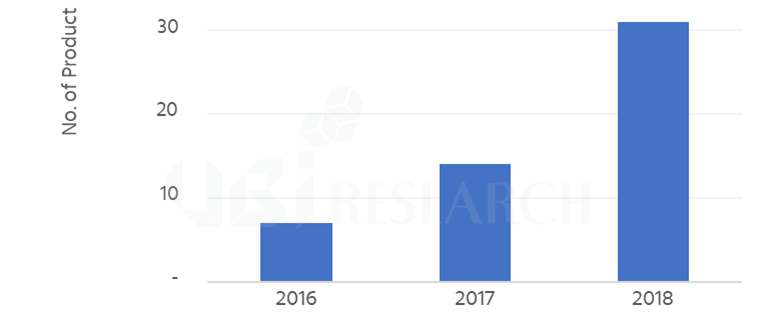
[CES 2018] 2017년 대비 전시 된 OLED TV 17종 증가, OLED 진영 더욱 더 확대 기대
/0 코멘트/카테고리: Exhibition, 포커스온 /작성자: OLEDNETBy Hana Oh (hanaoh@ubiresearch.com)
CES 2018에서 전시 된 OLED TV가 CES 2017년 대비 17종이 늘어난 31종이 전시되며 제품수가 대폭 확대되었다. OLED TV를 전시한 업체는 LG Electronics와 Sony, Panasonic, Skyworth 등 총 7개 업체다.
CES 2018에서 OLED TV는 55 inch가 6종, 65 inch가 19종, 77 inch가 6종이 전시 되었다. 65 inch OLED TV가 가장 많이 전시되며 다수의 업체들이 65 inch OLED TV 제품을 주력으로 하고 있다는 것을 확인 할 수 있었으며, 77 inch OLED TV도 55 inch와 같은 6종이 출시되며 주요 라인업에 포함되고 있음을 알 수 있었다.
또한, 전시 된 OLED TV의 해상도는 모두 UHD로써 소비자들의 고화질 TV 요구에 따라 UHD 제품 위주로 전시된 것으로 파악된다. FHD 해상도의 OLED TV는 2015년까지 전시되었으며 2016년부터 UHD 해상도의 OLED TV만 전시되었다.
한편, 앞서 LG Display의 한상범 부회장은 현지시간으로 8일에 가진 기자간담회에서 “2020년까지 전체 매출에서 OLED가 차지하는 매출 비중을 최대 40%로 끌어올리겠다”고 밝히며 OLED TV 시장이 더욱 더 확대 될 것임을 암시하였다.
또한, 한상범 부회장은 중국 주요업체 2 곳이 OLED 진영에 합류할 예정이라고 언급했다. 이로써 OLED 진영으로는 LG Electronic와 Sony, Panasonic 등 기존 13개 업체에서 15개 업체로 늘어나 OLED 진영이 더욱 더 확대 될 예정이다.
현재 Premium TV 시장을 주도하고 있는 OLED TV의 더욱 더 큰 상승세가 기대된다.
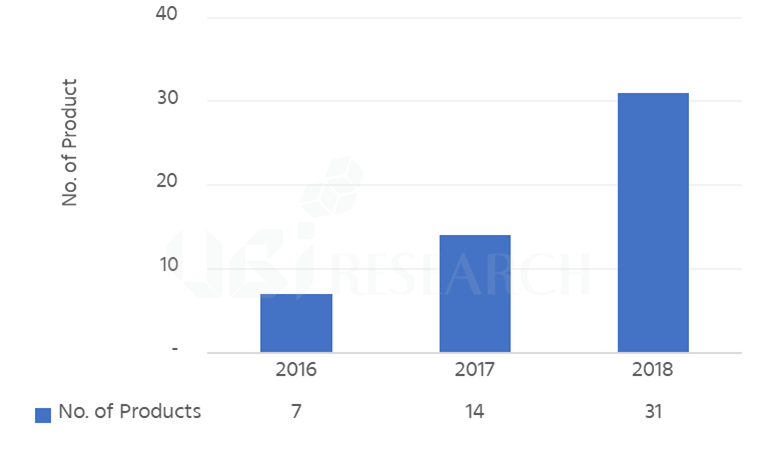
[CES 2018] 이제는 Connected의 시대
/0 코멘트/카테고리: Exhibition, 포커스온 /작성자: OLEDNETBy Hana Oh (hanaoh@ubiresearch.com)
2018 CES 수많은 전시들 중 가장 많은 업체들의 테마는 “연결”이다. 앞으로는 집안과 밖의 TV와 세탁기, 냉장고, 자동차 등 수많은 가전제품들과 전자제품들이 사람들과 연결되고 인공지능으로 동작한다.
LG Electronics와 Samsung Electronics 등 많은 세트업체들은 올해 CES를 통해 전자제품의 단독기능을 넘어서 연결과 융합을 통해 사용자와 연결되어 있고 전자제품의 사용이 곧 사용자의 “Life Style”임을 강조하는 전시들을 선보였다. 새롭게 선보이는 LG Electronics의 ThinQ, 브랜드에서부터, Samsung Electronics의 커넥티드 시티와 폰과 가전제품의 연결을 통한 라이프 스타일의 제시, Intel의 AI가 적용된 다양한 어플리케이션, 그리고 자율주행 자동차에까지 “연결”과 “확장”을 통해 새로운 시대의 커뮤니케이션방법을 보여준다.
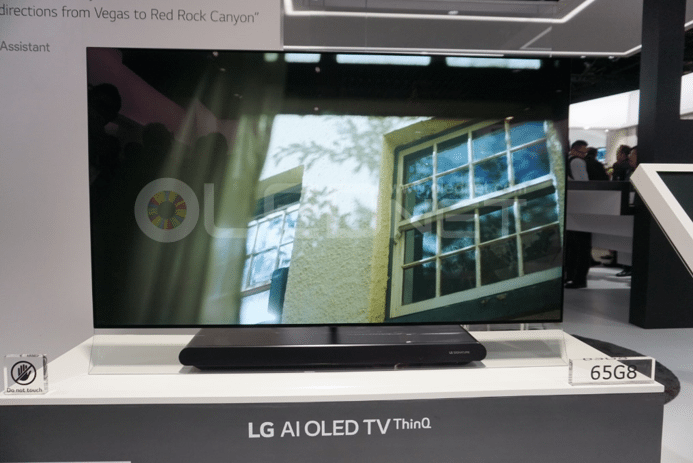
<LG Electonics의 ThinQ>
이러한 전자제품들의 “Connected”를 더욱 용이하게 하고 가능하게 하기 위해서 디스플레이는 변화한다. 과거 디스플레이가 단순히 영상을 내보내는 기능을 위주로 인식되었다면, 이제는 “Communication”의 도구로서의 역할을 한다. 디스플레이를 통해 사용자를 인식하고 단순 정보의 출력에서 AI를 통한 정보의 선택과 올바른 정보의 인식까지 확장되어 디스플레이가 없는 “Connected”는 불완전한 모습이다.
OLED는 flexibility를 통한 제품 디자인 적용의 자유로움과 색상표현의 우수성으로 TV와 모바일 뿐만 아니라 자동차를 포함한 다양한 전자제품에 적용되어 향후 5G와 인공지능(AI)의 확장에 유리하게 적용될 것으로 기대된다.
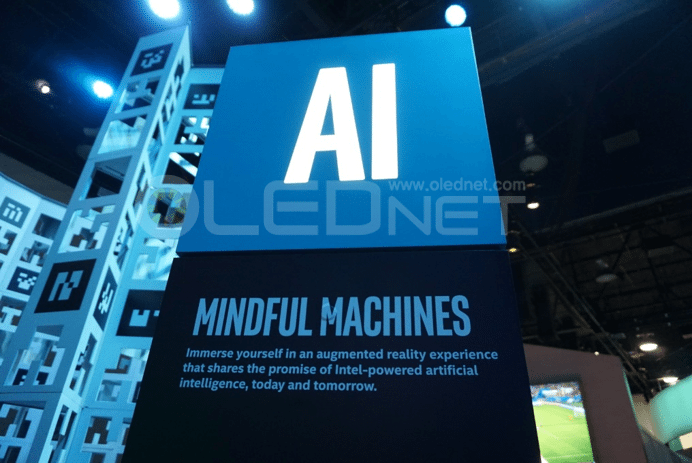
<Intel의 AI>
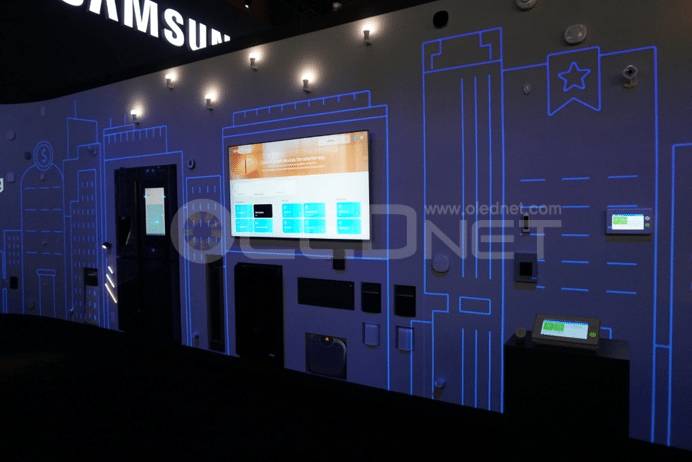
<Samsung Electronics의 connected city>
[CES 2018] This is the era of “Connected”
/0 코멘트/카테고리: 미분류 /작성자: Hana OhBy Hana Oh (hanaoh@ubiresearch.com)
“Connected” is the theme of largest number of exhibitors participating in 2018 CES. In the future, home appliances and electronic goods such as TV, washing machine, refrigerator, and automobiles will be connected to people and operated with artificial intelligence (AI).
CES 2018 is a chance for many set-makers, including LG Electronics and Samsung Electronics, to highlight both that electronic goods are connected with users as it is connected and converged going beyond single primary function and using electronic good equals to the user’s “life style”. “Connect” and “Expansion” is a way for many companies to show how they communicate with the upcoming new era: LG electronics launches new brand of Thin Q, Samsung Electronics suggests connected city phone and life style through connection of phones with consumer electronics, and Intel displays AI-applied applications, and autonomous cars.

<“ThinQ” of LG Electonics >
Now, display is changing in order to facilitate and enable the “Connectedness” of these electronic devices. If display was simply recognized as image projection in the past, now it becomes a tool of “Communications”. “Connected” without display seems incomplete as it recognizes the user through display and extend from information output to information selection and recognition of correct information.
OLED is expected to apply to 5G and AI favorably as it is applied to diverse electronic products including TV, mobile devices and automobiles thanks to flexibility of product design and superior color presentation.

<’AI’ of Intel>

< ‘connected city’ of Samsung Electronics>
[CES 2018] OLED TV exhibition from major set manufacturers
/0 코멘트/카테고리: 미분류 /작성자: OLEDNETOn 8 January 2018, the largest electronic show is held at Enclave Convention Center in Las Vegas, United States.
Major electronic companies such as LG Electronics, Sony, Vestel, Changhong, Skyworth presented OLED TV as main exhibition. In particular, Samsung Electronics’ “Micro LED” exhibition received a great deal of attention. Samsung Electronics unveiled the world’s first “micro LED” technology-applied 146-inch modular TV, “The Wall.” People came to see the product and it was heated up in a hot issue. Samsung Electronics emphasized that this product is a future screen that is unlimited in image quality, size and form. Through the implementation of the local dimming 3000, “The Wall”, which was unveiled at the exhibition show is developed by brightness, contrast ratio, color reproduction and black display compared to the existing display.
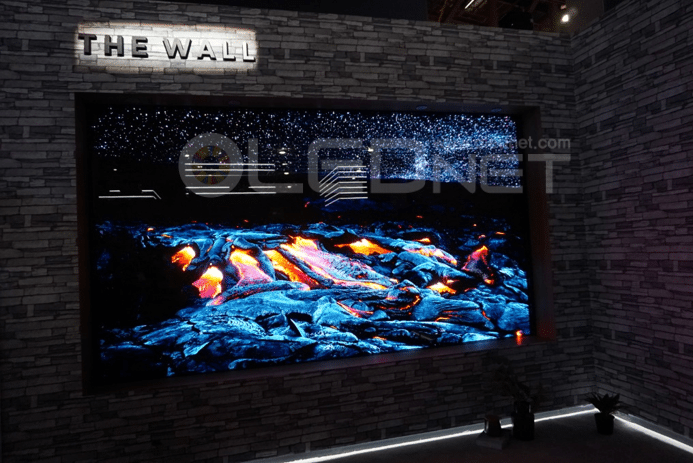
<‘Micro LED TV ‘The Wall’ of Samsung Electronics’>
Especially, the existing “Mini LED” products were exhibited along with “The Wall” for comparison of exhibition. And the excellence of “Micro LED” was outstanding. “Mini LED” products was little far from the large display as pixels and the lines of each module were shown on the screen.
LG Electronics, Sony, Changhong and other companies presented 65-inch and 77-inch OLED TV display products including Sound Acoustic OLED TV products. In particular, Konka reflected the trend that TV is a part of furniture, not just electronic products and it consists of a set design that took advantages of Chinese traditional atmosphere.
In addition, many set manufacturers have demonstrated the advantages of OLED TV, which is the lightest and thinnest through “Wall Paper TV” and “Slim” concepts.

<A8F Bravia OLED TV of Sony>
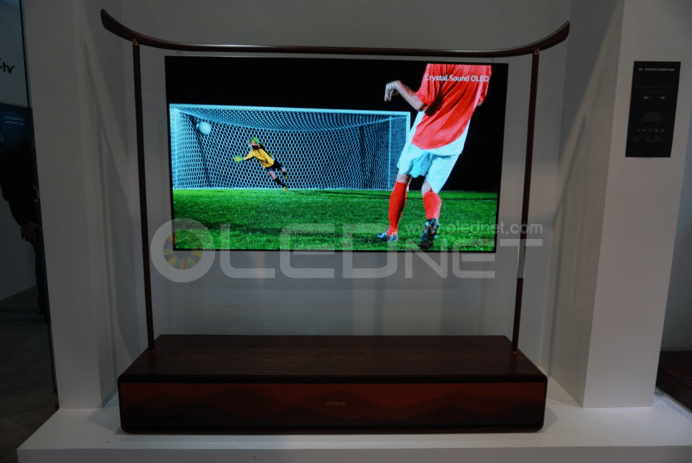
<OLED TV of Kongka>
‘TCL’, which occupies a side of QLED TV showed more advanced QLED TV in image quality and color reproduction range. According to the person in charge of TCL, QD dominated the portion of the current market therefore, many manufacturers are producing Quantum dot LCD, and also considering OLED TV launches. The person in charge emphasized that they are building factories in China that produce only OLED.
LG Electronics is a leading OLED TV company and showed OLED which is being developed continuously through making tunnels of OLED TV. They revealed that LG Electronics is the world’s first OLED TV set manufacturer. People look forward to seeing OLED growth in the future through CES the first electronic exhibition show in 2018.
[CES 2018] 주요 set 업체들의 OLED TV 전시
/0 코멘트/카테고리: Exhibition, 포커스온 /작성자: OLEDNET2018년 1월 8일부터 미국 라스베거스 엔클레이브 컨벤션 센터(Enclave Convention Centre)에서 최대 전자쇼인 CES가 열렸다.
LG Electronics와 Sony를 중심으로 Vestel, Changhong, Skyworth 등 주요 전자회사에서 OLED TV를 메인 전시품 중 하나로 내세운 가운데 Samsung Electronics의 ‘마이크로 LED” 전시에 대한 관심 또한 뜨거웠다. Samsung Electronics는 세계 최초로 “마이크로 LED” 기술을 적용한 146인치 모듈러 TV “더 월(The Wall)”을 공개, 제품을 보기 위한 인파로 제품 앞 열기가 어느때 보다 뜨거웠다. Samsung Electronics는 이에 대해 궁극의 화질, 크기, 형태에 제약없는 미래 스크린임을 강조했다. 이번 전시 공개한 “더 월”은 로컬 디밍 3000 구현을 통해 기존 디스플레이 대비 밝기, 명암비, 색재현력, 블랙 표현등을 개선하였다.

<Samsung Electronics의 마이크로 LED TV ‘The Wall’>
특히 이번 “더 월”과 함께 기존의 “미니 LED”제품을 비교전시하여 “마이크로 LED”의 우수성을 강조하였다. “미니 LED” 제품은 화면상에 픽셀들이 보이며 각 모듈들의 라인도 보여 큰 디스플레이라는 느낌이 부족하였다.
LG Electronics와 Sony, Changhong 등은 Sound Acoustic OLED TV 제품을 중심으로 65인치와 77인치 OLED TV 전시제품들을 선보였다. 특히 Konka는 중국 전통적인 느낌을 살린 세트 디자인으로 TV가 단순한 전자제품이 아닌 가구의 일부라는 트렌드를 반영하였다. 이와 더불어 많은 세트 업체에서 “Wall Paper TV”와 “Slim” 컨셉을 통해 가장 가볍고 얇을 수 있는 OLED TV의 장점을 드러내었다.

<Sony의 A8F Bravia OLED TV>

<Kongka의 OLED TV>
QLED TV의 한 진영을 차지하는 TCL은 이전 전시회들 보다 화질, 색재현율 등에서 보다 발전된 수준의 QLED TV를 선보였다. TCL의 관계자에 따르면 현재는 시장 상황이 QD가 우세하여 Quantum dot LCD를 제작, 사용하고 있지만 향후 OLED TV 출시 또한 고려하고 있으며 중국에 OLED만을 생산하는 공장을 짓고 있음을 강조하였다.
LG Electronics는 OLED TV 선두 업체로 OLED TV 수십개를 이어 터널을 만들어 세계 최초 OLED TV 세트업체임을 드러내는 전시를 통해 지속적으로 발전하는 OLED를 보여주었다
2018을 여는 첫 전자쇼 CES를 통해 앞으로 더욱 성장할 OLED를 기대해 본다.
CES 2018: Expected to Showcase Low to Mid-End Smartphones
/0 코멘트/카테고리: 미분류 /작성자: Hana OhBy Hana Oh (hanaoh@ubiresearch.com)
Samsung Electronics and LG Electronics are going to unveil low to mid-end smartphones at CES 2018 instead of their mainstream smartphones.
Samsung Electronics will showcase 5.6-inch Galaxy A8 and 6-inch Galaxy A8 Plus at CES 2018. The Galaxy A8(2018) series are expected to adopt a 18: 9 ratio full screen OLED similar to Galaxy S8 design with almost zero bezel.
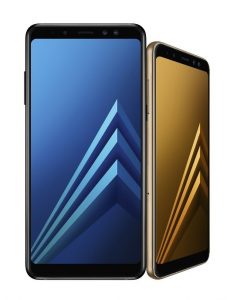
<Samsung Electronics’ Galaxy A8, Source: news.samsung.com>
LG Electronics is going to introduce four K series, K3, K4, K8, and K10. Among them, K10 has a 5.3 inch FHD LCD and it is changed to X series in Korea and is expected to be released at the end of January.
Meanwhile, there is an opinion that Samsung Electronics and LG Electronics’ plan to release low to mid-end smartphones is a bulwark against Huawei which announced the entry into the North American smartphone market.
Huawei has recently partnered with AT&T to sell the Mate 10 series in the US from February 2018. Mate 10 has a 5.9 inch IPS LCD, and Mate 10 PRO has a 6-inch OLED. Huawei announced that it will aggressively advance into the North American market to become the world’s second-largest smartphone maker, outpacing Apple this year.
Samsung Electronics and LG Electronics intend to strengthen their low to mid-end smartphone specifications up to the premium level as well as their flagship smartphones to dominate the smartphone market until new mainstream smartphones are launched and to check other companies including Huawei.
Meanwhile, more details such as the price and mobile provider of Huawei Mate 10 series to be released in North America will be disclosed at the CES 2018 exhibition.
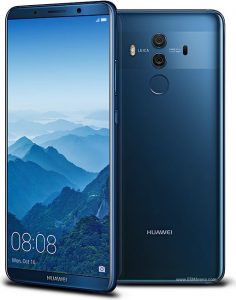
<Huawei’s Mate 10 Pro, Source: GSMArena.com>
CES 2018, 중저가 스마트폰 맞대결 전초전 될 것
/0 코멘트/카테고리: 세트, 포커스온 /작성자: OLEDNETBy Hana Oh (hanaoh@ubiresearch.com)
Samsung Electronics와 LG Electronics가 CES 2018에서 주력 스마트폰이 아닌 중저가 스마트폰을 공개 할 것으로 알려졌다.
Samsung Electronics는 CES 2018에서 5.6 inch의 Galaxy A8과 6 inch의 Galaxy A8 Plus를 선보인다. Galaxy A8(2018) series는 베젤이 거의 없는 Galaxy S8 디자인과 유사한 18 대 9 비율의 full screen OLED를 적용할 것으로 알려졌다.

<Samsung Electronics의 Galaxy A8, Source: news.samsung.com>
LG Electronics는 K3와 K4, K8, K10 등 총 4종의 K series를 선보인다. 이 중 K10은 5.3 inch FHD LCD가 적용 되었으며 국내에서는 X series로 변경되어 1월 말에 출시 예정인 것으로 알려졌다.
한편, Samsung Electronics와 LG Electronics의 이번 중저가 스마트폰 공개가 북미 스마트폰 시장 진출을 선언한 Huawei를 견제하기 위함이라는 시선도 있다.
Huawei는 최근 AT&T와 제휴하여 Mate 10 series를 2018년 2월부터 미국에서 판매할 예정인 것으로 알려졌다. Mate 10은 5.9 inch IPS LCD가 탑재 된 제품이며 Mate 10 PRO는 6 inch OLED가 탑재 된 제품이다. Huawei는 올해 Apple을 제치고 전세계 2위 스마트폰 제조사로 부상하기 위해 북미 시장에 적극적으로 진출하겠다고 선언한 바 있다.
Samsung Electronics와 LG Electronics는 주력 스마트폰 외에 중저가 스마트폰 사양도 프리미엄급으로 강화하여, 주력 스마트폰 신제품이 출시되기 전까지 스마트폰 시장을 주도하고 Huawei를 포함한 타 업체들을 견제하기 위함으로 보인다.
한편, 북미에서 출시 될 Huawei Mate 10 series의 가격과 통신사 등 자세한 내용은 CES 2018 전시회에서 공개 될 전망이다.

<Huawei의 Mate 10 Pro, Source: GSMArena.com>
LG V30 + launched in Japan and India
/0 코멘트/카테고리: 미분류 /작성자: OLEDNETAccording to ITmeadia of Japan, NTT docomo said that LG Electronics’ smartphone ‘V30 + L-01K’ and ‘JOJO L-02K’ started to be sold in advance as from 12:00 on December 20th at DoCoMo store and web site. The full-fledged release of V30 + L-01K will be at the end of January 2018, and that of JOJO L-02K is scheduled in March 2018.

<JOJO L-02K, Source: nttdocomo.co.jp>
V30 + L-01K is equipped with 6-inch QHD OLED, 16.5 and 13.1 megapixel dual cameras, and a wide-angle camera for panorama.
JOJO L-02K is a product celebrating the 30th anniversary of the JoJo’s odd adventure series- Japanese animation. The special edition of JOJO L-02K is limited to 10,000 and the price is 125,712 JPY. It is known that it is also equipped with AR camera mode to make an effect of being with a character.
V30 + has been also available in India since December 18th. Its price is RS. 44,900 (760,000KRW); aurora black and cloud silver will be released first, and other colors will be added later. It features one free display replacement and can be purchased only through amazon.in.
LG V30+ 일본과 인도에서도 판매 시작
/0 코멘트/카테고리: 세트, 포커스온 /작성자: OLEDNET일본의 ITmeadia에 따르면 NTT docomo는 LG Electronics의 스마트폰인 ‘V30 + L-01K’와 ‘JOJO L-02K’의 사전예약을 12월 20일 12시부터 도코모 판매점과 web site에서 시작했다고 밝혔다. V30 + L-01K의 발매 시기는 2018년 1월 말이며 JOJO L-02K의 발매 시기는 2018년 3월 예정이다.

<JOJO L-02K, Source: nttdocomo.co.jp>
V30 + L-01K는 6 inch QHD OLED가 적용되었으며 1,650만 화소와 1,310만 화소의 듀얼 카메라가 탑재되고 또 하나의 광각 카메라를 사용하여 넓은 사진을 촬영할 수 있다.
JOJO L-02K는 일본의 애니메이션인 ‘죠죠의 기묘한 모험’ 연재 30주년을 기념으로 한 제품으로써 1만 대 한정인 것으로 알려졌으며, 가격은 엔화로 세금 포함 12만 5712엔이다. 또한, AR 촬영 모드를 탑재하여 캐릭터와 함께 있는 듯한 효과도 가능한 것으로 알려졌다.
한편 V30+는 인도에서도 지난 12월 18일에 출시되었다. 가격은 RS. 44,900(한화 약 76만원)이며 aurora black과 cloud silver 색이 먼저 출시 되고 다른 색은 추후에 추가가 될 것으로 알려졌다. 1회 무료로 디스플레이 교체가 가능한 것이 특징이며 amazon.in을 통해서만 구매할 수 있다.
Flexible OLED Leading the OLED Panel Market from 2019
/0 코멘트/카테고리: 미분류 /작성자: OLEDNET■ Flexible OLED is expected to ship 480 million units in 2019, surpassing Rigid OLED shipments.
■ Full-screen OLED among Flexible OLED is expected to have an average market share of 78.3% by 2022, dominating the market.
■ Foldable OLED is expected to ship in earnest from 2019.
Flexible OLED shipments are expected to exceed rigid OLED shipments in 2019. According to the ‘2017 Flexible OLED Annual Report’ published by Ubi Research, flexible OLEDs are expected to ship 480 million units in 2019, surpassing 409 million units of rigid OLED shipments. In addition, flexible OLED shipments will grow at a CAGR of 41% starting in 2018, reaching 1,285 million units in 2022 with forecasted revenue of US$ 59.4 billion.

<OLED Market Share Forecast by Substrate in 2018 ~ 2022>
Recently, as the hardware technology of mobile devices has been leveled up, set makers targeting the premium market are trying to differentiate their products by adopting OLED. Especially, set makers are beginning to introduce flexible OLED capable of full screen, as the needs of consumers who want a wider screen in mobile devices (even in the same sizes) on the increase.
Accordingly, panel makers are continuing to invest in flexible OLED mass production. Since Chinese panel makers such as BOE, CSOT and Visionox are expected to start mass production of Gen6 flexible OLED starting in 2018, flexible OLED shipments will likely grow at an average growth rate of 59% per annum, reaching 354 million units by 2022.
This report compares the structure and process of rigid OLED and flexible OLED, and analyzes the trends of technology development for foldable OLED implementation by layer. It also compares the flexible OLED application technology of Samsung Electronics, Apple, and LG Electronics which released mobile devices with full screen OLED. The report also forecasts the flexible OLED market from 2018 to 2022 by categorizing into various perspectives including flexible type, country and generation.
According to the report, full screen OLEDs of flexible OLEDs will ship 265 million units in 2018 with a market share of 82.1%, and 1,022 million shipments will be made in 2022, accounting for 79.5% of the market, leading the flexible OLED market. In addition, the foldable OLED, which has been receiving a great deal of attention recently, is expected to ship 5 million units from 2019 and 53 million units by 2022.

<Foldable OLED Shipment Forecast in 2018~ 2022>
Flexible OLED 2019년을 기점으로 OLED Panel 시장 주도
/0 코멘트/카테고리: 기술, 디스플레이, 시장, 포커스온 /작성자: OLEDNETFlexible OLED 출하량이 2019년에는 rigid OLED의 출하량을 넘어설 것으로 전망됐다. 유비리서치가 발간한 ‘2017 Flexible OLED Annual Report’에 따르면, flexible OLED는 2019년에는 4억 8,000만개가 출하되어 4억 900만개의 rigid OLED 출하량을 넘어설 것으로 전망했다. 또한, Flexible OLED 출하량은 2018년부터 연평균 41% 성장하여 2022년에는 12억 8,500만개 규모를 형성하고 매출액은 594억 달러를 기록할 것으로 예상했다.

<2018~2022년 OLED 기판별 시장 점유율 전망, 출처: 유비리서치>
최근 Mobile 기기의 하드웨어 기술이 상향 평준화 되면서 premium 시장을 목표로 하는 set 업체들은 OLED를 채용하며 제품 차별화를 시도하고 있다. 특히, 같은 size의 mobile 기기에서도 더 넓은 화면을 원하는 소비자들의 니즈가 증가함에 따라 set 업체들은 full screen이 가능한 flexible OLED를 도입하기 시작하였다.
이에 따라 panel 업체들도 flexible OLED 양산을 위한 투자를 지속적으로 진행하고 있다. 특히, 2018년부터 BOE와 CSOT, Visionox 등 중국 panel 업체의 Gen6 flexible OLED 양산 투자가 본격적으로 시작될 것으로 예상됨에 따라, 중국의 flexible OLED 출하량은 연평균 59% 성장해 2022년에는 3억 5,400만개에 달할 것으로 전망됐다.
본 보고서에서는 rigid OLED와 flexible OLED의 구조와 공정을 비교하고 foldable OLED 구현을 위한 기술개발 동향을 layer별로 분석하였다. 또한, full screen OLED가 적용 된 mobile 기기를 출시한 Samsung Electronics와 Apple, LG Electronics의 flexible OLED 적용 기술을 비교하였으며 2018년부터 2022년까지의 flexible OLED 시장을 flexible type과 국가별, 세대별 등 다양한 관점에서 분류하여 전망하였다.
본 보고서에 따르면, flexible OLED 중 full screen OLED는 2018년 2억 6,500만개가 출하되어 82.1%의 시장 점유율을 차지하고 2022년에는 10억 2,200만개가 출하되어 79.5%의 점유율을 차지하며 flexible OLED 시장을 주도할 것으로 전망하였다. 또한, 최근 큰 주목을 받고 있는 foldable OLED는 2019년부터 500만개가 출하되고 2022년에는 5,300만개가 출하될 것으로 예상하였다.

<2018~2022년 Foldable OLED 출하량 전망, 출처: 유비리서치>
LG와 Sony의 실적 이끈 OLED TV
/0 코멘트/카테고리: Exhibition, 포커스온 /작성자: OLEDNET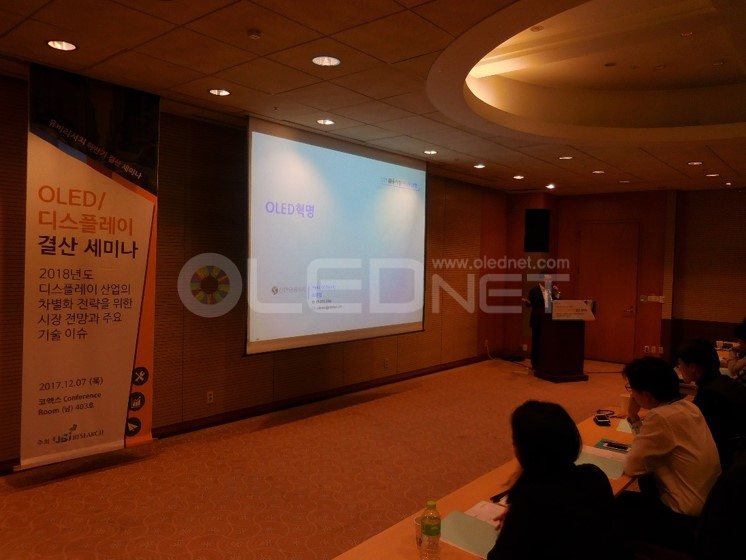
지난 7일 서울 코엑스에서 개최 된 ‘OLED/디스플레이 결산세미나’에서 소현철 이사는 OLED TV가 LG Electronics의 2017년 3분기 영업이익률 9.9%를 견인하였다고 언급하였다. 특히 OLED TV가 3,000불 이하로 진입해 수요가 급증했다고 설명하며 현재 OLED TV를 양산하고 있는 Sony와 LG전자가 앞으로도 premium TV 시장을 주도할 것으로 전망하였다.
특히 소 이사는 Sony가 12년 만에 premium TV 시장에서 1위를 기록하였다고 언급하며 Sony의주가가 2013년 대비 445% 상승한 원동력 중 하나로 OLED TV였다고 설명하였다. 소 이사는 “Sony는 55 inch와 65 inch TV에 집중하며 수익 구조를 개선하기 시작하였다”라며 “2017년에는 OLED TV를 런칭하며 안정적인 TV 사업 구조를 구축했다”고 평가하였다.
또한 소 이사는 LG Display의 10세대 OLED 라인 투자가 예상보다 빨라질 것으로 전망하였다. 소이사는 내년에 개최되는 평창 동계올림픽과 러시아 월드컵으로 인해 대형 OLED TV 니즈 또한 증가할 것이며 특히 Sony도 이를 원할 것으로 예상되기 때문에 OLED 라인 투자가 가속화 될 것으로 전망하였다.
이어서 소 이사는 OLED TV panel의 수율 향상으로 원가절감이 가속화 될 것으로 언급하며 “55 inch LCD 패널 생산원가는 232달러에 수율도 충분하여 원가 개선이 어렵지만, 55 inch OLED 생산원가는 현재 545달러에 수율 향상으로 378달러까지 낮아질 가능성이 있어 가격 경쟁력이 더욱 더 상승할 것”이라 전망하였다.
마지막으로 2018년 LG Display의 E4-2라인 풀 가동으로 OLED TV 패널 판매량이 290만대에 달할 것으로 예상하며, 패널 사업이 흑자 전환하고 2019년에는 OLED TV 사업의 영업이익률이 17.3%에 달할 것으로 전망하였다.
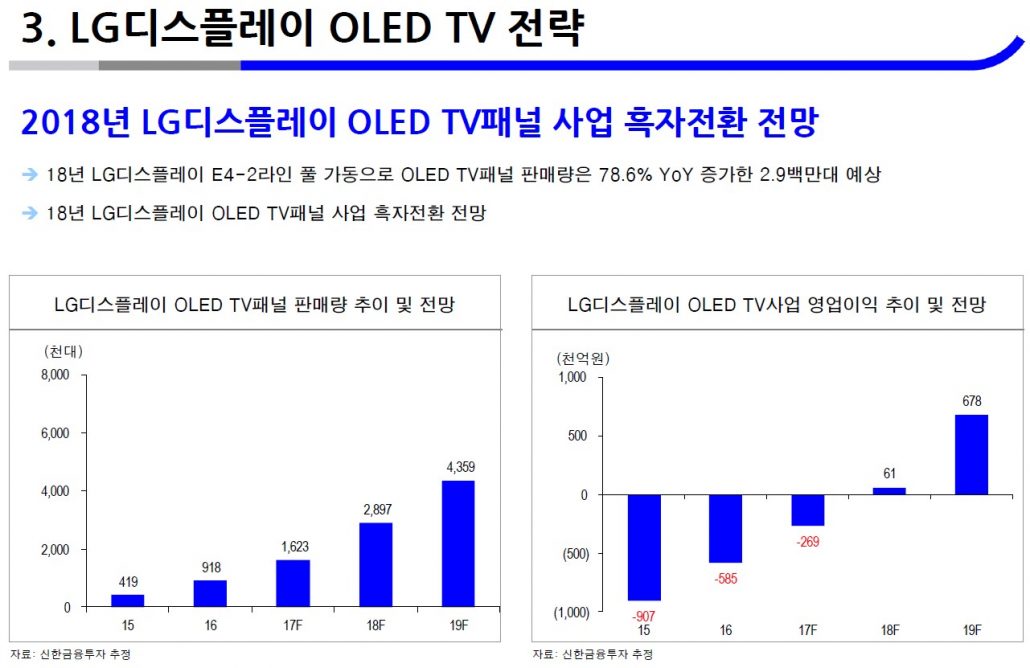
<LG Display의 OLED TV 전략, Source: Shinhaninvest>
OLED TVs which are driving forces of both LG Electronics and Sony′ performance
/0 코멘트/카테고리: 미분류 /작성자: OLEDNET
The director, So, Hyun-cheol, mentioned during the ′Closing seminar of OLED/Display′ held at COEX in Seoul on December, 7th about that OLED TV has made 9.9% of operating profits for LG Electronics in Q3, 2017. He forecasted there, Sony and LG Electronics who are producing OLED TV now will lead the premium TV market in the future also, in particular, while explaining about that the demands have highly increased as OLED TV entered into under $3,000.
The director, especially, explained that Sony took No.1 player in the premium TV market in 12 years, moreover, one of the driving forces for stock price rise of them at 445% in 2013 was OLED TV. He evaluated them such followings that “Sony has starting to improve the structure of operating profit by focusing on 55-inch and 65-inch TV, and “They built the TV business structure in stable through launching OLED TV in 2017”.
He also expected that the investment for 10th generation OLED producing line of LG Electronics will be moved sooner than expected. He also forecasted that demands on large-sized OLED TVs will rise due to the Winter Olympic Games in Pyeong-chang and World Cup in Russia next year, especially, its investment of OLED line will be accelerated, because Sony would also want it.
Subsequently, while the director mentioned that the cost savings will be accelerated by improvement of yield of OLED TV panel, he said, “Although, 55-inch LCD panel is difficult to improve the production cost more since it is already reached to enough yield as 232$, but, the price competitiveness in the 55-inch OLED production cost will be intensified more, because, there is still able to reduce it from current 545$ up to 378$ by the yield improvement”.
Lastly, Mr. So, expected that the sales volume of OLED TV panel will reach to 2.9 million units in 2018 by operating E4-2 line of LG Display in full. The panel business will be turned into profit-making, and operating profits of OLED TV business shall meet 17.3% in 2019.
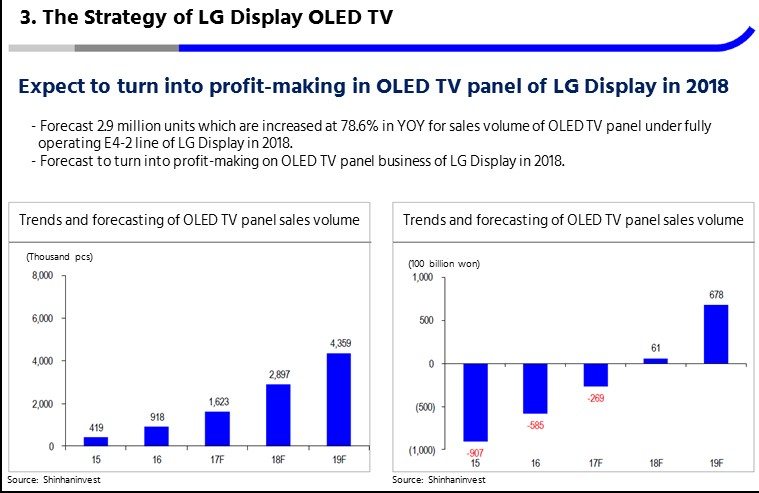
The strategy of LG Display’s OLED TV, Source: Shinhaninvest
The number of OLED TV products in 2017 has doubled compared to last year
/0 코멘트/카테고리: 미분류 /작성자: OLEDNETOLED TV models launched in 2017 have been highly increased rather than both 2015 and 2016. 16 types of OLED TVs were launched in 2016, while 29 kinds of OLED TVs were launched which covers that the number of products has nearly doubled from last year. By company, LG Electronics released total 10 types of products which are the greater number of products launched than competitors, and followed by Loewe with 5 types of products.
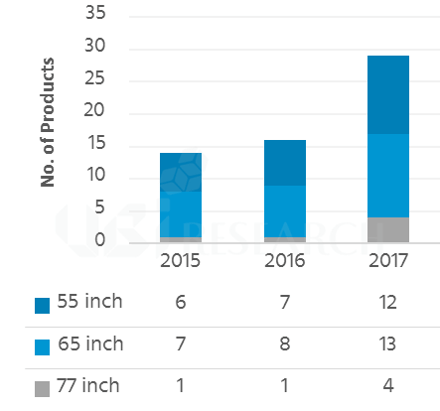
<Comparison of No. of OLED TVs by each year>
Meanwhile, OLED TV market led by LG Electronics, was taken attentions of publics when Sony decided to launch OLED TV first in the early of 2017. Sony which launched OLED TV first in CES 2017 to catch public’s eyes with “Acoustic Surface” technology that can make sounds without speakers, is leading the premium market with LG Electronics by producing 55-inch, 65-inch and 75-inch OLED TVs.
The number of OLED TV products are expected to increase in 2018 more and more. According to Flat Panels HD, Philips which launched only one model with 55-inch OLED in the early of this year, decided for releasing the 6 kinds of OLED TV such as 65OLED973, 65OLED903, 65OLED873, 65OLED803, 55OLED903, 55OLED803 and so forth. It is analyzed that the strategy is to aim at diverse consumers which divides OLED TV leading the premium TV market into high-priced line with 9xx model and low-priced line with 8xx model.
The shipment in 2018 is also expected to grow. In accordance with UBI Research, it expects that OLED panel with 55-inch and more will shipped over 2.4 million units in 2018, 9.1 million units in 2022. There is much attentions how OLED TV leading premium TV market will harden its positions all the more in 2018.
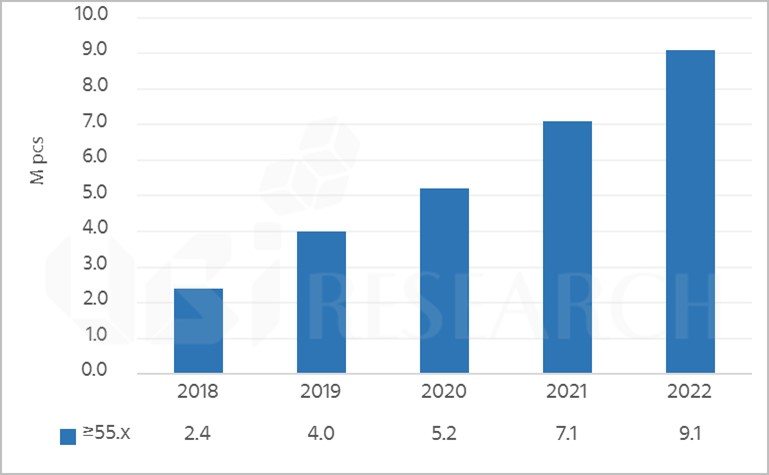
<Shipment forecasting of OLED panel in 55-inch and more in 2018-2022>
2017년 OLED TV 제품 수 작년 대비 약 2배 증가
/0 코멘트/카테고리: 세트, 포커스온 /작성자: OLEDNET2015년과 2016년 대비 2017년에 출시 된 OLED TV 모델이 크게 증가 된 것으로 나타났다. 2016년에는 16종의 OLED TV가 출시 된 반면 2017년에는 29종의 OLED TV가 출시되어 전년도 대비 제품 수가 약 2배 가까이 증가한 것으로 나타났다. 회사별로는 LG Electronics가 총 10종을 선보이며 가장 많은 제품을 출시했으며, Loewe가 5종으로 그 다음을 차지했다.

<연도별 OLED TV 제품 수 비교>
그동안 LG Electronics가 주도한 OLED TV 시장은 2017년 초 Sony가 최초로 OLED TV를 출시하기로 결정하며 큰 주목을 받았다. CES 2017에서 최초로 OLED TV를 출시하며 스피커 없이 소리를 내는 ‘Acoustic Surface’ 기술로 큰 이목을 끌었던 Sony는 55 inch와 65 inch, 75 inch OLED TV를 생산하며 LG Electronics와 함께 premium TV 시장을 주도하고 있다.
2018년에는 OLED TV 제품 수가 더욱 더 증가 할 것으로 예상 된다. FlatPanelsHD에 따르면, 2017년 초 55 inch OLED TV 한 개 모델만을 출시했던 Philips가 65OLED973와 65OLED903, 65OLED873, 65OLED803, 55OLED903, 55OLED803 등 6개의 OLED TV를 2018년 초에 출시하기로 결정했다. Premium TV 시장을 주도하고 있는 OLED TV를 고가형인 9xx 모델과 저가형인 8xx 모델로 나누어 다양한 소비자를 공략한다는 전략으로 풀이된다.
2018년 OLED TV 출하량도 증가 할 것으로 예상된다. UBI Research에 따르면, 2018년 55 inch 이상의 OLED panel은 240만대가 출하 될 것으로 예상하였으며 2022년에는 910만대가 출하 될 것으로 전망했다. Premium TV 시장을 주도하고 있는 OLED TV가 2018년에는 그 입지를 더욱 더 확고히 할 지 귀추가 주목된다.

<2018~2022년 55 inch 이상 OLED panel 출하량 전망>
Price competition intensifies in the premium TV market- OLED TV price close to premium LCD TV
/0 코멘트/카테고리: 미분류 /작성자: OLEDNETIn the premium TV market, price competition is on the rise. The basic premium TV models (55 inch, 65inch, flat type) such as QN55Q7F and QN65Q7F (Samsung Elec.), OLED55C7, OLED65C7 (LG Elec.), XBR55A1E and XBR65A1E (Sony), launched in Amazon (www.amazon.com) in March 2017, are compared to one another).

<Comparison of 55 inch and 65 inch premium TV price>
As a result, the average price of 55 inch models of those three manufacturers dropped by 54.8% from March to October; especially Samsung Elec.’s QN55Q7F showed the highest drop from $ 2,798 in March to $ 1,598 in October. The 65 inch model showed a similar phenomenon. 65 inch dropped 60.0% on average from March to October while Samsung Elec.’s QN65Q7F showing the most dramatic decline from $ 3,998 in March to $ 2,498 in October.
Notably the price difference between 55 inch LG OLED TV and Samsung SUHD TV, both of which were released in 2016, was about $ 1,000 as of Dec 2016, and for 65 inch models, 1,500$ while those released 2017 showed a significantly narrowed price difference as of October 2017-55 inch 200$, 65 inch 300$.
The reason why OLED TV prices are catching up with the premium LCD TV prices is significantly due to stabilization of LG Display production yield. In particular, if the E4-2 line of LG Display, which has started operating since the second half of this year, is fully in operation from 2018, LG Display’s large OLED panel production is expected to increase by 41% to 2.4M units from about 1.7M units in 2017; the OLED TV will accelerate market expansion.
프리미엄 TV시장에서도 가격 경쟁 심화, OLED TV 가격 프리미엄 LCD TV에 근접
/0 코멘트/카테고리: 세트, 포커스온 /작성자: OLEDNET프리미엄 TV시장에서도 가격 경쟁에 불이 붙고 있다. 아마존(www.amazon.com)에서 2017년 3월 출시된 Samsung Elec.와 LG Elec., Sony의 프리미엄 TV(55 inch, 65 inch, flat형) 중 기본 모델인 QN55Q7F와 QN65Q7F(Samsung Elec.), OLED55C7와 OLED65C7(LG Elec.), XBR55A1E와 XBR65A1E(Sony)의 가격을 비교하였다.
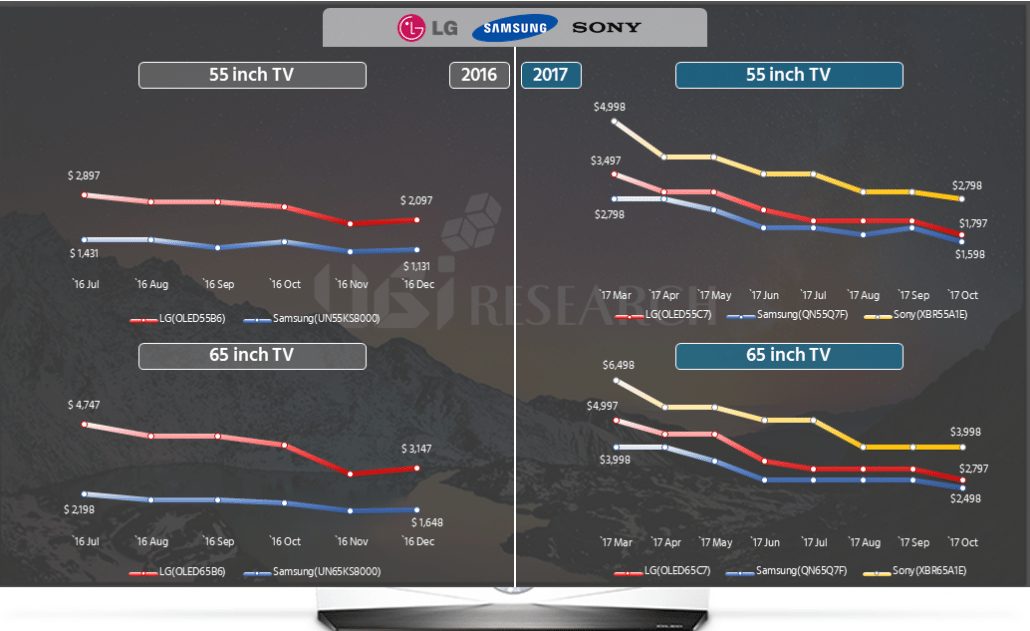
<3사의 55 inch와 65 inch premium TV 가격비교(2017-2018)>
비교 결과 55 inch는 3월 출시부터 10월까지 3사의 제품은 평균 54.8% 하락하였으며, 특히 Samsung Elec.의 QN55Q7F가 3월 2,798$에서 10월 1,598$로 가장 높은 하락율을 보였다. 65 inch 에서도 비슷한 양상으로 나타났다. 65 inch는 3월 출시부터 10월까지 3사 평균 60.0% 하락했으며, Samsung Elec.의 QN65Q7F가 3월 3,998$에서 10월 2,498$로 가장 높은 하락율을 보였다.
여기서 주목 해봐야할 점은 LG Elec.의 OLED TV와 Samsung Elec.의 QLED TV의 가격 차이다. 2016년 출시된 55 inch LG Elec.의 OLED TV와 Samsung Elec.의 SUHD TV의 가격 차이는 2016년 12월 기준 약 1,000$, 65 inch는 1,500$이었던 반면에 2017년 출시된 모델들의 가격 차이는 2017년 10월 기준 55 inch 200$, 65 inch 300$로 작년 보다 격차가 크게 줄어든 것으로 나타났다.
이처럼 OLED TV 가격이 프리미엄 LCD TV 가격을 빠른 추세로 따라잡고 있는 이유는 LG Display의 생산 수율 안정화가 큰 영향을 미친 것으로 분석된다. 특히 올해 하반기부터 본격 가동된 LG Display의 E4-2라인이 2018년부터 full로 가동하게 되면 LG Display의 대면적 OLED panel 생산량은 2017년 약 170만대보다 41% 증가한 240만대까지 증가할 것으로 예상되어 OLED TV 시장 확대가 더욱 빨라질 전망이다.
OLED TV, leading the premium TV market, LG Electronics HE division created the largest operating profit
/0 코멘트/카테고리: 미분류 /작성자: OLEDNETOn the 26th, LG Electronics announced its 2017 Q3 performance through conference call. LG Electronics recorded consolidated sales of KRW 15.2241 trillion in 3Q and operating profit of KRW 516.1 billion. Sales and operating profit grew by 15.1% and 82.2% YoY respectively. Sales are the highest in 3Qs ever.
In particular, sales of premium TV increased, and HE division posted record-high quarterly results with operating profit (KRW 458.0 billion) and operating margin (9.9%). In addition, operating profit (KRW 882.9 billion) and operating margin (9.2%) are the highest in the household appliances business including household appliances and TVs.
LG Electronics announced that its HE division posted sales of KRW 4.6376 trillion and operating profit of KRW458 billion, and sales of premium TVs such as OLED TVs and UltraHD TVs increased steadily, with 12.0% YoY growth. It is known that the operating profit and operating margin (9.9%) reached a record high on a quarterly basis due to improved profit structure by expanding sales of premium products.
LG Electronics said on Oct 11 that monthly sales of OLED TV have exceeded 10,000 units for the first time in Korea and that it is speeding up its popularization. LG OLED TV has been recognized for its image quality by being awarded the top spot in the performance evaluation conducted by non-profit consumer magazines in 11 countries including the US and UK this year and the price of the 55-inch OLED TV has dropped to the mid-2 million level, and It is regarded as the cause of goodness of its sales.
LG OLED TV accounted for about 30% of domestic TV sales of LG Electronics, and it is known to have completely settled in the market. LG Electronics official announced plans for the future, ” HE division plans to continue sales growth and stable profit structure focusing on premium products such as OLED TV and UltraHD TV.”
Premium TV 시장 주도하는 OLED TV, LG Electronics HE부분 최대 영업이익 이끌어
/0 코멘트/카테고리: 시장, 포커스온 /작성자: OLEDNET
지난 26일 LG Electronics는 컨퍼런스콜을 통해 2017년 3분기 실적을 발표하였다. LG Electronics의 3분기 연결기준 매출액 15조 2,241억 원, 영업이익 5,161억 원을 기록했다. 매출액과 영업이익은 전년동기 대비 각각 15.1%, 82.2% 증가했다. 매출액은 역대 3분기 가운데 가장 많다.
특히 premium TV 판매가 늘면서 HE사업본부는 영업이익(4,580억 원)과 영업이익률(9.9%)에서 역대 분기 실적으로는 사상 최고치를 기록했다. 또한 생활가전, TV 등을 아우르는 전체 가전 사업 또한 역대 3분기 기준으로는 영업이익(8,829억 원)과 영업이익률(9.2%)이 가장 높다
LG Electronics는 HE사업본부의 매출액은 4조 6,376억 원, 영업이익은 4,580억 원으로서 매출액은 OLED TV와 UltraHD TV 등 premium TV 판매가 꾸준히 늘며 전년동기 대비 12.0% 증가했다고 밝혔다. 프리미엄 제품 판매 확대를 통한 수익구조 개선으로 영업이익과 영업이익률(9.9%)은 분기 기준 사상 최고치를 기록한 것으로 알려졌다.
LG Electronic는 지난 10월 11일 OLED TV가 국내에서 월 판매량 1만 대를 처음으로 넘어서며 대중화 속도를 높이고 있다고 언급한 바 있다. LG OLED TV는 올해 미국과 영국을 포함한 11개 국가의 비영리 소비자 매거진이 실시한 성능 평가에서 1위를 싹쓸이 할 만큼 화질을 인정받고 있으며 55형 OLED TV의 가격이 200만원 중반까지 낮아진 만큼 합리적인 가격도 판매 호조의 원인으로 손꼽히고 있다.
LG OLED TV는 LG Electronics 국내 TV 매출의 약 30%를 차지하며 시장에 완벽히 정착한 것으로 알려졌다. LG Electronics 관계자는 “HE사업본부는 OLED TV, UltraHD TV 등 프리미엄 제품을 중심으로 매출 성장과 안정적인 수익구조를 이어갈 계획”이라고 향후 계획을 밝혔다.
OLED TV with different characteristics and advantages by set makers
/0 코멘트/카테고리: 미분류 /작성자: OLEDNETLG Electronics announced on last 11th that LG OLED TV is speeding up the popularization with the monthly sales volume of 10,000 units and above for the first time in Korea. In addition, Sony, which joins the OLED TV camp in 2017, is enjoying great popularity and continues to expand its market share in the premium TV market. As such, OLED TV is leading the premium TV market by improving cost competitiveness through cost reduction as well as excellent image quality.
OLED TVs are currently being mass-produced by LG Electronics, Sony, Toshiba and Panasonic. Although all set makers that produce OLED TVs use OLED of LG Display, they are producing OLED TVs with different characteristics and advantages.
First, LG Electronics mentioned OLED’s vivid image quality and wall paper design as advantages of OLED W7 which is a signature TV. LG Electronics mentioned that OLED, which is a self-luminous element, can express near-infinite contrast ratio and rich color close to nature, and supports Dolby vision HDR and HDR10 to experience vivid image quality. Also, introduced that a 4.6mm of thin panel provided the experience of seeing the theater screen and all parts except the panel were housed in a space called innovation stage and completed the perfect wall paper design.

<OLED TV W7 of LG Electronics, Source: LG Electronics>
Sony emphasizes sound, image quality and simple design as the advantage of 4K BRAVIA OLED TV A1E series. It mentioned that the TV screen, which attracted great attention in last year’s CES 2017, can provide an enhanced immersive feeling by applying the ‘Acoustic Surface’ that the TV screen vibrates and makes sound by itself. In addition, the ‘X1 extreme processor’ HDR chip has been applied to improve the picture quality of OLED TV, and the cable is housed in the stand on the backside so that the simple design is realized.

<Acoustic Surface of Sony 4K BRAVIA OLED TV A1E, Source: Sony>
Toshiba then mentioned a high color gamut of 100% DCI-P3 and a high brightness of over 800 nits as the advantages of the REGZA X910. It said that it increased the color reproduction rate to express natural colors and improved the brightness to express the bright and dark parts in richer gradations and strengthened HDR restoration function to realize sharp and realistic high-definition video.

<REGZA X910 of Toshiba, Source: Toshiba>
Lastly, Panasonic stated that it implemented full black and rich color expressions. Especially, it emphasized that it applied ‘Hexa chroma drive plus’ which is Panasonic’s high-definition technology to express high contrast and colors hidden in dark areas that were difficult to implement in LCD TV and reproduced the emotion that the video producer intended.

<Comparison of ‘Hexa chroma drive plus’ technology application of Panasonic, Source: Panasonic>
As such, OLED TV set makers are introducing different OLED TVs that emphasize their characteristics and advantages. In addition to the above four makers, LOEWE of Germany and B & O of Denmark are expected to continue to launch OLED TVs, including mass production of OLED TVs or preparations for mass production. Based on the unique technology of set makers, it is worth noting that OLED TVs with what kind of characteristics and advantages will be produced.
Set 업체 별로 각기 다른 개성과 장점이 부각 된 OLED TV
/0 코멘트/카테고리: 세트, 포커스온 /작성자: OLEDNET지난 11일 LG Electronics는 LG OLED TV가 국내에서 월 판매량 1만대를 처음으로 넘기며 대중화 속도를 높이고 있다고 밝혔다. 또한, 2017년 OLED TV 진영에 합세한 Sony가 큰 호응을 받으며 premium TV 시장에서 점유율을 지속적으로 확대하고 있다. 이처럼 OLED TV는 뛰어난 화질과 함께 원가 절감을 통한 가격 경쟁력 향상으로 premium TV 시장을 주도하고 있다.
먼저 LG Electronics는 signature TV인 OLED W7의 장점으로 OLED만의 생생한 화질과 wall paper 디자인을 언급했다. 자발광 소자인 OLED를 통해 무한대에 가까운 명암비와 자연에 가까운 풍부한 색을 표현할 수 있으며 Dolby vision HDR과 HDR10을 지원하여 생생한 화질을 경험 할 수 있다고 언급하였다. 또한, 4.6mm 두께의 얇은 패널로 극장 스크린을 보는 듯한 경험을 제공하고 패널을 제외한 모든 부품을 이노베이션 스테이지라는 공간에 따로 수납하여 완벽한 wall paper 디자인을 완성했다고 소개했다.
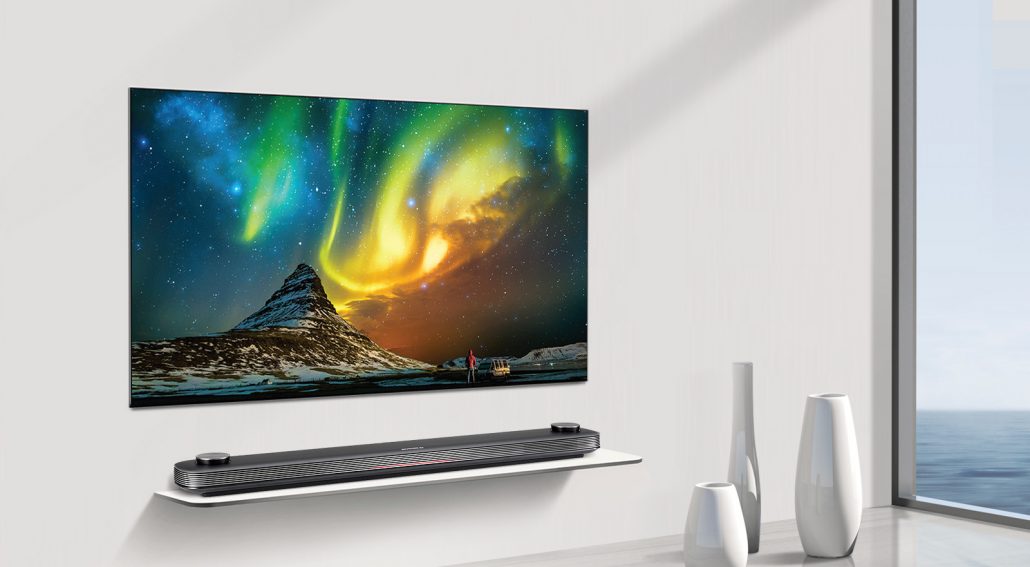
<LG Electronics의 OLED TV W7, 출처: LG Electronics>
Sony는 4K BRAVIA OLED TV A1E series의 장점으로 사운드와 화질, 심플한 디자인을 강조했다. 지난 CES 2017에서 큰 이목을 끌었던 TV 화면이 진동하며 직접 소리를 내는 ‘Acoustic Surface’을 적용하여 향상 된 몰입감을 제공 할 수 있다고 언급했다. 또한, ‘X1 extreme processor’라는 HDR 칩을 적용하여 OLED TV의 화질을 더욱 향상시켰으며 케이블 등을 뒷면의 스탠드에 수납하여 심플한 디자인을 구현하였다고 밝혔다.
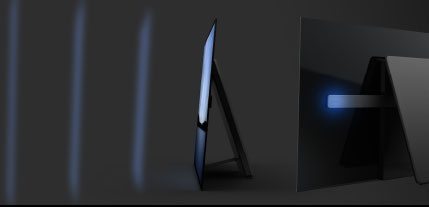
<Sony 4K BRAVIA OLED TV A1E의 Acoustic Surface, 출처: Sony>
이어서 Toshiba는 REGZA X910의 장점으로 DCI-P3 100%의 높은 색재현율과 800 nit 이상의 고휘도를 언급했다. 색재현율을 확대하여 자연스러운 색채를 표현하고 휘도를 향상시켜 밝은 부분과 어두운 부분을 더 풍부한 계조로 표현하였으며 HDR 복원 기능을 강화하여 선명하고 현장감 넘치는 고화질 영상을 구현하였다고 밝혔다.
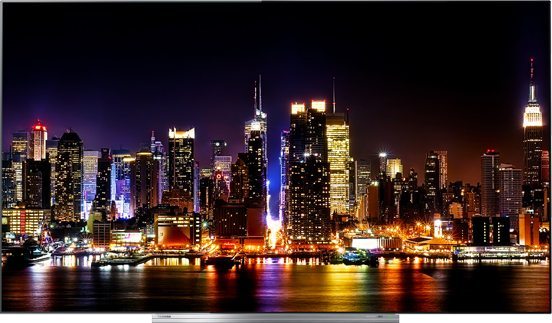
<Toshiba의 REGZA X910, 출처: Toshiba>
마지막으로 Panasonic은 완벽한 블랙 표현과 풍부한 색표현력을 구현했다고 언급했다. 특히 Panasonic의 고화질 기술인 ‘Hexa chroma drive plus’를 적용하여 LCD TV로는 구현하기 힘들었던 고명암비와 어두운 부분에 숨겨져 있던 색채까지 표현하여 영상 제작자가 의도하고 있는 감성을 그대로 재현하였다고 강조했다.

<Panasonic의 ‘Hexa chroma drive plus’ 기술 적용 비교, 출처: Panasonic>
이처럼 OLED TV set 업체 별로 각기 다른 개성과 장점을 부각시킨 OLED TV를 소개하고 있다. 위의 4업체 뿐만 아니라 독일의 LOEWE나 덴마크의 B&O 등도 OLED TV를 양산하거나 양산 준비 중에 있는 등 OLED TV는 지속적으로 출시 될 것으로 예상된다. Set 업체만의 고유한 기술력을 바탕으로 어떠한 개성과 장점이 부각 된 OLED TV를 양산할지 귀추가 주목된다.
가상(VR)·증강현실(AR)이 선택한 ‘OLED 디스플레이’
/0 코멘트/카테고리: 디스플레이, 포커스온 /작성자: OLEDNET최근 4차 산업혁명을 주도하고 있는 가상·증강현실 기기에 OLED 디스플레이를 채용함으로써, LCD에 비해 응답속도가 빠르고 풍부한 색감과 높은 명암비 구현이 가능해짐에 따라, 사용자는 보다 현실감 있고 생동감 넘치는 영상을 체험할 수 있게 되었다.
가상·증강현실용 OLED 디스플레이는 게임, 광고, 교육 등 전 산업 분야에 걸쳐 폭넓게 활용되고 있으며, 이에 따라 관련 출원이 최근 활발하게 이루어지고 있는 것으로 나타났다.
특허청에 따르면, 가상·증강현실용 OLED 디스플레이의 출원은 매년 증가 추세에 있으며, 특히 최근 3년간 관련 출원이 크게 증가한 것으로 나타났다.
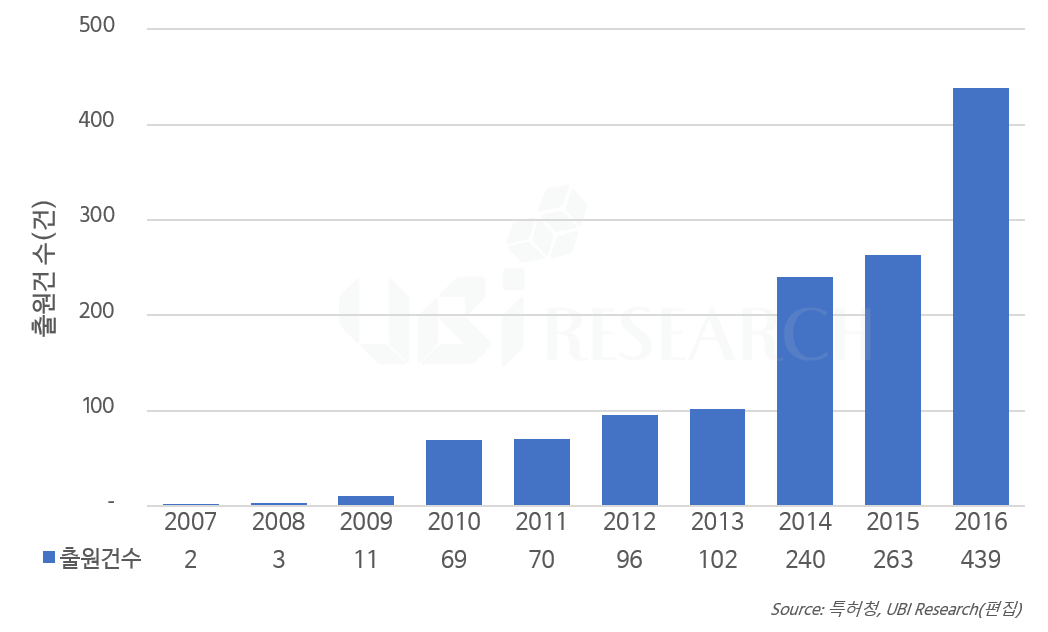
<가상·증강현실용 OLED 디스플레이 출원 동향, 출처: 특허청>
최근 연도별 출원 현황을 보면, 2014년 240건, 2015년 263건, 2016년 439건으로, 2014년을 기점으로 가상·증강현실용 OLED 디스플레이 기술에 관한 출원 건은 급격히 증가하였다.
가상·증강현실용 OLED 디스플레이 분야 출원이 최근에 증가한 이유는 가상·증강현실 기기의 본격적인 대중화를 위한 선결 과제로 해상도와 응답속도, 활용성, 착용감, 가격 등 다양한 조건들의 발전이 요구되고 있는데, OLED 디스플레이는 실감나는 영상을 구현할 수 있고, 플렉시블 설계가 용이하다는 점에서 기존의 LCD에 비해 이러한 니즈를 월등하게 충족할 수 있기 때문인 것으로 보인다.
또한, 2020년 기준으로 가상·증강현실 시장 규모가 약 800억 달러로 크게 증가될 것이라는 전망에 비추어 볼 때, 가상·증강현실 기기에 적합한 OLED 디스플레이가 플렉시블, 롤러블, 벤더블 및 스트레쳐블 디스플레이 형태로 다양하게 개발됨에 따라 가상·증강현실용 OLED 디스플레이 기술에 관한 출원의 증가 추세는 지속될 것으로 예상된다.
가상·증강현실용 OLED 디스플레이 기술에 관한 출원인별 출원 현황(2007년 ~ 2016년)은 대기업 774건(60%), 중견·중소기업 142건(11%), 대학‧연구기관 72건(6%), 개인 70건(5%)을 출원하였고, 외국인이 237건(18%)을 출원한 것으로 조사되었다.
주요 출원 업체별로는 엘지전자 465건, 삼성전자 216건, 마이크로소프트사 51건, 삼성디스플레이 29건, 에스케이플래닛 20건, 퀄컴 17건, 엘지디스플레이 17건 순으로 집계되어, 가상·증강현실용 OLED 디스플레이 관련 기술이 국내 기업에 의해 주도되고 있음을 알 수 있다.
가상·증강현실용 OLED 디스플레이의 응용분야별 출원 현황을 보면 개인용 엔터테인먼트(게임, 테마파크, 체험관) 426건, 국방(전쟁 시뮬레이션, 무기개발, 전투기 조종) 169건, 광고 141건, 의료(3차원 시뮬레이션, 가상 내시경, 모의수술) 131건, 헬스케어 123건, 영화 117건 등으로 나타나, 가상·증강현실용 OLED 디스플레이 기술은 게임과 국방 산업 분야에 가장 활발히 활용되고 있음을 알 수 있다.
특허청 김종찬 디스플레이기기심사팀장은 “TV나 휴대폰과 같은 개인용 제품 중심으로 발달한 OLED 디스플레이는 뛰어난 영상제공 능력을 기반으로 가상·증강현실 뿐만 아니라 새로운 산업분야로 활용 영역의 확장이 예상되며, 아울러 OLED 디스플레이의 수명 연장 및 사용 온도 범위 확대 등 성능 향상 과제를 해결하기 위한 기술과 관련된 출원이 증가할 것으로 예상된다.”고 전망했다.
특허청은 OLED 디스플레이 분야의 특허경쟁력 강화를 위하여, 산업계와 특허청 간의 소통과 협력의 일환으로『IP Together』행사를 정기적으로 개최해 왔으며, ‘개정 특허법 설명회’ 등을 통해 관련 정보를 지속적으로 제공해 나갈 계획이다.
한편, 유비리서치가 발간한 ‘AR과 VR용 디스플레이 시장 보고서’에 따르면 AR과 VR용 OLED는 2017년 260만개 출하되어 52%의 시장 점유율을 차지할 것으로 예상하였으며, 2021년에는 5,200만개 출하되어 80%의 시장 점유율을 차지할 것으로 전망하였다.
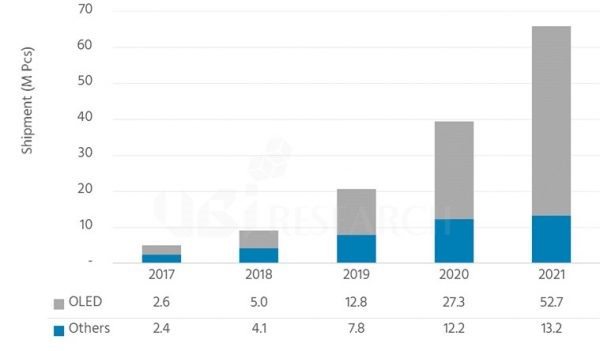
<AR과 VR용 디스플레이 타입별 출하량 전망, 출처: 유비리서치>
‘OLED display’ selected by virtual (VR) · Augmented Reality (AR)
/0 코멘트/카테고리: 미분류 /작성자: OLEDNETBy adopting OLED display in virtual and augmented reality devices, which are leading the fourth industrial revolution in recent years, users can experience more realistic and lively images with faster response time, richer color and higher contrast ratio comparing to LCD.
OLED displays for virtual and augmented reality have been widely used in all industries including games, advertising, and education, and related applications have recently been actively pursued.
According to the Korean Intellectual Property Office (KIPO), the filing of OLED display for virtual and augmented reality is on an increasing trend each year, in particular, the number of related applications has greatly increased over the last 3 years.
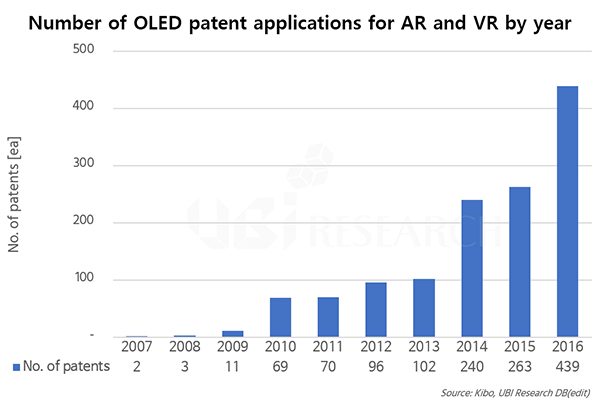
<OLED display application trend for virtual and augmented reality, Source: Korean Intellectual Property Office>
According to the recent filing status by year, there are 240 applications in 2014, 263 in 2015, and 439 in 2016, and applications for OLED display technologies for virtual and augmented reality have increased rapidly from 2014.
The reason for the recent increase in applications for virtual and augmented reality OLED display fields is that the development of various conditions such as resolution, response time, usability, comfort, and price is required as a preliminary task for popularization of virtual and augmented reality devices and OLED displays can realize realistic images and are easy to design with flexibility, which is why they can meet these needs much better than existing LCDs.
Also, given the prospect that the virtual and augmented reality market will increase to about $ 80 billion by 2020, OLED displays suitable for virtual and augmented reality devices are being developed in various forms such as flexible, rollable, bendable, and stretchable displays, and it is expected that applications for OLED display technology for virtual and augmented reality will continue to increase accordingly.
For the filing status of OLED display technology for virtual and augmented reality (2007 ~ 2016), there are 774 cases (60%) of large companies, 142 cases (11%) of medium and small-sized companies, 72 cases (6%) of universities and research institutes, 70 individual cases (5%) 237 foreigner cases (18%).
By major application companies, 465 cases of LG Electronics, 216 cases of Samsung Electronics, 51 cases of Microsoft Corporation, 29 cases of Samsung Display, 20 cases of SK Planet, 17 cases of Qualcomm, 17 cases of LG Display, It can be seen that related technology is dominated by domestic companies.
As for the status of OLED display application field for virtual and augmented reality applications, there are 426 cases of personal entertainment (game, theme park, experience), 169 cases of defense (war simulation, weapons development, fighter pilot), 141 cases of advertisement, 131 cases of medical treatment (3D simulation, virtual endoscopy, simulation), 123 cases of healthcare, 117 movies, etc., indicating that OLED display technologies for virtual and augmented reality are most actively used in the game and defense industries.
“OLED displays, which are developed mainly for personal use products such as TVs and mobile phones, are expected to expand into new industries as well as virtual and augmented reality based on their superior image presentation capabilities,” said Kim Jong-Chan, head of the screening team in the Korean Intellectual Property Office (KIPO). In addition, we expect to see increased applications related to technologies to address performance improvement challenges, such as extending the life of OLED displays and extending the operating temperature range. “.
In order to strengthen the patent competitiveness of OLED display field, KIPO has regularly held “IP Together” event as part of communication and cooperation between industry and patent office, and will continue to provide related information through the “Revised Patent Law Seminar”.
On the other hand, according to the ‘Display Market Report for AR and VR’ published by UBi Research, OLED for AR and VR are expected to be shipped by 2.6 million units in 2017, accounting for 52% of the market share and 52 million units in 2021 accounting for 80% of the market share.
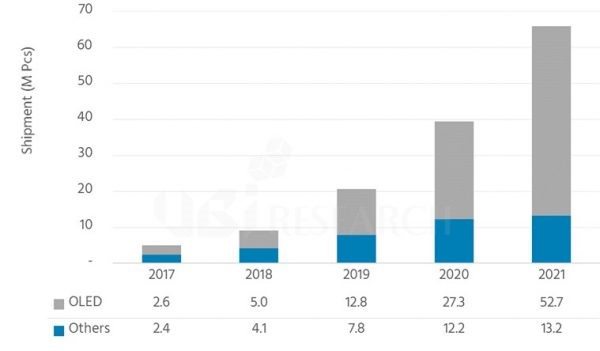
<Shipment forecast by display type for AR and VR, Source: UBI Research>
LG Electronics, Big step on popularization of OLED TV
/0 코멘트/카테고리: 미분류 /작성자: OLEDNET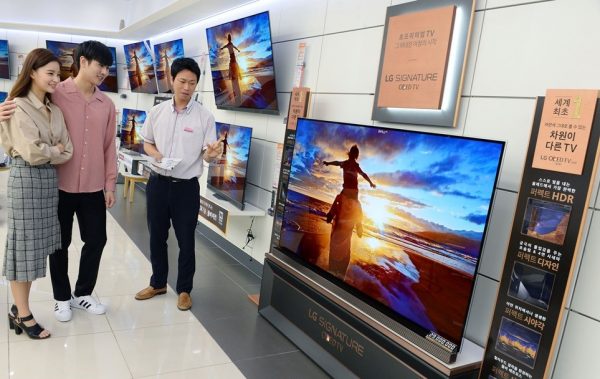
<OLED TV of LG Electronics Source: LG Electronics>
LG Electronics OLED TV is speeding up its popularization with exceeding monthly sales of 10,000 units for the first time in Korea.
‘LG OLED TV’ was sold every four minutes last month. Compared to the beginning of this year, it’s double. LG Electronics expects sales increase of OLED TVs in the future and to rapidly increase market power.
The secret to increasing sales is recognition of outstanding image quality. LG OLED TV, this year, was first in the performance evaluation conducted by nonprofit consumer magazines in 11 advanced markets including the US, UK, Germany, France, Italy, Spain, the Netherlands, Sweden, Belgium, Portugal and Australia. Unlike LCD TVs, the contrast ratio is high because it emits light without backlight. So it presents perfect black and realizes a lively screen.
Consumers consider picture quality the most when purchasing TV. According to a consumer survey conducted by LG Electronics, over 40% of the respondents cited image quality as the top priority when purchasing TVs. This percentage is the highest of all purchasing considerations.
Reasonable price is also the cause of good sales. LG Electronics has continuously developed technology for more consumer to experience OLED TV image quality so as to reduce the. 55-inch OLED TV prices have fallen to the mid-2 million won. It is no different from premium LCD TVs. In 2013 when LG Electronics first launched OLED TV, it was worth 15 million won.
‘LG OLED TV’ accounted for about 30% of LG Electronics domestic TV sales this year and settled perfectly in the market.
Son, Dae-Gi, LG Electronics Korea HE Marketing FD, emphasized “we will expand sales to allow more customers to enjoy ‘LG OLED TV’ image quality and have a solid profit structure by raising premium market power”.
LG전자, 올레드 TV 대중화 성큼
/0 코멘트/카테고리: 세트, 시장, 포커스온 /작성자: OLEDNET
<LG전자의 OLED TV 출처: LG전자>
LG전자 올레드 TV가 국내에서 월판매량 1만 대를 처음으로 넘어서며 대중화 속도를 높이고 있다.
‘LG 올레드 TV’는 지난달 4분마다 한 대꼴로 팔려나간 셈이다. 올해 초와 비교하면 두 배다. LG전자는 앞으로도 판매량이 늘어, 올레드 TV가 시장 장악력을 빠르게 높일 것으로 기대하고 있다.
판매량 증가 비결은 뛰어난 화질을 인정받아서다. ‘LG 올레드 TV’는 올해 미국, 영국, 독일, 프랑스, 이탈리아, 스페인, 네덜란드, 스웨덴, 벨기에, 포르투갈, 호주 등 선진 시장 11개 국가의 비영리 소비자 매거진이 실시한 성능 평가에서 1위를 싹쓸이했다. LCD TV와는 달리 백라이트 없이 자발광하기 때문에 명암비가 높다. 따라서 완벽한 블랙을 표현하고 생동감 있는 화면을 구현한다.
소비자들은 TV 구매 시 화질을 가장 중요하게 생각한다. LG전자가 실시한 소비자조사 결과에 따르면, 조사대상 중 40% 이상이 TV를 구매할 때 화질을 최우선으로 꼽았다. 이 비중은 모든 구매 고려 요소 중 가장 높다.
합리적인 가격도 판매 호조 원인이다. LG전자는 더 많은 소비자들이 올레드 TV 화질을 경험할 수 있도록 끊임 없이 기술을 개발해 원가를 절감했다. 55형 올레드 TV 가격은 200만 원대 중반까지 낮아졌다. 프리미엄급 LCD TV와 차이가 없는 수준이다. LG전자가 올레드 TV를 처음 출시한 2013년에는 1,500만 원이었다.
‘LG 올레드 TV’는 올해 LG전자 국내 TV 매출의 약 30%를 차지하며 시장에 완벽히 정착했다.
LG전자 한국HE마케팅FD 손대기 담당은 “더 많은 고객들이 ‘LG 올레드 TV’ 화질을 감상할 수 있도록 판매를 확대하고, 프리미엄 시장 장악력을 높여 굳건한 수익구조를 갖출 것”이라고 강조했다.
LG Electronics, watching bigger and clearer on ‘OLED FullVision’
/0 코멘트/카테고리: 미분류 /작성자: OLEDNET
<Source: LG Electronics>
LG Electronics will have a strategic premium smartphone equipped with OLED in the 2nd half this year.
LG Electronics will apply OLED FullVision, an 18: 9 aspect-ratio OLED display completely filling the entire screen panel to a strategic premium smartphone in the 2nd half. The size of the display is 6inch wide- larger than 5.7 inches of the previous model LG V20, but the size of the product is rather smaller by reducing the size of the bezel.
Based on the display technology obtained from LG OLED TV, which has been recognized as the world’s best premium TV, LG Electronics plans to provide a different level of visual experience of smartphone; “With OLED technology which has been accumulated over the years, we have completed the differentiated high-class design of the subsequent strategic premium smartphone.”
In the LG Electronics’ strategic premium smartphone, the “bezel bending” technology has been embedded in, which makes the circuit and insulating layers at the bottom of the panel bent backwards and the lower bezel reduced by about 50% compared to the previous model V20. Toughened glass on the outer layer of display is curved all around edge and is smoothened along the contour line of the backside to emphasize a sense of unity on the design,
OLED FullVision has a QHD + (1,440×2,880) resolution and an optimized screen quality algorithm equipped with a color gamut of 148% based on sRGB, default color space for photography and internet, and 109% based on digital cinema color standard DCI-P3.
LG Electronics stated that OLED FullVision should present a deep and vibrant screen with excellent contrast ratio and fast response time will provide a full-fledged screen without afterimages for fast-moving video or games.
LG Electronics also said, “The durability of the display has been upgraded as well, considering the portability of smartphone. OLED Full Vision is stronger than glass substrate displays because it is based on P-OLEDs with pixels placed on plastic substrates,”; “Cutting edge technologies are embedded in such as Corning®’s latest tempered glass ‘Gorilla® Glass 5’ and shatter-resistant technology that prevents the glass powder from scattering when the glass breaks. ” LG added.
Additionally LG Electronics said, “We have applied hardware and software technology to enhance durability. Also encapsulation technology that minimizes oxidation by covering the pixels with a protective film to prevent air contact, and pixel scanning program that identifies heavily used pixels and reduces their power consumption. OLED technology has minimized the burn-in phenomenon that can occur on the display. ”
Joon-ho Cho, president of LG’s MC business director emphasized, “We will provide a high end smartphone with a different level of design and screen quality, integrating the world’s best display technologies proven by LG OLED TV.
LG Electronics, “Sales of the Premium TV in 2017 would hold 60%”
/0 코멘트/카테고리: 미분류 /작성자: OLEDNET
LG Electronics spoke that “The portion of premium TVs in total TV sales will be increased from about 40% in 2016 to around 50% in first half of 2017 and up to 60% in the end of this year.” at the conference call in Q2 2017, which was held on 27th.
The performance in Q2 for HE area of LG Electronics showed 4 trillion and 234.9 billion won in sales, and 343 billion won in operating profit. The QOQ on sales was declined to 2.1%, and the demands of the global TV market are continuously reducing, but the sales of the same quarter in last year showed 1.9% growth through the sales expansion of the OLED premium TVs.
Jin-ho, Ha, the HE director of LG Electronics said that “The Q2 performance was slightly decreased in QOQ and same quarter in last year due to the panel cost increase and marketing promotion for the new product launching, but we sustained healthy profit structures through the expansion of the premium TV sales and the improvement of cost structures consistently.” And also expected, “There are concerns on the slowdown in growth of worldwide TV market for the interest rate hikes and the oil price decrease, nevertheless, the premium TV market will steadily grow according to the demand increase on OLED TV and UHD TV.”
Subsequently, he answered on the question of the counterstrategy for the SONY, “It is not just right time to judge the OLED TV of SONY yet, but until now, we think that the OLED TV of us is quite superior regarding the aspect of design of products, image quality, and its lineup and so on.”
On the recent investment for large-sized OLED of LG Display, “LG Display and LG Electronics, both of us, will wisely take and proceed the world best strategy together of premium TVs by strengthening the premium status of OLED TV.”
He explained on the TV business of LG Electronics, “We have been improving the profitability focusing on the premium lines, and also completely avoiding the quantitative competition. We plan to continuously sustain the quality-oriented rather than quantity.” He added, “We will pursue the activities to intensively keep the premium image of OLED.”
They stated to be maintaining the stable profit structures with aiming at continuous sales expansion of premium products through the marketing promotion for the premium TV-oriented to prepare the high-season for the TV market in second half.
LG Electronics concentrates on ‘product competitiveness not price competitiveness’ in the premium TV market
/0 코멘트/카테고리: 미분류 /작성자: OLEDNET
LG Electronics reported that they plan to focus on product competitiveness rather than price competitiveness in the premium TV market in future through the conference call in Q1 of 2017 which was held on 27th, April. During the Q&A session on ‘the sales strategy of OLED and premium TV’, Jin-ho, Ha, the director of HE (Home Entertainment) said that “we will continue to expand OLED position in the premium TV market and also in future what the competitiveness we need in the premium TV market is product competitiveness rather than price’s.”
The performance in Q1 of HE in LG Electronics was 4 trillion 3261 billion won of sales volume and 3822 billion won of sales profit. It has been reduced 4600 billion won versus previous quarter under the influence of off-season. Nonetheless, YOY (Year on Year) has been kept at the same level. The sales volume was grown up in the area of North America, South Korea and Latin America for the reason of sales expansion of premium TV, though the market in Asia was decreased versus QoQ for the lack of sufficient demand.
Jin-ho, Ha, the director of HE in LG Electronics said that “We improved the profitability versus previous quarter by expansion of premium product sales, improvement of cost structure and flexible management for the panel price rise.” He also expected that the stagnant demand in whole TV market would be continued, but the demand would be increased in the area of North America, Latin America and Asia where are holding relatively high sales ratio.” In addition, “We would maintain sound profit structure and strengthen premium position by diverse global launching of products which leads the market such as ‘LG Signature OLED TV W’.”
He answered the questioning of in future panel price expectation and OLED TV line-up idea, “The panel has been significantly rising from in Q4 of 2016, and it has reached up over 60% versus June where is the lowest point last year”, and “We will design completive line-up composed of ‘premium, best, middle and low’ to aim the premium market within OLED TV group.”
For the question of the strategy in TV market in future, “In present which panel cost is increasing, we would operate the strategy based on the profitability by avoiding a simple volume competition, and we think that the market share in low price TV market is not meaningful. So that we plan to go forward the improvement of quality as a response based on the premium TV market having over 2000~2500 dollars.”
The strategy in TV market of LG Electronics announced at the conference call in Q1 2017 is consistent development of premium TV lineup which brings better profitability with high value-added product. They also expressed that will firmly build their position in the premium TV market with product competitiveness by image quality and technology rather than price competitiveness related to panel price.
2017 Premium TV Market Structure due to the Different Prices of Premium TVs and Sony’s Joining in OLED TV Market
/0 코멘트/카테고리: 포커스온 /작성자: OLEDNETSome line-ups of Samsung Electronics QLED TVs including the Q7 and Q8 introduced at CES 2017 are starting to be unveiled and preordered on its official U.S website and Amazon. The products for preorder are 55, 65, and 75-inch flat TVs of Q7 line-up, and 55 and 65-inch curved TVs of Q8, the higher lineup than Q7. QN65Q7F 65-inch flat TV cost US$ 3,499.99 on Amazon, as of 16th, and QN65Q8C 65-inch curved TV was US$ 4,499.99. It was 20% more expensive than ‘SUHD TV’, the premium TV line-up launched in 2016, and it was intended to build premium TV’s own image by highlighting high price range and enhanced picture quality.
On the other hand, LG Electronics OLED TV prices keep on decreasing. OLED65C6 65-inch curved OLED TV was launched last year at US$ 3,197.00 on Amazon as of 16th, and that was 50% cheaper than US$ 6,000.00 on June, 2016. In addition, the lunch price of OLED65C7 65 inch-curved OLED TV to sell this year is set as US$ 4,000.00 on Amazon as of 15th, which was a 30% cheaper than 2016 and US$ 500.00 cheaper than Samsung’s QN65Q8C 65 inch curved TV. As LG Electronics are leading the OLED premium TV market, it is likely to pay more attention to popularization due to is low price.

<Price Comparison of 2017’ 65-inch Curved TV New Products, Source : Amazon.com>
Due to similar prices of OLED TV and QLED TV in the premium TV market, high-quality picture, brand image, consumer needs satisfaction are gaining importance. Color reproduction among high-quality picture factors has similar performance, whereas OLED TV still gain a competitive advantage in contrast range and response speed. Besides, Sony that has kept a strong brand power and status in the premium TV market showcased OLED TV with higher-quality picture upgraded by ‘Acoustic Surface’ technology that produces sound without speaker and ‘X1 extreme processor’ HDR chip, attracting a lot of attention at CES 2017. Its release date and price have not yet been announced, but it is expected to greatly influence the premium TV market.
There’s a keen interest on, how the 2017 premium TV market will change due to the different price strategies of premium TVs to be released and Sony’s joining in OLED TV.
2017년 premium TV 가격과 Sony의 OLED 진영 가세에 따른 premium TV 시장 구도는
/0 코멘트/카테고리: 세트, 포커스온 /작성자: OLEDNET삼성전자가 이번 CES 2017에서 선보인 QLED TV의 Q7과 Q8등 일부 라인업에 대해, 삼성전자의 미국법인 공식 홈페이지와 Amazon 등을 통해 공개하고 예약 판매를 실시하고 있다. 예약 판매가 진행중인 제품은 Q7 라인업의 55, 65, 75 inch flat TV와 Q7보다 고급형인 Q8 라인업의 55, 65 inch curved TV이며, 65 inch flat TV인 QN65Q7F는 16일 Amazon 기준 US$ 3,499.99, 65 inch curved TV인 QN65Q8C는 US$ 4,499.99로 조사 됐다. 이는 지난 2016년에 출시 된 premium TV 라인업인 ‘SUHD TV’에 비해 출시가격이 20%이상 높은 가격으로, 높은 가격대 책정과 향상 된 화질을 강조하여 premium TV만의 이미지를 구축하려는 의도로 풀이된다.
이에 반해 LG전자의 OLED TV 가격은 지속적으로 하락하고 있다. 지난해 출시 된 65 inch curved OLED TV인 OLED65C6는 16일 Amazon 기준 US$ 3,197.00로, 2016년 6월 출시가격 이었던 US$ 6,000.00에 비해 50% 정도 저렴한 가격에 팔리고 있다. 또한 올해 판매 모델인 65 inch curved OLED TV인 OLED65C7의 출시가격은 15일 Amazon 기준 US$ 4,000.00로 2016년 출시 제품에 비해 30% 저렴하게 책정 되었으며, 삼성의 65 inch curved TV인 QN65Q8C에 비해 US$ 500.00가 저렴하다. OLED를 적용하여 premium TV 시장을 주도하고 있는 만큼, 낮은 가격대로 대중화에 더 공을 들이고 있는 것으로 추측된다.
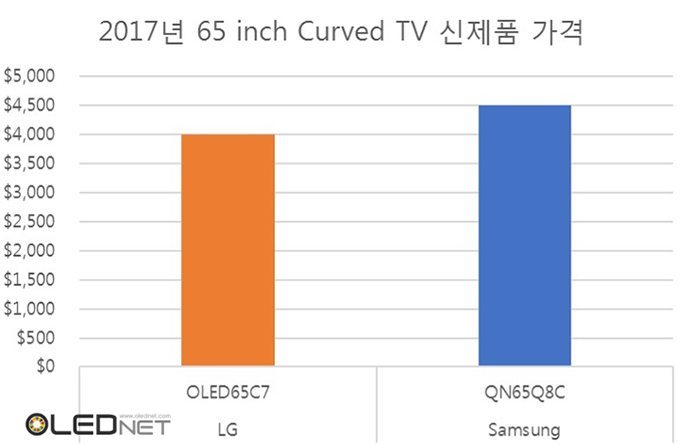
<2017년 65 inch Curved TV 신제품 가격 비교, 출처 : Amazon.com>
이처럼 premium TV 시장에서 OLED TV와 QLED TV의 가격이 점점 엇비슷한 가격대를 형성하고 있기에, 이제는 화질과 브랜드 이미지, 소비자의 needs 충족이 중요한 요소로 떠오르고 있다. 화질에서 색재현율은 서로 비슷한 성능을 보이고 있으나, 명암비와 응답속도 등의 성능에서는 여전히 OLED TV가 우위를 점하고 있다. 또한, 브랜드 파워와 premium TV 시장에서의 여전한 위상을 가지고 있는 Sony가 CES 2017에서 OLED TV를 선보였으며, 스피커 없이 소리를 내는 ‘Acoustic Surface’ 기술과 ‘X1 extreme processor’라는 HDR 칩을 적용하여 OLED TV의 화질을 더욱 더 향상시켜 많은 주목을 받았다. 출시일과 출시가격은 미정이나 premium TV 시장서의 파급력이 클 것으로 예상되고 있다.
2017년 출시 될 premium TV 가격대의 서로 다른 전략과 Sony의 OLED TV 진영 가세로 2017 premium TV 시장이 어떻게 개편될지 많은 이들의 관심이 집중되어 있다.
LG Electronics, OLED TV volume of sales 2 times in the 3rd quarter
/0 코멘트/카테고리: 포커스온 /작성자: OLEDNETLG Electronics revealed that OLED TV volume of sales was enlarged two times than last year through the conference on the third quarter performance having been progressed on the 27th, and currently OLED TV occupied over 10% among total TV sales. Also they expect that volume of the fourth quarter will be increased two times vs. the third quarter.
Regarding countermeasures on quantum dot TV of Samsung Electronics, they have no notion of competing prices with OLED TV, and emphasizes that they will strengthen recognition such like best TV is OLED TV by thoroughly sustaining premium strategies. They explains that market position of OLED in the market of over USD 200, or USD 300 has been actually increasing rapidly
HE Business Division achieved operating incomes (381.5 billion won) and sales profits of top levels (9.2%) in the third quarter. Sales amount was 4 trillion and 141.5 billion won, and there was not large change with previous quarter (4 trillion and 157.2 billion won).
LG Electronics forecasts that TV demands will be increased due to entering high-demand season in the fourth quarter, and needs on premium products such as OLED TV and UHD TV will be expanded further vs. previous quarter centering on the advanced market especially. Though profitability is expected to be decreased vs. previous quarter owing to effects from increases of panel price and expanded marketing expenses, they reveals their willingness such like responding to seasonal demands on large-size premium products including OLED TV and UHD TV etc. will be made successfully.
Meanwhile, according to UBi RESEARCH, they forecasts that OLED TV in premium TV market will achieve high-speed growth while forming the market of 69.1% in 2012 from 16.7% in 2016.
LG’s 77 inch OLED TV at KRW 40 Million, Is the Price OK? Comparison with Competitors…
/0 코멘트/카테고리: 미분류 /작성자: OLEDNET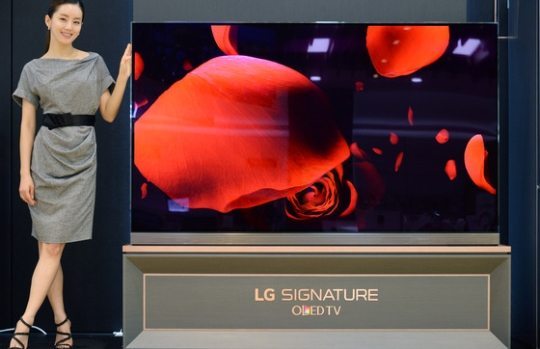
LG`s 77 inch OLED TV Picture Source = LG Elec.
LG의 4천만원 77 인치 OLED TV, 이 가격 괜찮나?…경쟁사 제품 가격 비교해보니
/0 코멘트/카테고리: 세트 /작성자: OLEDNET
LG전자가 최근 출시한 77인치의 OLED TV (출처=LG전자)
강현주 /jjoo@olednet.com
최근 LG전자가 77인치 OLED TV를 발표, 4,100만원이라는 출고가가 화제가 됐다. 가격에 대한 여론이 분분해 유사한 크기의 경쟁사 TV 가격 동향을 살펴봤다.
유비산업리서치의 시장 조사에 따르면 삼성전자의 78인치 SUHD TV 제품은 약 900만원~1,100만원대(아마존 최저가 기준)로 판매되고 있다. 지난 4월에 출시된 이 제품들은 퀀텀닷 필름을 부착한 LCD 패널이 탑재됐다.
LCD를 쓰는 소니 TV의 경우 올해 1월 출시된 75인치 제품이 7월말 기준 약 670만원, 85인치 제품이 약 900만원으로 삼성, LG의 제품보다 저렴한 편이다.
LG전자의 77 인치 OLED TV 제품의 실제 시장가격이 얼마일지 아직 정확히 알 수 없다. 일단 이 제품의 출고가인 4,100만원으로 비교한다면 삼성전자의 78인치 제품과 소니의 85인치 제품보다 4배가량 비싼 가격이다.
기존의 대형 OLED TV의 가격은 같은 크기의 LCD TV에 비해 대체로 2배 가까이 차이난다. 요즘 그 격차가 다소 좁혀지긴 했지만 이는 LG전자가 최근 OLED TV 가격 인하를 단행한 결과다. OLED TV가 비싼 건 사실이지만, 그래도 시장성이 없는 것은 아니다. 실제로 LG전자는 2016년 2분기 OLED TV 판매량이 전년동기에 비해 4배 늘었다고 컨퍼런스콜을 통해 발표했다.
하지만 LG전자의 이번 77인치 OLED TV는 LCD TV와의 가격차이가 2배보다 높은 약 4배라는 면에서 경쟁력이 떨어질 것이라는 의견도 있다.
이에 대해 유비산업리서치 이충훈 대표는 “크기가 커질수록 수율이 급격히 떨어지는 걸 감안하면 LG의 77인치 신제품 가격이 터무니 없는 정도는 아니다”라며 “수율 개선 등으로 가격도 떨어질 것이며 그동안의 TV 시장 추이를 볼 때 결국 시장가가 출고가에 비해 절반까지 떨어질 수 있다”고 내다봤다.
LG의 77인치 OLED TV의 가격도 4,100만원에서 향후 2,000만원정도로 내려갈 수 있으며, 비슷한 크기의 LCD TV와의 가격 격차가 결국 2배정도로 좁혀진다는 얘기다.
이충훈 대표는 “그동안 OLED TV가 LCD TV에 비해 가격이 2배가량 비싸도 나름 시장 입지를 다져왔다”고 설명했다.
LG Elec., Premium Focused Strategy Results in Highest Profitability 2016 1Q
/0 코멘트/카테고리: 미분류 /작성자: OLEDNET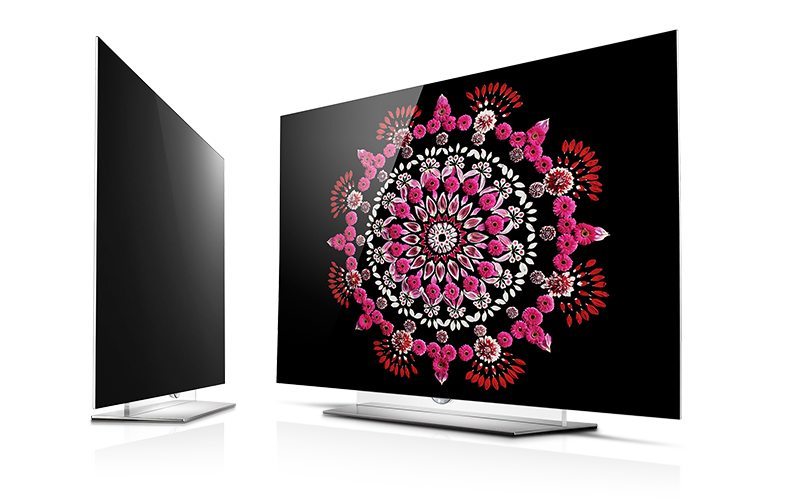
Source : LG Elec.
Hyunjoo Kang / Reporter / jjoo@olednet.com
LG Electronics Inc. (LG) today announced first-quarter 2016 operating profit of KRW 505.2 billion (USD 420.25 million), a 65.5 percent increase from the same period in 2015 on sales of KRW 13.36 trillion (USD 11.12 billion).
The LG Home Appliance & Air Solution Company contributed the largest amount, KRW 407.8 billion (USD 339.23 million) in operating income for the quarter, while the LG Home Entertainment Company earned KRW 335.2 billion (USD 278.84 million) in operating profit, both up significantly from the first quarter of 2015. The LG Mobile Communications Company posted an operating loss of KRW 202.2 billion (USD 168.20 million) primarily due to increased marketing expenditures for the new LG G5 flagship smartphone, while the LG Vehicle Components Company reported a modest loss of KRW 15.8 billion (USD 13.14 million) reflecting higher R&D investments.
LG’s overall global sales and profitability are expected to improve in the second quarter, with double-digit growth in revenues and higher profitability anticipated as LG continues its premium-focused strategy with LG SIGNATURE products, the LG G5 smartphone and 4K Ultra HD OLED TVs.
LG Home Appliance & Air Solution Company recorded sales of KRW 4.22 trillion (USD 3.51 billion) in the first quarter, an increase of 4 percent year-on-year due in large part to higher premium product sales and growth in its B2B operations. Operating profit and operating margin of 9.7 percent were the highest in the history of LG home appliances. Revenues in the Korean domestic market increased 11 percent from the same period the previous year thanks to strong performance of TWIN Wash washing machines, premium refrigerators and commercial air conditioners. Weaker demand caused by the drop in oil prices and unfavorable currency exchange movements negatively affected sales in markets such as the Middle East, South America and CIS, while revenues in North America and Europe remained strong.
LG Mobile Communications Company reported sales of KRW 2.96 trillion (USD 2.46 billion), a decline of 15.5 percent from the first quarter last year. Shipments of 13.5 million smartphones were 12 percent lower both year-on-year and quarter-on-quarter, mainly as a result of the business entering the slow season as well as declining shipments of existing flagship models due to high interest in the recently announced LG G5. Competition in the smartphone market will continue to increase, leading to further price erosion which LG plans to counter with a strong global push for the modular LG G5 smartphone and new mass-tier models such as its X series.
LG Home Entertainment Company reported revenues of KRW 4.33 trillion (USD 3.6 billion), down 2.3 percent from last year’s first quarter as TV shipments declined somewhat in the key markets of North America and Europe. A solid operating margin of 7.7 percent was accompanied by a 207 percent increase quarter-on-quarter in operating income, demonstrating strong evidence of the growing demand for premium OLED and 4K OLED TV products. Improved cost structure and cost competitiveness is expected to drive improved profitability in the next quarter.
LG Vehicle Components Company sales of KRW 592.9 billion (USD 493.2 million) represent a 55 percent year-on-year increase, on the back of LG’s growing automotive infotainment business, although profitability was negatively affected by increased R&D investments. The outlook for LG’s automotive business is positive, with higher expected demand for electric vehicle components and as LG expands its global reach and secures new customers.
이데미츠코산 재료, LG OLED TV 일본 신제품에 공급
/0 코멘트/카테고리: 발광재료, 포커스온 /작성자: OLEDNET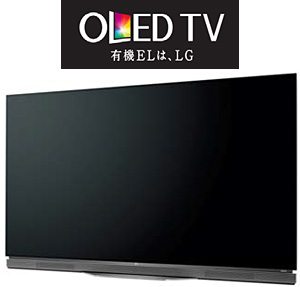
Source : Idemitsu Kosan
일본의 OLED 재료 업체인 이데미츠코산(Idemitsu Kosan)이 자사의 OLED 재료가 일본 LG전자의 최신 OLED TV에 사용될 것이라고 13일 발표했다.
이데미츠코산은 지난 1980년부터 OLED 재료를 개발해왔으며 특히 블루 발광재료의 품질이 뛰어나다는 게 이 회사의 설명이다. 이데미츠코산은 이와 관련 다수의 특허를 보유하고 있으며 한국과 일본에 공정을 가지고 있다. 이 회사는 다양한 제조사들에게 재료를 공급하고 있다.
Adoption of Idemitsu’s Material in LG’s OLED TV
/0 코멘트/카테고리: 미분류 /작성자: OLEDNET
Source : Idemitsu Kosan
Idemitsu Kosan Co.,Ltd.´s (Head Office: Chiyoda-ku, Tokyo; Representative Director and CEO: Takashi Tsukioka, hereinafter “Idemitsu”) OLED material will be used for LG Electronics Japan Inc.´s (Head Office: Chuo-ku, Tokyo; President: In-gyu Lee) latest OLED TV which will be released in Japan this coming mid-May. An
An OLED TV is a next-generation television that has a display which eliminates the need for backlight, which is different from an LCD TV.
Eliminating the need for backlight makes it possible to not only provide a curved and super-thin display but to also represent jet black without being affected by the illumination of the backlight.
Idemitsu has studied and developed OLED materials since the 1980s and has a particular advantage in the development of high-performance blue light-emitting materials. In addition, Idemitsu also has many related patents and manufacturing plants in both Japan and South Korea, and supplies materials to a variety of manufacturers.
After the agreement to form a strategic alliance regarding the OLED business in 2009, Idemitsu and the LG Group concluded an agreement for mutual cooperation in the field of OLED technology and device-related patent licensing in December 2014.
As leading companies, each company has achieved results in product development through their active efforts in this field.
As a result of concluding the agreement, Idemitsu´s OLED material will be used for LG Electronics´ latest television to be released in Japan following the world´s first large high-definition OLED TV which was released by LG Electronics in 2013.
Both companies will continue to provide technical cooperation to develop materials and products that will popularize the use of OLED displays.
LG Elec.`s operating profit is 505.2 billion KRW 1Q 2016…65.5%↑
/0 코멘트/카테고리: 미분류 /작성자: OLEDNET
LG Elec. announced its preliminary earnings results for the 1Q of 2016(Source=LG Elec.)
Hyunjoo Kang / jjoo@olednet.com
These figures are the tentative consolidated earnings based on K-IFRS. This tentative earnings is provided as a service to investors prior to LG Electronics’ final earnings results including net profit and details regarding each division which will be announced officially later this month.
LG전자, 2016년 1Q 영업익 5052억원…65.5% 상승
/0 코멘트/카테고리: 시장, 포커스온 /작성자: OLEDNET
LG전자가 1Q 깜짝 실적을 잠정 발표했다(출처=LG전자)
11일 LG전자가 2016년 1Q에 전년동기 대비 65.5% 상승한 5,052억원의 영업이익을 올렸다고 잠정실적을 발표했다.
LG전자는 연결기준 매출 13조 3,621억원, 영업이익 5,052억원의 2016년 1Q 잠정실적을 발표했다.
LG전자 2016년 1Q 실적은 전년동기 대비 매출 4.5% 감소, 영업이익 65.5% 증가했다. 전분기 대비로는 매출 8.2% 감소, 영업이익 44.8% 증가했다.
잠정 실적은 한국채택 국제회계기준(K-IFRS)에 의거해 추정한 전체 매출액과 영업이익 예상치이며, 연결기준 당기순이익 및 사업부문별 구체적인 실적을 포함한 수치는 실적설명회 당일에 발표할 예정이다.
LG전자는 주주 및 투자자들에게 보다 신속하고 효과적으로 경영실적 정보를 전달하고자 2016년 1Q 실적부터 월초에 잠정실적을 먼저 공시한 후, 월말에 확정실적을 공시할 계획이다.
LG TVS Recommended by Netflix for Second Straight year
/0 코멘트/카테고리: 미분류 /작성자: OLEDNET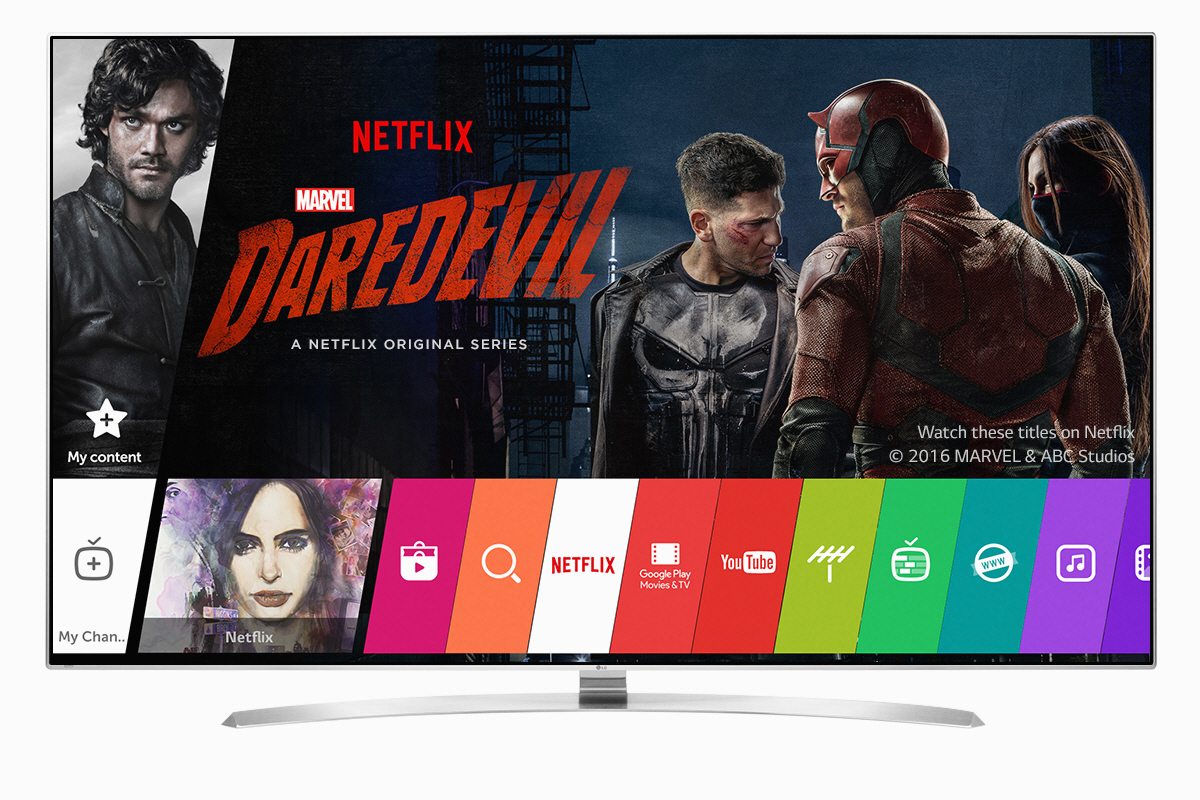
Source : LG Electronics
Hyunjoo Kang / Reporter / jjoo@olednet.com
LG Electronics’ top-tier 2016 4K TVs have been selected by Netflix for its Netflix Recommended TV program for the second consecutive year. Netflix Recommended TV is an evaluation program recognizing smart TVs that deliver excellent performance for Netflix and a better Internet TV experience overall.
LG’s superior webOS 3.0 4K TVs qualified for the global Netflix Recommended TV designation after undergoing a rigorous, criteria-based smart TV evaluation program. Making the list includes LG SIGNATURE OLED TV (G6), 4K OLED TVs (models E6 and C6), LG SUPER UHD TVs (models UH9500 and UH8500) and UHD TVs (models UH7500, UH6500, UH6300 and UH6100) with more models expected to be added as they are evaluated.
The Netflix Recommended TV program is designed to help consumers identify televisions that offer a quicker, easier and up-to-date Netflix experience. LG’s webOS 3.0-enabled OLED TVs, SUPER UHD TVs and UHD TVs offer an unbeatable combination of breathtaking picture quality and streamlined, intuitive smart TV features that provide an optimal Internet TV streaming experience.
With an extensive library of award-winning TV shows and movies and over 600 hours of original programming planned for this year, LG TVs offer an amazing 4K viewing and streaming experience for Netflix members across the globe. What’s more, select LG webOS 3.0 4K TVs offer best-in-class Instant On performance so you can turn on your TV and start watching Netflix faster than on any other model on the market today. Other WebOS 3.0 features like Fast App Switching mean accessing Netflix and other Internet Services is as easy as changing channels.
On top of flawless 4K content, LG TVs are already prepared to provide optimal HDR picture quality.LG’s OLED TVs and SUPER UHD TVs are fully compatible with both the HDR10 and Dolby Vision HDR formats and are ready to offer viewers optimal picture quality for Netflix original series in HDR, including Season 1 of Marco Polo, available now, with Marvel’s Daredevil coming soon.
“We are excited that the Netflix Recommended TV program recognizes our exceptional smart TV performance for the second consecutive year,” said Brian Kwon, President and CEO at LG’s Home Entertainment Company. “On top of smart TV functionality, LG’s premium-tier 4K OLED TVs offer unequaled 4K picture capabilities. Now with more 4K and HDR Netflix content available globally, choosing a TV from LG has become the obvious choice.”
“LG has continued to lead the way in making streaming services, including Netflix, easier and faster to use” said Scott Mirer, Vice President, Device Partner Ecosystem at Netflix. “We are pleased to designate LG’s latest 4K UHD TVs with webOS 3.0 as Netflix Recommended TVs, offering a superior experience for Netflix members all over the world.”
LG TV users can access Netflix by selecting the Netflix app in LG’s webOS smart TV platform. Netflix is also accessible on older TVs through LG’s former smart TV platform, Netcast. For more information on the full list of Netflix Recommended TVs, please visit www.netflix.com/recommendedtv or the LG.com site in your region.
이세돌이 착용했던 LG Smart Watch, 한국 출시
/0 코멘트/카테고리: 세트, 포커스온 /작성자: OLEDNET강현주 기자 /jjoo@olednet.com

출처=LG전자
이세돌이 알파고와의 대국때 착용했던 그 Smart Watch가 한국에 출시된다.
LG전자가 LTE 통신기능을 지원하는 안드로이드 웨어 Smart Watch ‘LG 워치 어베인 세컨드 에디션’을 7일부터 한국 시장에 주요 이통 3사를 통해 출시한다고 6일 발표했다.
‘LG 워치 어베인 세컨드 에디션’은 블루투스로 스마트폰과 연동해 사용할 수 있을 뿐만 아니라, 스마트폰 없이 단독으로 LTE 음성통화, 메시지 송∙수신 등이 가능하다. 이 제품은 안드로이드 4.3과 iOS 8.2 이상의 모든 스마트폰과 연동할 수 있다.
LG전자는 이 제품에 3개의 물리버튼을 탑재해, 버튼 조작에 따라 ‘즐겨찾는 연락처’, ‘메뉴’, ‘극장모드’, ‘LG헬스’ 등 다양한 기능을 직관적으로 사용할 수 있게 했다. 현존하는 스마트워치 가운데 가장 뛰어난 해상도(480×480, 348ppi)를 구현해, 화면을 더욱 선명하고 생동감 있게 표현한다. 또, 이 제품은 타사 대비 약 2배 용량의 570mAh 대용량 배터리를 채택했다.
이 제품의 스트랩은 겉면에 가죽을 별도로 입힌 ‘시그니처 브라운’ 색상이다. 스트랩 옆면 등 내부는 피부에 거부감을 주지 않는 ‘팁시브 엘라스토머’ 재질이다. 이 제품은 ‘고릴라 글래스3’ 강화유리와 하이엔드 아날로그 시계가 채택하던 ‘스테인리스 스틸 316L’을 채용해 내구성을 높였다. 또, 조금의 먼지도 통과되지 않고 최고 1m 수심에서 30분까지 견딜 수 있는 IP67 등급의 방진, 방수가 된다.
한편, LG전자는 지난 3월 이세돌 9단과 인공지능(AI)의 대국에서 이세돌 9단이 ‘LG G 워치 어베인 세컨드 에디션’를 착용하도록 후원한 바 있다.
LG전자 대표이사 MC사업본부장 조준호 사장은 “Smart Watch 시장에서 세계최초로 원형 디자인 트렌드를 선도해 왔듯, 이번 제품도 편의성, 호환성을 한 단계 업그레이드했다”며, “안드로이드 웨어 기반 스마트워치 하나만으로도 자체 통신이 가능한 시대를 열었다는 데 의미가 깊다”고 강조했다.
LG전자, 4K 영상 위한 울트라HD 모니터 출시
/0 코멘트/카테고리: 세트, 포커스온 /작성자: OLEDNET강현주 기자 / jjoo@olednet.com

LG 울트라HD 모니터(출처=LG전자)
LG전자가 10억 개의 색상으로 생생한 화질을 구현하는 울트라HD 모니터를 출시했다고 4일 발표했다.
LG전자는 최근 풀HD보다 4배 높은 해상도인 4K(3,840X2,160)를 적용한 16:9 화면비의 울트라HD 모니터 신제품 2종(모델명: 27UD88, 27UD68P)을 국내 시장에 선보였다.
글로벌 울트라HD 모니터 시장은 지난해에 약 70만 대 규모였고, 올해는 약 3배인 200만 대 규모로 빠르게 늘 것으로 전망된다.
신제품(모델명: 27UD88)은 고해상도 콘텐츠를 완벽하게 보여준다. 표현할 수 있는 색상도 약 10억 개에 달해 현실감 넘치는 화면을 구현한다. 4K 해상도를 적용해 사진을 확대해도 눈가의 주름과 머리카락 한 올까지 선명하게 보여준다. 측면에서 보더라도 화면이 선명한 IPS패널을 적용했다.
이 제품은 사진과 영상을 섬세하게 편집하는 전문가들의 작업에 특히 유용하다. 모니터를 오래 사용하더라도, 사용자가 별도의 색상 측정 장비와 함께 하드웨어 캘리브레이션 기능을 사용하면 새 제품같은 색상을 느낄 수 있다. 사용자가 시계 방향으로 화면을 90도 돌리면 세로로 길게 사용할 수도 있다. 스마트폰으로 세로로 찍은 사진이나 동영상을 감상하고 편집할 때 유용하다.
울트라HD 모니터는 사용자가 게임이나 영화를 즐길 때도 탁월한 경험을 제공한다. AMD의 프리싱크 기술은 빠르게 움직이는 화면도 깨지거나 끊김 없이 자연스럽게 보여준다. 블랙 스태빌라이저 기능은 비슷하게 보이는 어두운 색상들도 선명하게 구별해준다.
편의성도 뛰어나다. 이 제품은 USB 타입-C 단자를 세계 최초로 적용했다. 사용자가 이 단자를 이용해 모니터와 노트북을 연결하면 4K 화질의 영상, 사진 등을 모니터에서 볼 수 있고, 동시에 노트북을 충전할 수 있다. 이 경우에 노트북을 충전하기 위해 별도의 어댑터를 사용할 필요가 없어서 편리하다. 최신 USB 타입-C 단자는 그램 15 노트북, G5 스마트폰 등 최신 IT기기에 적용되고 있다.
사용자는 마우스 조작만으로 화면을 얼마나 밝게 할지, 몇 개의 창을 띄워서 쓸지를 설정할 수 있다. 기존에는 모니터 모서리에 있는 버튼을 여러 번 눌러서 바꿔야 했다.
4K 콘텐츠가 더욱 풍성해지고 있다. 영화, 드라마 등을 서비스하는 넷플릭스, 글로벌 게임 업체인 블리자드 등이 4K 콘텐츠를 잇따라 선보이고 있다. 유튜브에 등록된 4K 콘텐츠도 이미 1,700만 건을 넘어섰다. 이뿐 아니라 소비자들이 ‘LG G5’ 등 최신 스마트폰으로 4K 콘텐츠를 직접 만들 수도 있다.
울트라HD 모니터 신제품의 출하가는 27UD88이 75만원, 27UD68P가 65만원이다.
LG전자 한국영업 HE마케팅FD 담당 허재철 상무는 “4K 콘텐츠에 최적화한 울트라HD 모니터로 차세대 모니터 시장을 지속 선도할 것”이라고 강조했다.
Foxconn Takes Over Sharp…what will happen to Samsung·LG?
/0 코멘트/카테고리: 디스플레이 /작성자: OLEDNETHyunjoo Kang / Reporter / jjoo@olednet.com
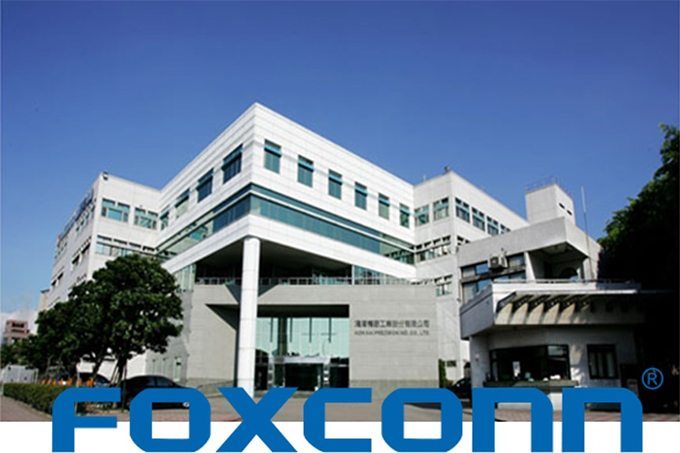
Foxconn Decided to Buy Sharp for Approx. $ 3.5 billion, Source: Foxconn
On March 30, 2016, Taiwan’s Hon Hai’s Foxconn agreed to buy Sharp for about $ 3.5 billion. With this decision, there is much focus on how it will affect Korean display and set companies including Samsung and LG.
Foxconn, primarily an electronics contractor manufacturer, became responsible for Apple’s iPhone production and continued its growth. The fact that through this takeover Foxconn now possesses display mass production ability can greatly affect Korean companies that are currently leading the display and set market.
◆ Competition with Samsung·LG for iPhone Panel Supply Intensifies
A possible scenario for future includes Foxconn becoming a strong competitor for Samsung Display and LG Display in smartphone OLED sector for Apple’s iPhone.
Although Sharp is a company that produces LCD, it is estimated that Foxconn will invest in Sharp to mass produce OLED.
Apple is expected to release OLED equipped iPhone from 2017, and it is known that Samsung Display, strong in OLED, have agreed to supply the initial volume. As Apple has been close with LG in supply and demand of display, some believe that LG Display will become the biggest supplier in future.
However, if Apple’s key collaborator Foxconn begins to produce OLED, it could become a strong rival for Samsung and LG.
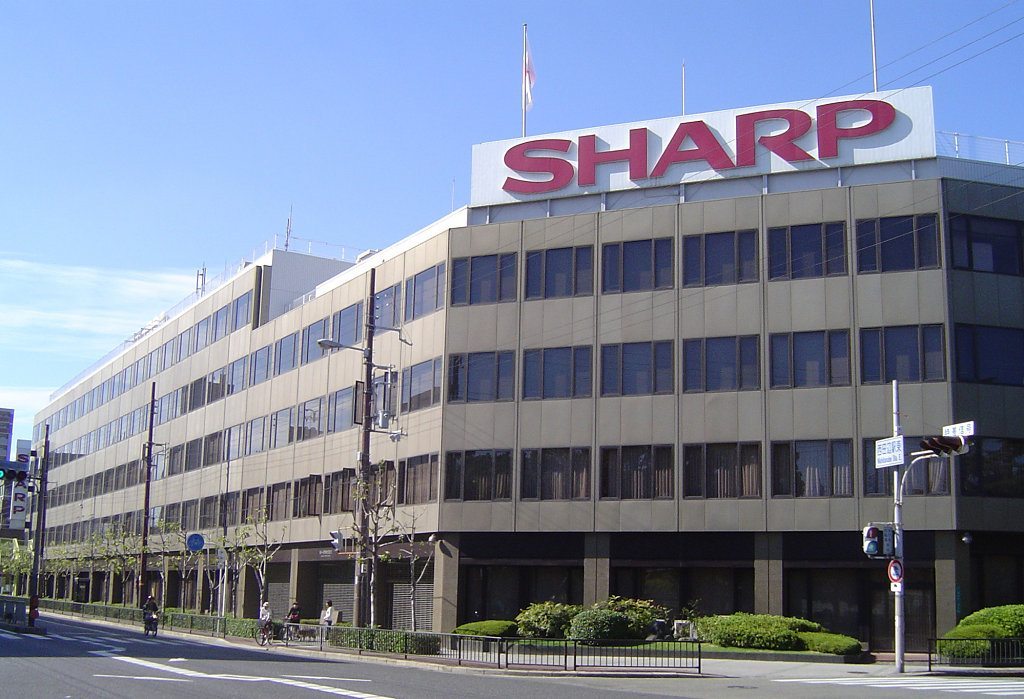
Sharp Headquarters, Source: Wikipedia
◆ Suggestion of Foxconn’s Own Brand Set Production Prospect
Foxconn, despite being a contract manufacturer, became widely known with great growth. As such, the company could branch out into producing sets under their own brand name. Furthermore, with the display mass production now possible with the Sharp takeover, this scenario is gaining traction. According to market experts, Foxconn is now able to expand its smartphone and TV set business. As Chinese set companies are rapidly growing to threaten Korean companies, the prospect of Foxconn’s set business cannot be ignored.
One display expert explained that as a key collaborator of Apple, Foxconn can successfully enter the smartphone panel market. He further analyzed that with Foxconn’s expertise in set production, their own brand set release is not too much to expect, and that this will be easier with the takeover of Sharp.
폭스콘 샤프 인수…삼성·LG에 어떤 영향?
/0 코멘트/카테고리: 디스플레이, 시장 /작성자: OLEDNET강현주 기자 / jjoo@olednet.com

폭스콘이 4조원에 샤프를 인수하기로 결정했다.(출처=폭스콘)
2016년 3월 30일, 대만 혼하이 그룹의 폭스콘(Foxconn)이 디스플레이 생산업체 샤프를 4조원에 인수하기로결정함에 따라 삼성, LG를 비롯한 국내 디스플레이 및 세트 업체들에게 어떤 영향을 미칠지가 주목된다.
지금까지 폭스콘의 주 사업은 스마트폰 외주 생산이었다. 특히 애플의 아이폰 생산을 맡게 되면서 괄목할만한 성장을 거듭하며 세계의 이목을 끌어왔다.
그런 폭스콘이 샤프인수를 통해 디스플레이 자체 생산 능력을 갖추게 됐다는 것은, 디스플레이 및 세트 시장을 주도하는 한국 기업에 지대한 영향을 끼칠 수 있다. 어떤 시나리오들이 있을지 분석해 봤다.
◆”삼성·LG와 아이폰 OLED 공급 경쟁 심화”
샤프를 얻은 폭스콘은 디스플레이 시장에서 애플 아이폰용 OLED 공급을 두고 삼성디스플레이, LG디스플레이와 막대한 경쟁자가 될 것이라는 시나리오가 가능하다.
현재 샤프는 LCD 생산업체다. 하지만 폭스콘은 스마트폰용 OLED 생산을 위해 투자한다고 밝힌 바 있다. 이에 따라 폭스콘은 향후 샤프가 OLED 양산라인을 갖추도록 투자할 것으로 전망된다. 특히 샤프의 소형 LCD 양산라인은 LTPS 기반이라 OLED 라인으로 전환이 가능하다.
오는 2017년부터 애플이 OLED 탑재 아이폰을 출시할 전망이며 OLED 강자인 삼성디스플레이가 1차 물량 공급 계약을 한 것으로 알려졌다. 하지만 애플의 공급처 다각화 전략에 따라 점차 LG디스플레이 등도 아이폰용 OLED를 공급할 공산이 크다. 지금까지의 여정을 본다면 애플은 디스플레이 수급에 있어서 LG와의 관계가 가장 긴밀했기 때문에 장기적으로는 LG디스플레이가 최대 OLED 공급처가 될 것이라는 견해도 나왔었다.
하지만 애플의 핵심 협력사였던 폭스콘이 샤프를 통해 OLED를 생산하게 된다면 이는 향후 아이폰 디스플레이 공급자 자리를 두고 삼성, LG에게 강력한 라이벌이 생길 수 있다는 얘기다.

일본 샤프 본사(출처=위키피디아)
◆폭스콘의 자체 브랜드 세트 생산 가능성 제기
폭스콘은 지금까지 주로 외주 생산 업체로 인식됐지만, 성장을 거듭해 규모가 커지고 전세계에 ‘폭스콘’이라는 이름을 널리 알리는 데 성공했다. 이 때문에 남의 제품 생산을 넘어 자체 브랜드 세트 출시를 꿈꿀 수 있다는 견해도 나온다.
심지어 이제 샤프를 통해 디스플레이 양산이 가능해짐에 따라 이 같은 시나리오가 더 힘을 받는다. 증권가 등 시장 전문가들에 따르면 샤프 인수로 인해 폭스콘은 LCD 패널의 수직계열화 구축으로 스마트폰 및 TV 세트사업 확대가 가능하다.
세계 시장에서 높아진 ‘폭스콘’이라는 브랜드를 내세워 세트 업체로 거듭날 수 있다는 얘기다. 가뜩이나 중화권 세트 업체들이 세계 시장에서 삼성, LG 등 한국 기업들에게 위협이 될 정도로 성장세를 보이고 있다. 이에 폭스콘의 세트 사업 가능성은 무시할 일이 아니다.
디스플레이 업계 한 전문가는 “폭스콘은 애플의 핵심 협력사였다는 강점을 무기로 스마트폰용 패널 시장에 성공적으로 진입할 가능성이 크다”며 “세트 생산에 있어서도 오랜 노하우와 기술력을 갖췄기 때문에 자체 세트 출시는 무리가 아니며 샤프로 인해 디스플레이 양산까지 가능해진다면 더욱 수월해질 것”이라고 분석했다.
Blossoming April… Hurt by LCD, Heal with OLED
/0 코멘트/카테고리: 디스플레이 /작성자: OLEDNETHyunjoo Kang / Reporter / jjoo@olednet.com
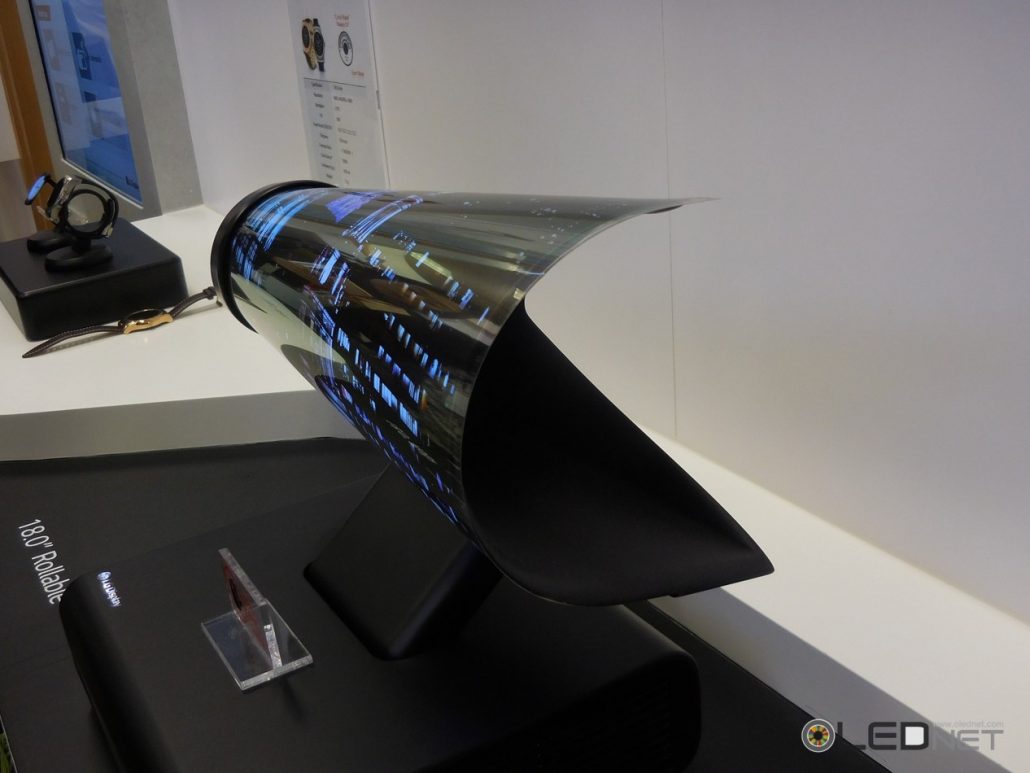
Flexible OLED from LGD(CES 2016)
From April, the display industry is estimated to start mending the damage carried out by LCD with OLED.
In Q1 2016, Korean display industry suffered due to oversupply of Chinese LCD panels. Market experts believe that Samsung Display and LG Display will announce large Q1 deficit in April due to LCD.
However, the display market is expected to actively improve its performance from April.
Dong-won Kim, analyst with Hyundai Securities, estimated that great increase in profit is expected from Q2 2016 due to the increase in OLED operation rate and yield improvement. Also because of profitability improvement effect following LCD panel’s price rebound, the deficit will decrease.
LG Display’s performance in OLED sector is expected to noticeably improve. Over 90% of LG Display’s total mass production line is LCD at present. Hence, the fall of LCD price in Q1 is expected to have hit hard and OLED business is also showing deficit.
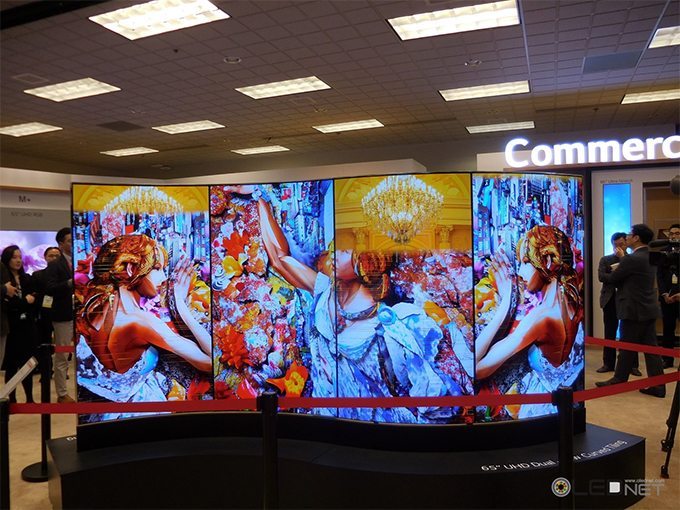
OLED TV from LG(CES 2016)
◆ After Harsh Q1, Warm Breeze of OLED… Spring for Equipment Industry Too
However, this will change from Q2. Analyst Hyeoncheol So of Shinhan Investment forecast that LG Display’s OLED TV sales volume and revenue in Q2 2016 will increase by 144% and 106% respectively. He added that the business deficit of OLED TV sector will greatly decrease.
LG Display is anticipating that the deficit will turn to profit in H2 2017, with the business profit of up to 1 trillion KRW in 2017, an increase of 115%.
Samsung Display, whose LCD and OLED ratio is 50:50, is expected to show 900,000 million KRW in deficit in LCD sector this first quarter. However, this is estimated to be compensated to some degree by the profit in OLED.
Samsung Display and LG Display are actively carrying out investment in OLED panel mass production line in Q1. As well as the investment in turning the existing LCD line to OLED, investment in new OLED line establishment is actively being carried out.
As such, with the optimistic outlook on OLED within the display market, flexible OLED manufacturing equipment companies such as Tera Semicon, Viatron Technologies, and Dong A Eltek had been discussed as the favorites of securities companies. In fact, Samsung Display’s flexible OLED manufacturing equipment related key collaborator AP Systems showed remarkable growth recording 12,100 million KRW in business profit last year.
UBI Research forecast that Korean companies will strengthen their dominance with their 2016 AMOLED shipment’s 95% occupancy of the global market. As OLED is becoming stronger in the TV, smartphone, and VR market, this will become a huge growth engine for global panel companies such as Samsung and LG.
꽃피는 4월…LCD가 남긴 상처, OLED로 치유
/0 코멘트/카테고리: 디스플레이, 시장 /작성자: OLEDNET강현주 기자 / jjoo@olednet.com
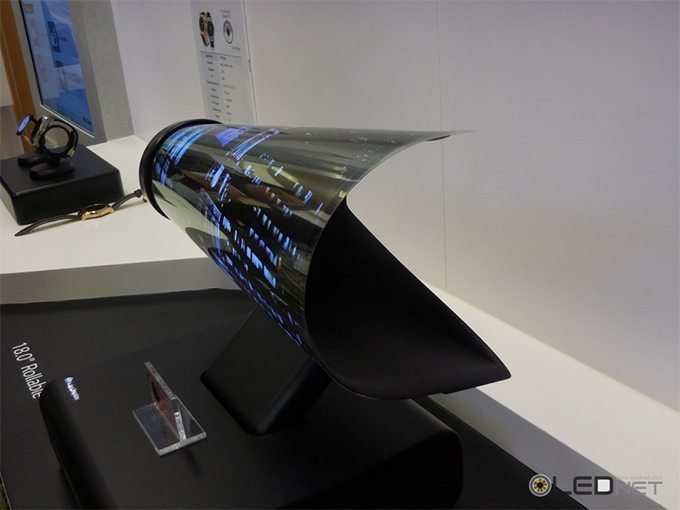
OLEDNET이 다녀온 CES 2016에 전시된 LGD의 플렉서블 OLED
오는 4월부터 디스플레이 업계는 LCD가 후비고 간 상처를 OLED를 통해 회복해 나갈 것으로 전망된다.
2016년 1분기 국내 디스플레이 업계는 중국발 LCD 공급과잉 후폭풍에 시달렸다. 실제로 오는 4월 실적을 발표할 예정인 삼성디스플레이, LG디스플레이는 올 1분기 LCD로 인해 큰폭의 적자를 기록할 것이라고 시장전문가들은 입을 모은다.
하지만 디스플레이 시장은 4월부터 본격적으로 실적개선을 누릴 것으로 예상된다.
현대증권 김동원 연구원은 “2016년 2분기부터 OLED 가동률 상승 및 수율 개선 등으로 큰 폭의 이익증가가 예상되며 LCD 패널의 가격반등에 따른 수익성 개선 효과로 적자도 축소될 것”이라고 전망했다.
3월 현재 OLED를 장착한 갤럭시 S7 판매가 기대치를 웃돌고 중국 스마트폰 업체들의 OLED 패널 주문이 급증하고 있는 것으로 파악된다. 이에 따라 삼성디스플레이의 평면 OLED 양산라인인 A2 라인, 플렉서블 OLED 라인인 A3라인이 풀가동 중이다.
특히 LG디스플레이의 OLED 부문 실적이 눈에 띄게 개선될 것이라는 관측이 나온다. LG디스플레이는 현재 전체 양산라인 중 LCD의 비중이 90% 이상이다. 이에 따라 올 1분기에 LCD 가격 폭락으로 인한 타격이 심할 것으로 보이는 데다가 OLED 사업에서도 적자를 내고 있다. 하지만 2분기부터는 달라진다.

OLEDNET이 다녀온 CES 2016에 전시된 LG의 OLED TV
◆혹독한 1분기 지나 OLED 훈풍…장비 업계도 ‘봄날’
신한금융투자의 소현철 연구원은 “2016년 2분기 LG디스플레이 OLED TV 판매량과 매출액은 수율과 생산능력의 증가로 지난해보다 각각 144%, 106% 늘어날 것”이라며 “올해 OLED TV 부문의 영업적자도 큰 폭으로 감소할 것”이라고 내다봤다.
LG디스플레이는 2017년 하반기에는 흑자 전환이 기대되는 상황이며 2017년 영업이익은 115% 증가한 1조원에 달할 전망이다.
LCD와 OLED 비중이 각각 50%씩인 삼성디스플레이는 올 1분기 LCD 부문에서 9천억원의 적자가 전망된다. 하지만 OLED 부문에서 흑자를 거둬 다소 완충될 것으로 보인다.
삼성디스플레이와 LG디스플레이는 올해 1분기 OLED 패널 양산라인 투자에 본격적으로 들어간 상태다. 기존 LCD 라인을 OLED 라인으로 전환 투자하는 것은 물론 OLED라인 신규 증설 투자에도 적극적으로 나서고 있다.
이처럼 디스플레이 시장에 ‘OLED 훈풍’이 예고됨에 따라 AP시스템, 테라세미콘, 비아트론, 동아엘텍 등 플렉서블 OLED 장비업체들이 증권가 선호주로 물망에 오르기도 했다.
실제로 삼성디스플레이의 Flexible OLED 장비 관련 주요 협력사인 AP시스템은 지난해 영업이익 121억원을 달성하는 등 눈에 띄는 성장세를 그리고 있다.
유비산업리서치 관계자는 “2016년 한국의 AMOLED 출하량은 전세계 시장 95%를 장악할 만큼 국내 업체들의 패권이 확고해진다”며 “TV, 스마트폰, VR 시장에서 OLED가 점점 대세가 되고 있어 이는 삼성, LG 등 글로벌 패널 업체들에게 큰 성장 동력이 될 것”이라고 분석했다.
LG G5 to Begin Shipping Worldwide
/0 코멘트/카테고리: 미분류 /작성자: OLEDNETHyunjoo Kang / Reporter /jjoo@olednet.com

Source : LG Elec.
Starting this week, LG Electronics (LG) will begin reaching global markets with its highly anticipated LG G5 modular smartphone. The LG G5 will debut in South Korea on March 31 and the United States on April 1 to be followed by countries in Europe, Asia and the Middle East, among others. Approximately 200 carriers and operators worldwide have committed to offer the G5 in their local markets.
As demonstrated at its unveiling at Mobile World Congress last month in Barcelona, LG G5 is a showcase of cutting-edge technologies and rich features thoughtfully designed deliver a more playful user experience. MWC attendees seemed to agree with the philosophy behind the G5 as the device walked away with a record 33 awards including Best New Smartphone at MWC 2016 from the GSMA’s Glomo Awards, the mobile industry’s longest established awards platform for innovation, excellence and achievement.
“Since MWC, LG G5 and Friends have captured the imagination of consumers everywhere with its engaging take on mobile technology,” said Juno Cho, president and CEO of LG Electronics Mobile Communications Company. “Modularity has been talked about for years but no one was able to consumerize it until now and we’re happy to take on the mantle.”
Engagement comes in the form of dual 78- and 135-degree camera lenses for ultra wide angle shots, an Always-on Display that requires no button-pressing to get the latest information and Dolby Digital Plus and 7.1 channel audio for cinema-style sound that delivers dialogue and nuanced effects clearly even in loud environments. LG G5 also supports IFTTT (If This Then That), a smart solution that allows users to create a series of action programs called recipes to boost productivity and efficiency.
LG simplified the graphical user interface with a simple, flat look while applying a bright color combination and a semi-transparent blur effect to the GUI. In addition, animation and feedback effects are choreographed at the right moments to deliver a playful and enjoyable experience (https://youtu.be/WqJvMtkmyZI).
The following companion devices, or Friends, will be available in select markets at the time of the G5 rollout or soon after: CAM Plus, LG Hi-Fi Plus with B&O PLAY (with pouch), 360 VR, 360 CAM (with case), Rolling Bot, TONE Platinum, H3 by B&O PLAY
Prices and exact date of availability will be announced separately in each local market.
LG전자,‘G5′ 한국 등 200개국 출시
/0 코멘트/카테고리: 세트, 포커스온 /작성자: OLEDNET강현주 기자 / jjoo@olednet.com

Source : LG전자
LG전자는 ‘G5’를 오는 31일 한국시장을 시작으로 미국, 유럽, 중국 등 전 세계 200여개 이동통신사를 통해 순차적으로 출시할 예정이다. 국내 출시가격은 83만 6천원이다.
LG전자는 오는 4월 15일까지 ‘G5’를 구매하는 국내고객에게 카메라 그립 모듈 ‘캠 플러스’와 ‘배터리팩(추가 배터리+충전 크래들)’을 무료로 증정한다. ‘B&O 패키지’도 할인가격으로 제공한다. ‘B&O 패키지’는 고품질 오디오 모듈 ‘하이파이 플러스’와 프리미엄 이어폰 ‘H3 by B&O PLAY’로 행사기간 동안 약 38% 할인된 289,000원에 구매할 수 있다. 사용자는 ‘G5’에 탑재된 ‘기프트팩’ 애플리케이션을 통해 사은품을 신청할 수 있다.
LG전자는 31일 ‘G5’와 함께 ‘캠 플러스’, ‘하이파이 플러스’, ‘360 VR’, ‘360 캠’, ‘H3 by B&O Play’, ‘톤 플러스(HBS-1100)’ 등 ‘프렌즈’ 6종도 함께 출시한다.
‘프렌즈’는 LG 베스트샵과 하이마트 등 오프라인 매장은 물론, 프렌즈 온라인 쇼핑몰(http://kr.lgfriends.com)에서도 구매할 수 있다.
LG전자의 프리미엄 스마트폰 라인업 ‘G시리즈’의 5번째 모델인 ‘G5’는 세계 최초로 디바이스간 결합을 지원하는 ‘모듈 방식(Modular Type)’을 적용, 글로벌 미디어로부터 스마트폰의 무한한 확장 가능성을 제시했다는 평을 들었다.
LG전자는 고객들이 ‘G5와 프렌즈’를 직접 만져보고 경험할 수 있는 체험존을 신사동 가로수길, 영등포 타임스퀘어, 삼성동 코엑스 등에서 운영 중이다. 또, 31일 오후 7시부터 서울 강남에 위치한 클럽 ‘옥타곤’에서 약 2천명의 일반소비자를 초대, G5 런칭파티인 ‘Dream Players with G5 & Friends’를 연다.
LG전자 대표이사 MC사업본부장 조준호 사장은 “‘G5’와 ‘프렌즈’는 지난 2월 공개 이후 전 세계 소비자들로부터 긍정적인 평가를 받고 있다”며, “모바일 시장에 새로운 패러다임을 제시할 것”이라고 강조했다.
“Can’t Cope Because of LCD”… Samsung·LG, in Despair over Large Deficit
/0 코멘트/카테고리: 디스플레이 /작성자: OLEDNETHyunjoo Kang / OLEDNET / jjoo@olednet.com

<CES 2016 Exhibition. Many Chinese Companies’ LCD TV Were Present.>
Due to the oversupply of LCD panel in global display market, the opinion that Samsung Display and LG Display will also not be able to avoid large amount of deficit is becoming stronger.
As of March 28, according to market experts including securities industry, Samsung Display and LG display will both face sizable deficit in LCD sector this quarter.
For Samsung Display, Q1 LCD sector is expected to record up to 900,000 million KRW. The company is estimated to reduce the overall display industry deficit with the OLED profit of approximately 400,000 million – 500,000 million KRW. Consequently, Samsung Display is to record approximately 400,000 million – 500,000 million KRW of deficit in Q1 2016.
LG Display, whose over 90% of the current production line is for LCD, is estimated to be hit more directly. LG Display has been showing profit in LCD until 2015, but is expected to turn to deficit in Q1 2016. LG Display has been showing deficit in OLED, and market experts are also expecting more deficit in Q1 2016.
◆ Unlike Samsung and LG’s High Quality, China Floods Cheaper LCD
The main reasons that display industry is having difficulty include oversupply of Chinese LCD, and overall market depression. Chinese companies’ affordable LCD supply, backed by active support of Chinese government, is damaging Korean companies.
Particularly, companies such as BOE, which greatly improved productivity with much assistance from Chinese government including corporate tax exemption, have been pressuring Samsung, LG, and others in the global LCD market. As the Chinese companies are still aggressively investing in LCD facilities, the LCD oversupply is analyzed to continue until 2018.
Accordingly, the majority of the industry believe that both Samsung Display and LG Display will carry out LCD production line restructuring. In a recent conference hosted by information company IHS, senior analyst Jeong Du Kang revealed that LG Display could restructure Gumi’s P2, 3, 4 production lines, and added that some thinks L6 production could stop following the same of L5 production line last year.
As expected, both companies do not officially comment on these forecast. However, most of the industry players believe that the production line changes of the 2 companies are inevitable.
One display expert explained that “unlike Samsung and LG which do not accept even small faults, Chinese companies are pouring out products with slightly lesser quality armed with lower price, and will dominate the mainstream market”.
He also estimated that as Samsung and LG are nearing the situation where they have to give up LCD, the speed of which OLED will settle as the main player within the global display market will increase.
“LCD 때문에 못살아”…삼성·LG, 대형 적자 ‘울상’
/0 코멘트/카테고리: 세트, 시장 /작성자: OLEDNET강현주 기자 / jjoo@olednet.com

OLEDNET이 다녀온 CES 2016 전시장. 중국 업체들의 LCD TV 다수가 전시됐다.
전 세계 디스플레이 시장에 LCD 패널 공급과잉으로 인해 삼성디스플레이, LG디스플레이도 올해 1분기 큰 폭의 적자를 면치 못할 것이라는 전망이 우세해지고 있다.
28일 증권가 등 시장 전문가들에 따르면 삼성디스플레이와 LG디스플레이 모두 올 1분기 LCD 부문에서 큰 적자가 예상되고 있다.
삼성디스플레이의 경우 1분기 LCD 부문에서 9천억원에 달하는 적자를 기록할 것으로 관측된다. 이 회사는 OLED 부문에서는 4천억~5천억원 가량의 흑자를 달성, 덕분에 전체 디스플레이 사업 적자 폭을 그나마 줄일 수 있을 것으로 보인다. 결국 삼성디스플레이는 올해 1분기 약 4천억~5천억원에 달하는 적자를 기록할 것이라는 얘기다.
현재 LCD가 생산라인의 90% 이상의 비중을 차지하는 LG디스플레이는 더욱 직격탄을 맞을 것으로 보인다. 이 회사는 지난 2015년까지 LCD 부문에서 흑자를 기록하다가 2016년 1분기 적자로 돌아설 것으로 예상된다. LG디스플레이는 그동안 OLED 부문에서도 적자를 기록해 왔으며 이번 올해 1분기에도 역시 적자일 것으로 시장 전문가들은 관측하고 있다.
◆”완벽 품질의 삼성, LG와 달리 중국은 저가 LCD 쏟아내”
이처럼 디스플레이 업계가 LCD로 인해 울상을 짓는 주 요인은 중국발 LCD 공급 과잉, 전반적인 시장 침체 등이다. 특히 LCD 산업을 적극 지원하는 중국 정부를 등에 업은 중국 디스플레이 업체들의 저렴한 LCD 물량 공세가 국내 업체들에게 타격을 입히고 있다.
특히 중국 정부로부터 법인세 감면 등 막대한 혜택을 입고 생산력을 크게 향상한 BOE 등이 뛰어난 가격 경쟁력으로 삼성, LG 등을 전세계 LCD 시장에서 위협해왔다. 중국 업체들은 여전히 공격적으로 LCD 설비 투자를 하고 있어 LCD 공급 과잉 현상은 오는 2018년까지 지속될 것으로 분석된다.
이에 따라 삼성디스플레이, LG디스플레이 모두 LCD 생산라인 구조조정을 단행할 것이라는 게 업계 중론이다. 최근 시장조사업체 IHS가 개최한 한 컨퍼런스에서 강정두 책임 연구원은 “LG디스플레이는 구미의 P2, 3, 4 생산라인의 구조조정이 있을 수 있으며 지난해 L5 생산라인 가동 중지에 이어 L6 가동 중지설도 나온다”고 말했다.
물론 두 회사 모두 이 같은 관측에 대해서는 공식적으로 “노코멘트”라는 입장이다. 하지만 대부분의 업계관계자들은 두 회사의 생산라인 변화는 불가피할 것이라 보고 있다.
디스플레이 업계 한 전문가는 “아주 작은 결함도 용납하지 않는 삼성, LG와는 달리 중국 업체들은 다소 완벽한 품질이 아니더라도 낮은 가격을 무기로 물량을 쏟아내고 있어 보급형 시장을 장악하게 될 것”이라고 설명했다.
그는 “삼성, LG가 결국 LCD를 놔야 하는 상황이 가까워지는 만큼 OLED가 세계 디스플레이 시장 주역으로 자리잡는 속도가 점점 빨라질 것”이라고 내다봤다.
LG전자, ‘UX 5.0’ 공개…G5에 첫 탑재
/0 코멘트/카테고리: 세트, 포커스온 /작성자: OLEDNET강현주 기자 / jjoo@olednet.com

출처: LG전자
LG전자가 ‘LG UX 5.0’을 공개,‘G5’에 가장 먼저 탑재하고 이후 출시하는 다른 모델에도 순차 적용할 예정이다.
LG전자는 ‘G5’에 세계 최초로 기기끼리 결합할 수 있는 ‘모듈 방식’을 적용해 스마트폰의 무한한 확장 가능성을 제시했다. G5는 주변기기인 ‘LG 프렌즈’와 결합한다.
LG전자는 ‘UX 5.0’를 통해 ▲‘프렌즈’와의 쉬운 연동 ▲비주얼 향상 기능 ▲편의성 강화 등을 구현했다고 설명한다.
‘UX 5.0’의 ‘LG 프렌즈 매니저(LG Friends Manager)’는 다양한 ‘프렌즈’를 ‘G5’와 쉽게 연동하고 제어할 수 있는 통합관리 앱이다.
‘프렌즈 매니저’는 주변의 ‘프렌즈’를 자동으로 인식해 복잡한 절차 없이 연결할 수 있다. 사용자는 G5에 선탑재 된 ‘프렌즈 매너저’를 통해 각 프렌즈의 전용앱을 쉽게 설치할 수 있다.
‘G5’는 360 캠, 롤링봇 등 다양한 프렌즈와 연결해 사진을 찍으면 ‘G5’ 카메라 앨범에서 사진을 모아 볼 수 있다. 사용자는 ‘프렌즈’로 찍은 사진을 찾거나 관리할 수 있다.
LG전자는 ‘G5’에 비주얼 기능을 강화한 카메라 UX를 탑재했다. ‘오토 셀피(Auto Selfie)’는 셀피 촬영 시 사용자가 별도의 버튼을 누르거나 특정 제스처를 취하지 않아도 스마트폰이 사용자의 얼굴을 인식해 자동으로 촬영하는 기능이다. 스마트폰이 사용자의 얼굴을 인식한 후 화면의 움직임이 없으면 1초 뒤 자동으로 촬영된다. ‘오토셀피’는 소비자들의 큰 호응을 얻었던 손바닥을 편 상태에서 주먹을 쥐면 셀피가 찍히는 ‘제스처샷’에서 한 단계 진화한 셀피 UX다.
‘멀티뷰’는 G5의 전후면 3개의 카메라를 이용해 동시에 각기 다른 사진이나 영상을 한 화면에 분할해 담을 수 있는 기능이다. 특히 사용자가 ‘G5’를 ‘LG 360 캠’과 연결하면 ‘G5’의 카메라뿐 아니라 ‘360 캠’으로 찍은 이미지까지도 한 화면에 담을 수 있다.
‘팝아웃 픽처’는 2개의 후면 카메라로 동시에 촬영한 사진을 한 화면에 겹쳐 보여주는 기능이다. 사용자는 광각 카메라로 찍은 부분을 흐리거나 흑백으로 만들어 일반각으로 찍은 장면이 마치 액자 안에 있는 듯한 색다른 사진을 얻을 수도 있다. 광각카메라로 찍은 사진은 흑백, 비네트, 흐림 등 효과를 줄 수 있다. 각 효과는 중복해 적용 가능하다.
‘필름 효과’는 필름 카메라 특유의 감성을 느낄 수 있는 스마트폰 사진 필터다. 사용자는 사진을 찍기 전에 ‘필름 효과’가 적용된 화면을 미리 보고, 자신이 원하는 색감을 선택할 수 있다.
LG전자는 ‘LG G5’에 스마트폰 최초로 탑재한 135도 광각 카메라를 보다 직관적으로 이용할 수 있도록 ‘줌인앤아웃’을 적용했다. 사용자들은 두 손가락을 모으거나 펼치는 동작만으로 일반각과 광각을 자연스럽게 전환할 수 있어 마치 하나의 렌즈처럼 사용할 수 있다.
사용자는 ‘360 월페이퍼’ 기능을 통해‘360 캠’으로 찍은 이미지를 배경화면으로 설정하면 홈화면을 360 파노라마 뷰어처럼 볼 수 있다. 스마트폰을 상하좌우로 움직이면 스마트폰의 움직임에 따라 배경화면도 따라 움직인다.
‘UX 5.0’은 사용자들이 앱 설치와 제거를 직관적으로 할 수 있도록 ‘홈 스크린’ 화면과 ‘앱 서랍’ 화면을 하나로 통일했다. 이를 통해 앱을 설치하거나 삭제할 때 사용자의 혼란을 최소화하고 앱 진입 경로도 단순화 했다. 기존 방식에 익숙한 사용자는 홈 설정에서 기존 방식의 홈화면을 다운받아 사용할 수 있다.
‘LG 헬스’는 사용자의 활동량을 체크해 ‘일반(Beginner) 모드’나 ‘프로(Advanced) 모드’로 나눠주며 각 모드에 적합한 운동 데이터를 제공한다. 일반모드 사용자의 운동량이 일정 수준으로 넘어서면 자동으로 프로모드로 전환된다. 또 사용자의 활동량을 시각적으로 보여주고 도전과제를 지속적으로 업데이트 하는 등 사용자가 운동을 계속 할 수 있도록 도와준다.
‘UX 5.0’에는 사용자가 잘 사용하지 않는 앱이나 파일을 찾아서 정리해 주는 스마트 클리닝 기능에서 한층 더 발전한 ‘스마트 닥터’ 기능이 추가됐다. 스마트 닥터는 사용자의 습관을 분석해 예상되는 문제를 미리 진단하고 해결 방법을 알려 주는 지능형 스마트폰 관리 기능으로 스마트폰이 항상 최적의 상태를 유지할 수 있도록 도와준다. 예를 들어 배터리를 완전 방전한 후 교체하는 사용자에게는 ‘올바른 배터리 충전 습관’에 대해 안내를 해 주는 식이다.
‘세계시간’은 기준 도시의 시간을 변경하면, 등록된 다른 도시의 시간도 함께 연동해 바뀌는 것을 시각적으로 보여준다. 예를 들어 서울 시간을 오후 3시로 맞추면 뉴욕은 오전 1시, 런던은 오전 6시로 함께 변경된다.
‘LG 백업’은 이전 스마트폰과 NFC 태깅만으로도 데이터 전송을 할 수 있어 스마트폰끼리 연결할 때 복잡한 설정을 할 필요가 없다. ‘LG 백업’은 스마트폰에 저장된 사진, 메모 등을 백업해 다른 스마트폰으로 옮길 수 있는 기능이다. LG전자 스마트폰 뿐 아니라 타 제조사의 스마트폰에서도 사용이 가능하다.
‘파일 매니저’는 마치 PC처럼 파일을 관리할 수 있는 기능이다. 상단에 있는 파일 경로를 버튼화 해 파일 경로를 누르면 해당 폴더로 바로 이동할 수 있다. 문서, 영상, 이미지 등의 필터 검색 기능도 있어 원하는 파일을 빨리 찾을 수 있다.
‘올웨이즈온’은 화면이 꺼져 있어도 시간, 요일, 날짜, 배터리 상태 등 기본 정보는 물론 문자, SNS 등의 알림 정보를 24시간 디스플레이에 표시해 주는 기능이다.
LG전자는 ‘G5’에 고유의 보안 방식인 노크 코드와 함께 지문인식 기능도 탑재해 소비자가 원하는 방식을 선택할 수 있도록 했다.
LG전자 대표이사 MC사업본부장 조준호 사장은 “LG UX 5.0은 스마트폰 사용자의 라이프 스타일을 분석해 확장된 모바일 경험과 뛰어난 편의성을 제공한다”고 강조했다.
LG UX 5.0, Equipped to G5
/0 코멘트/카테고리: 미분류 /작성자: OLEDNETHyunjoo Kang / Reporter / jjoo@olednet.com

Souece : LG Elec.
With the imminent consumer rollout of the new LG G5, LG Electronics (LG) will also be introducing a new version of its mobile user interface, LG UX 5.0. Designed for a more playful and innovative mobile experience, LG UX 5.0 will offer advanced features and greater convenience not only for LG G5 users but owners of upcoming smartphone models as well.
Based on Android’s latest Marshmallow OS, LG UX 5.0 conveys LG’s philosophy on the future of mobiles. LG UX 5.0 is an enjoyable, enhanced and user-centric UX that supports easy connection for optimal control of LG Friends and delivers a more convenient and powerful experience by adding new functions that allow users to enjoy the G5 to its maximum potential.
“We analyzed the lifestyle of smartphone users to provide a superior mobile experience and greatly expanded the usability with LG UX 5.0,” said Juno Cho, president and CEO of LG Electronics Mobile Communications Company. “LG UX 5.0 and G5 were designed to provide an innovative user experience that reflects the needs of our most demanding customers.”
An Enjoyable UX for Connecting with LG Friends
The highlight of LG UX 5.0 is LG Friends Manager, a versatile application that enables users to easily connect with and control the modules and accessories known as LG Friends. LG Friends Manager intuitively detects nearby accessories for easy pairing with LG G5, easily downloading and installing all the required apps from the Google Play Store. No hassles, no hunting. With LG Friends Manager, the process of connecting the LG G5 to its Friends couldn’t get any easier.
LG Friends Manager generates a different display for each LG Friend. When paired with the 360 CAM, the screen on the G5 will display photo previews and the available shooting modes. The Friends Camera Album in the Gallery enables users to categorize and manage images captured with LG Friends such as 360 CAM and Rolling Bot.
An Enhanced UX for a Powerful Visual Experience
The greatest advantage of LG UX 5.0 is its enhanced support for LG G5’s extremely powerful camera. Image and video capturing has never been so enjoyable with features such as:
Zoom In & Out – Seamlessly switch between the standard 78-degree lens to the 135-degree wide angle lens by simply pinching the screen.
Auto Shot – An enhanced version of Gesture Shot, take the perfect selfies with this smart feature which triggers the shutter as soon as the users’ face is recognized.
Multi View – Captures different angles of images at the same exact moment using the front and rear cameras of the G5 and the LG 360 CAM.
360 Wallpaper – Images taken with the LG 360 CAM can be displayed as a 360 panorama, shifting in sync with movements of the G5.
Pop-out Picture – Combine two images taken simultaneously with the standard and wide angle lens to create a picture-in-a-frame effect.
Film Effect – Raise the level of effects with this set of filters that deliver an “analog” feel to photos. Use Camera Preview to preview and change a filter on the fly before taking the shot.
A User-Centric UX for Greater Convenience
LG refined its user interface and included several new smart features on LG UX 5.0 to enhance usability and convenience, such as:
New Home – LG combined its Home Screen with the App Drawer in LG UX 5.0 to simplify the user experience. Users who prefer the traditional style can download the Home & App Drawer directly from the settings menu on the LG G5.
LG Health – Upgraded for UX 5.0, LG Health provides a Beginner as well as Advanced mode matched to the user’s profile. Start with Beginner and switch to Advanced once your activities reach a certain level, staying motivated along the way with visual details of your progress.
Always-on – Avoid the hassle of turning on the smartphone display just to check the time. With Always-on, all your key information including the date, notifications and SMS icon are displayed on the screen at all times.
Smart Doctor – Keep your G5 performing at its optimal level with solutions and tips based on your usage habits.
World Clock – Enhanced with an attractive graphical user interface, this smart clock displays the time in selected cities around the world and immediately syncs them to whatever local time you set for easy scheduling of phone calls and meetings.
File Manager – Navigate the G5 as easily as navigating your PC with direct access to any folders or files indicated by the directory path at top. Use the new search filter to find documents, videos and images anywhere on your G5.
Quick Help – Find answers to any questions about the G5 quickly and easily or request feedback by e-mail.
LG Backup – Use LG Backup and NFC to restore conveniently from other Android phones and now record conversations from your favorite messenger app.
Diverse Security Method – In addition to LG’s familiar Knock Code, accurate fingerprint recognition is now built into LG UX 5.0 to provide added convenience and security.
Samsung, Even if OLED TV is Released, Different from LG
/0 코멘트/카테고리: 미분류 /작성자: OLEDNETHyunjoo Kang / Reporter / jjoo@olednet.com
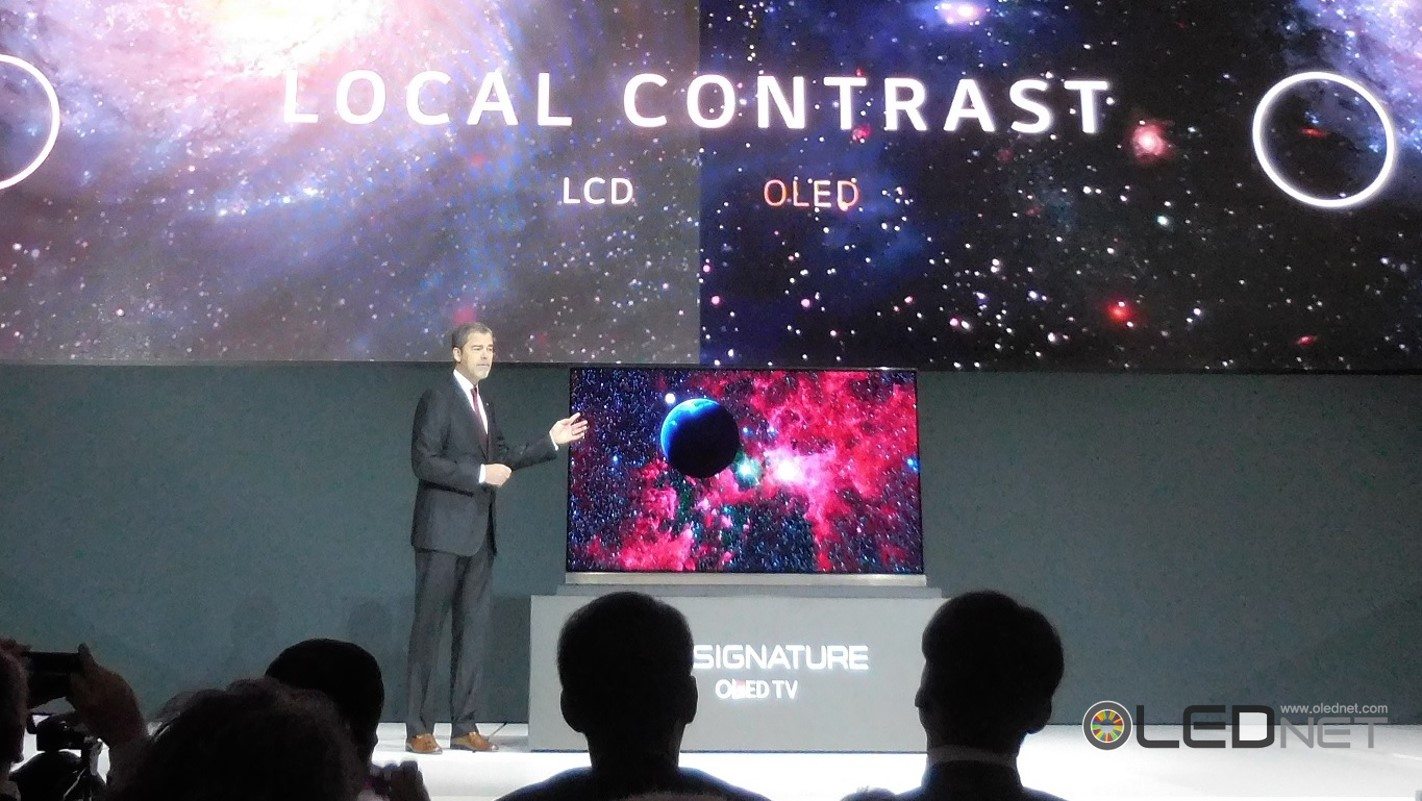
<LG Elec. is Introducing OLED TV in CES 2016>
Within the TV market, there is an opinion that even Samsung Electronics which believes it is not yet the time for OLED panel cannot continue to insist on LCD. Experts estimate that even if it is the same OLED TV, Samsung Elec. will differentiate the actualization method from competitors’ including LG Electronics. One of the possibilities suggested is Samsung’s selection of ink-jet printed OLED TV panel.
Hyun-Suk Kim, Samsung Elec. Visual Display department’s vice president, who recently announced new LCD based SUHD TV mentioned that OLED TV is premature and also needs technological improvements.
However, it looks to be difficult for Samsung to insist on LCD TV only in the long term. China is threatening Korean companies in LCD panel market with superior price competitiveness; there is too much risk for Korean display companies such as Samsung Display to invest further in LCD production line. Although Samsung Elec. is not receiving panel supply exclusively from Samsung Display, Samsung Display is the biggest supplier. Therefore, Samsung Display’s LCD investment reduction is also expected to affect Samsung Elec.’s TV business.
Furthermore, Samsung Elec. is in the position of having to emphasize OLED’s superior picture quality over LCD in smartphone business, but highlight the opposite in TV. This is also an issue that needs to be tackled.
Despite these issues, Samsung cannot easily start on OLED TV as several problems such as price competitiveness have not been solved.

<Hyun-Suk Kim, Samsung Elec.’s Vice President, is Introducing New SUHD TV>
◆ Ink-jet Printing, Can it Solve OLED for TV Price Issue?
According to Dong-won Kim, analyst with Hyundai Securities, Samsung Display, with Samsung Elec. as the biggest client, has unfavorable structure for reducing production cost as 65 inch OLED TV panel production efficiency is low in Gen8 line.
Kim estimated that Samsung Display will apply solution process ink-jet printing technology to OLED TV with 2018 mass production target in order to solve this problem.
When producing OLED TV panel, WRGB OLED method, which uses evaporation method, can only reduce production cost by certain amount as the material usage efficiency is low. On the other hand, ink-jet printing RGB technology finely deposits ink in liquid form and can reduce materials cost. Additionally, RGB OLED has fewer organic layers compared to WRGB OLED and processes can be decreased.
For these reasons, some believe that Samsung will select ink-jet printing method rather than evaporation for OLED TV in future. There is also a view that LG Display, which is currently using evaporation method, will also actively consider producing ink-jet printed OLED TV panel in the long term.
A display expert explained that although ink-jet printing processes are simpler than evaporation method, that does not necessarily mean materials cost is always cheaper. The ink-jet printing technology is not yet perfect, and particularly for blue the efficiency issue has not yet been solved.
He added that Samsung Elec. has strong tendency to differentiate itself from competitors such as LG, and even if Samsung Elec. releases OLED TV, it is likely that ink-jet printing, which is different from LG, will be the preferred method.
“삼성, OLED TV 낸다 해도 LG와는 다르게”
/0 코멘트/카테고리: 기술, 세트 /작성자: OLEDNET강현주 기자/jjoo@olednet.com

OLEDNET이 다녀온 CES 2016에서 LG전자가 OLED TV제품을 소개하고 있다.
TV 시장에서 OLED 패널은 아직 아니라는 삼성전자도 끝까지 LCD를 고집할 수는 없을 것이라는 견해가 적잖이 나오고 있다. 단 같은 OLED TV라도 ‘구현 방식’에 있어서 LG 등 경쟁사와의 차별력을 분명히 할 것으로 전문가들은 내다본다. 하나의 가능성으로 삼성이 잉크젯 프린팅 방식의 OLED TV 패널을 선택할 것이라는 전망이 제기된다.
최근 LCD 기반 2세대 SUHD TV 신제품을 발표한 삼성전자 영상디스플레이(VD) 사업부 김현석 사장은 “OLED TV는 시기상조며 기술보완도 필요하다”고 언급했다.
하지만 장기적으로는 삼성이 LCD TV만 고수하긴 어려워 보인다. 중국이 LCD 패널 시장에서 뛰어난 가격 경쟁력으로 한국 업체들을 위협하는 상황이라 삼성디스플레이 등 한국의 디스플레이 기업이 더 이상 LCD 생산라인에 투자 하기에는 리스크가 크다. 삼성전자가 반드시 삼성디스플레이(SDC)로부터만 패널을 공급받는 것은 아니지만 SDC가 최대 공급처인 것은 사실이다. 이에 따라 SDC의 LCD 투자 축소는 삼성전자의 TV 사업에도 영향을 줄 것으로 보인다.
게다가 삼성전자는 스마트폰 사업에서는 OLED가 LCD보다 화질이 뛰어남을 강조하면서 TV 사업에서는 그 반대를 주장해야 하는 상황이라 이 역시 타계해야 할 문제다.
그럼에도 삼성이 섣불리 OLED TV 분야에 시동을 걸기 힘든 이유는 가격 경쟁력 등의 문제가 미해결이기 때문이다.

삼성전자 김현석 사장이 SUHD TV 신제품을 소개하고 있다.
◆잉크젯 프린팅, TV용 OLED 가격문제 해결사 될까?
현대증권의 김동원 연구원에 따르면 삼성전자를 최대 고객사로 두고 있는 삼성디스플레이의 경우 8세대 라인에서 65인치 OLED TV 패널 생산효율이 낮아 원가를 낮추는 데 불리한 구조다.
김 연구원은 “이 문제를 해결하기 위해 삼성디스플레이가 2018년 양산 목표로 용액공정의 잉크젯 프린팅 기술을 OLED TV에 적용할 것”이라고 전망했다.
TV용 OLED 패널을 생산하는 데 있어서 증착공정을 사용하는 화이트(WRGB OLED) 방식은 재료 사용 효율이 낮아 원가를 줄이는 데 한계가 있다. 반면 잉크젯 프린팅(Inkjet Printing RGB) 기술은 용액 형태의 잉크를 노즐을 통해 미세 분사하기 때문에 재료비 절감이 가능하다. 또한 RGB OLED는 WRGB OLED에 비해 적층되는 유기물 층 수가 적어 공정 단축이 가능하다.
이에 삼성이 향후 OLED TV에 증착방식이 아닌 잉크젯 프린팅 방식을 선택할 것이라는 시나리오가 나온다. 일각에서는 현재 증착 방식을 이용하는 LG디스플레이 역시 장기적으로 잉크젯 프린팅 방식의 TV용 OLED 패널 생산을 적극 검토할 것이라 보고 있다.
디스플레이 업계 한 전문가는 “증착 방식에 비해 잉크젯 방식이 공정 과정이 간단하다는 점은 있지만 재료 자체 비용이 무조건 더 저렴하다는 보장은 없다”며 “또 잉크젯 프린팅 방식의 기술력이 아직은 완벽하지 않으며 특히 블루(blue) 부분에서의 비효율이 해결되지 않은 상태다”라고 설명했다.
그는 “하지만 그동안 삼성전자의 행적들을 돌아보면 LG같은 경쟁사와 똑같지 않게 함으로써 차별력을 분명히 하려는 경향이 강한만큼 OLED TV를 출시한다 해도 LG와 다른 잉크젯 방식을 선호할 것으로 보인다”라고 덧붙였다.
LG Electronics Launches 58:9 Signage…Transforms Columns and Corners to Billboards
/0 코멘트/카테고리: 미분류 /작성자: OLEDNETHyunjoo Kang, Reporter, OLEDNET

<LG Elec. Launched 58:9 Ultra Stretch Signage. Source: LG Elec.>
On March 23, LG Electronics launched world’s first 86 inch 58:9 commercial display Ultra Stretch.
Ultra Stretch signage allows places which have been difficult to install signage, such as columns and corners, to be used as billboards.
LG Elec.’s Ultra Stretch has the widest screen ratio of the signage released. The display is 2,158 mm wide and 349 mm long, and can be installed horizontally or vertically.
Ultra Stretch can be used on media pole, which is integrated into columns within buildings such as airports or hotels, and billboards above building entrances. Total of 16 units of Ultra Stretch, maximum 4 units lined horizontally and vertically, can be tiled. When installed on a separate stand, Ultra Stretch can be moved to where needed.
This product uses LG IPS panel, and with ultra HD resolution (3840 x 600), small writing as well as customary images are clearly shown. The IPS panel has wide viewing angle of 178°, and clean images can be viewed from any directions.
With consideration for commercial use of signage, it was designed to for easy editing of contents as well as other amenities. The display can be divided into 4 screens maximum and provide diverse information simultaneously.
For example, if installed in an airport, the display can be divided into 4 sections and each can show information such as weather, traffic information, news, advertisement, and others. This will allow foreign visitors to easily receive information.
SuperSign W media editor is equipped for easy transformation of existing contents to 58:9 ratio. Ultra Stretch also includes around 30 sample styles specific to the product.
LG Elec.’s Korean B2B Marketing representative explained that Ultra Stretch is a signage never been experienced and will lead the new commercial display market.
LG전자, 58:9 사이니지 출시…기둥, 모서리도 광고판으로
/0 코멘트/카테고리: 디스플레이, 포커스온 /작성자: OLEDNET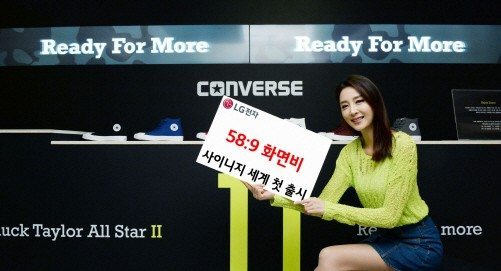
<LG전자가 58:9 화면비의 ‘울트라 스트레치 사이니지’를 출시했다. 출처=LG전자>
강현주 기자/OLEDNET
23일 LG전자가 58:9 화면비의 86형 상업용 디스플레이 ‘울트라 스트레치’를 세계 최초로 출시했다.
울트라스트레치 사이니지는 기둥, 모서리 등 사이니지를 설치하기 어려웠던 곳을 광고판으로 사용할 수 있게 해주는 제품이다.
LG전자가 이번에 내놓은 울트라 스트레치는 현재까지 출시된 사이니지 가운데 가장 와이드한 화면비를 갖췄다. 가로와 세로 길이가 각각 2158mm, 349mm며 가로 방향으로 넓게 혹은 세로 방향으로 길게 설치할 수 있다.
울트라 스트레치는 공항이나 호텔 등의 건물 내부에 있는 기둥 안에 매립해 사용하는 미디어 폴, 건물 출입문 위쪽의 광고판 등에 활용할 수 있다. 가로, 세로 각각 최대 4개씩 총 16개를 이어 붙일 수 있으며 별도의 거치대에 설치하면 필요한 장소를 오가면서 사용할 수 있다.
이 제품은 LG IPS 패널을 적용, 울트라HD급 해상도(3840ⅹ600)로 일반 영상뿐 아니라 작은 글자까지 선명하게 보여준다. IPS패널은 178도의 넓은 시야각으로 어느 위치에서도 화면이 또렷하다.
이와 함께 상업용으로 사용되는 사이니지의 특성을 고려해 쉽게 콘텐츠를 편집할 수 있는 편의 기능들도 탑재했다. 최대 4개의 화면으로 나눠 쓸 수 있어 다양한 정보를 한 번에 제공한다.
가령 공항에 설치할 경우 화면을 4개로 나눠 날씨, 교통 정보, 뉴스, 광고 등을 각각 보여줄 수 있어 외국인들도 필요한 정보를 쉽게 얻을 수 있다.
기존 콘텐츠를 58:9 화면비로 쉽게 편집할 수 있는 솔루션 ‘슈퍼사인 W’를 탑재했으며 ‘울트라 스트레치’ 전용 샘플 양식을 30여 개 내장했다.
김제훈 LG전자 한국B2B마케팅 FD(Function Division) 담당은 “지금까지 경험해보지 못했던 사이니지로 새로운 상업용 디스플레이 시장을 선도할 것”이라고 말했다.
[Analyst Column] CES 2016 Press Conference Comparison Analysis, Samsung Elec. TV vs. LG Elec. TV
/0 코멘트/카테고리: 디스플레이 /작성자: OLEDNETChoong Hoon Yi, Chief Analyst, UBI Research
When Samsung Electronics, CES’ most important company, holds a press conference, members of the media wait longer than an hour anticipating the new world the firm will show. For LG Electronics’ press conference, the waiting period is relatively shorter.
However, the press conferences at CES 2016 were not as anticipated. In CES and IFA, the representative of electronic appliances companies is TV. However, the TV in Samsung Electronics’ event was merely the same SUHD TV as shown before. Instead, ICT area, such as VR, USB adaptor, and Samsung Pay, was emphasized. During the last year’s CES, Samsung Electronics received much acclaim with curved design added SUHD TV. The only difference for this year’s TV from CES 2015’s was the text ‘Quantum Dot Display’ underneath the SUHD.
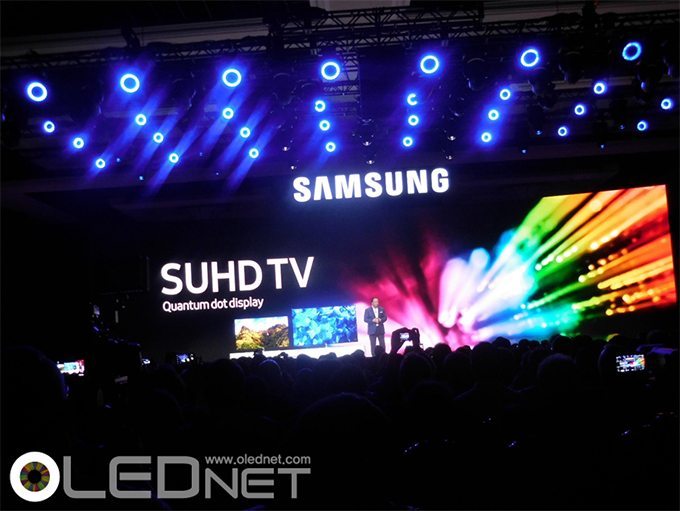
Samsung Electronics is considered the rule maker of the market with new designs and aggressive marketing. The fact that Samsung Electronics only added the words quantum dot to the already applied SUHD TV LCD panel is analyzed to be a desperate measure demonstrating the LCD TV’s development limitation.
On the other hand, during their press conference, LG Electronics provided a vision where the TV market can have another growth spurt through the introduction of the improved OLED TV with 800 nit peak brightness. Particularly, NASA’s video of vivid deep black of the space and dynamic fiery red of the sun on the OLED TV brought the audiences to cheer and applause. What could only have been seen by astronauts can now be seen by everyone through OLED TV. This was an event where everyone could feel what a true display really is.
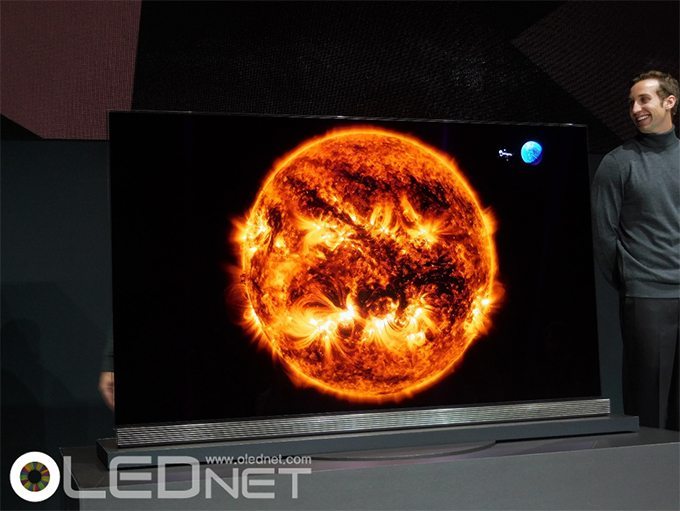
Of course, as the largest market of the consumer market is smartphone, it would be illogical to discuss Samsung Electronics and LG Electronics with only TV. However, Samsung Electronics’ smartphone business also remained stationery last year and all businesses, excluding semiconductor, is falling downward. As such, for Samsung fans who have high expectations it is of much concern.
The reason that the companies that led electronic appliance industry for the past half century such as Sony, Panasonic, and Toshiba are falling is because they did not have paradigm changing technology and product when the market was stalling. The same unfortunate sign is coming from Samsung Electronics.
Chinese set companies including TCL also brought quantum dot technology applied LCD TV to CES 2016. 8K TV was also exhibited. Although the picture quality control technology of the Chinese TV companies still falls short compared to companies such as Samsung Electronics, LC Electronics, and Sony, the set exterior reached similar standards and the price is less than 70% of the early starters’. The difference in the picture quality is difficult to distinguish for those who are not TV or display experts. The quality of Chinese products does not reflect the cheaper price, and cheap and good products are pouring in from China.
For Samsung Electronics that cannot produce OLED TV, in order to repeat the last year’s popularity in international events such as IFA in later this year, a big issue and product that can represent the company are urgently needed.
[Analyst Column] CES2016 press conference 비교 분석, 삼성전자 TV vs LG전자 TV
/0 코멘트/카테고리: 디스플레이, 세트, 애널리스트 칼럼, 포커스온 /작성자: OLEDNET이충훈/Chef Analyst, UBI Research
CES의 가장 중요한 업체인 삼성전자가 press conference를 할 때는 미디어들은 한 시간 이상을 줄 서서 기다리며 삼성전자 보여줄 새로운 세상을 기대한다. LG전자는 그다지 긴 줄이 아니기 때문에 대기 시간이 상대적으로 적다.
하지만 이번 CES2016 의 press conference는 모두의 기대치와 전혀 다르게 나타났다. CES와 IFA에서 가전 업체들의 얼굴 마담은 TV이다. 하지만 삼성전자의 행사에 보여진 TV는 이전과 똑 같은 SUHD로 끝나고 말았다. 대신에 VR과 USB Adaptor, Samsung Pay와 같은 ICT 분야가 부각되었다. CES2015에서는 curved design을 가미한 SUHD TV로서 환호성을 받았으나 달라진 점은 SUHD 글자 밑에 Quantum dot display라는 글자가 존재한 것뿐이었다.

새로운 디자인과 공격적인 마케팅으로 시장의 Rule Maker였던 삼성전자에서 이미 SUHD TV용 LCD 패널에 적용하고 있는 quantum dot이라는 용어만 덧 부쳐 나온 것은 LCD TV가 더 이상 좋아질 수 없음을 나타내는 고육지책인 것으로 분석 된다.
이에 비해 LG전자의 행사는 800nit peak brightness로 향상된 OLED TV가 등장 함으로서 TV 시장이 다시 한 번 성장할 수 있는 비전을 제시했다. 특히 NASA 촬영한 우주 속 태양의 깊은 black과 역동적인 태양의 붉은 색을 눈으로 보듯 생동감을 OLED TV로서 처음 접한 참관자들은 환호와 박수를 아끼지 않았다. 우주 비행사들만이 볼 수 있는 진정한 장면을 OLED TV로서 볼 수 있게 된 것이다. 진정한 디스플레이가 무엇임을 모두가 실감할 수 있는 자리였다.

물론 consumer market의 최대 시장은 smart phone이기 때문에 TV만 가지고서 삼성전자가 LG전자에 비해 이렇다 말하는 것은 어불성설이다. 하지만 삼성전자의 smart phone 사업 역시 작년에는 답보 상태에 머무르며 반도체를 제외한 전 사업이 하향 곡선을 거리고 있어 삼성전자에 기대치가 높은 수 많은 삼성 팬들은 우려가 심각하게 깊다.
실제로 지난 반세기 가전 산업을 이끌었던 Sony와 Panasonic, Toshiba 등이 모두 몰락의 길을 걷게 된 것은 시장이 정체되었을 때 패러다임을 바꿀 수 있는 기술과 제품이 없었기 때문이다. 이러한 나쁜 징조가 삼성전자에서 나타났다.
TCL을 비롯한 중국의 TV 세트 업체들 역시 모두 quantum dot 기술이 적용된 LCD TV를 CES2016에 들고 나왔다. 8K TV도 전시했다. 아직 중국 TV 업체들의 화질 컨트롤 기술이 삼성전자나 LG전자, Sony 등에 비해서는 부족한 것으로 보여지지만 세트 외관은 모두 대등한 수준에 도달했으며, 가격은 이들 선발 기업들의 70% 이하이다. TV나 디스플레이 전문가가 아니면 화질 차이를 구별하기 어렵다. “싼 것이 비지 떡”이 아니라 싸도 충분히 만족할 수 있는 좋은 제품들이 중국에서 홍수처럼 쏟아지고 있다.
OLED TV를 만들 수 없는 삼성전자가 하반기에 있을 IFA 등의 세계적인 행사에서 작년처럼 흥행을 유지하기 위해서는 확실한 얼굴 마담을 대체할 수 있는 초 대형 이슈와 제품이 시급하게 나와야 한다.
[CES 2016] Skyworth’s 2016 OLED TV Sales Target is 200,000 Units
/0 코멘트/카테고리: 디스플레이 /작성자: OLEDNETSkyworth, the most enthusiastic Chinses TV company, placed OLED TV on the front of the CES 2016 booth, the largest space.
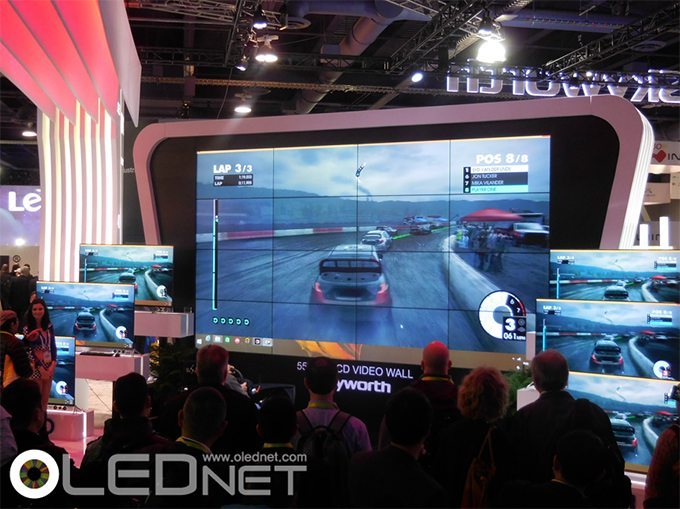
The exhibition concept, same as IFA 2015, was promotion of OLED TV’s superiority over LCD in terms of picture quality and fast response time through car racing game.
Furthermore, all OLED TVs exhibited this year are UHD resolution aiming for the premium TV market.
According to Skyworth, 2015 OLED TV sales performance is 45,000 units, with the target of 200,000 units in 2016. In 2015, the performance was weak as the OLED panel supply from LG Display was not smooth. However, compared to last year, in 2016 the panel supply from LG Display increased, and as OLED TV is a very popular product in Chinese market due to its superior picture quality compared to LCD the sales target of 2016 became much higher.
What is different about this exhibition is the fact that the video clip used in the Skyworth OLED TV booth is the same as the NASA video produced by LG Electronics for promotion. Previously, each companies presenting OLED TV used different contents on the screen. However, in this exhibition, by showing the same video of the sun within the space, they emphasized OLED TV’s superiority in contrast ratio and picture quality of black.
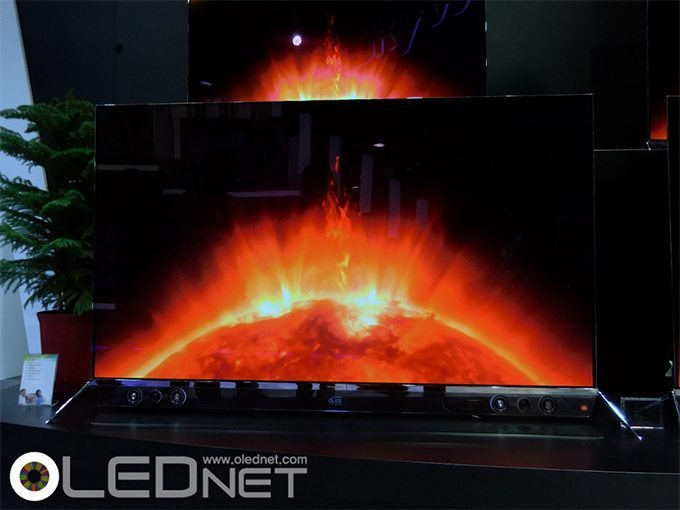
This is considered LG’s ecosystem strategy to secure OLED TV territory by sharing the video contents and increasing the consumers and attendees’ OLED TV awareness.
[CES2016] Skyworth, 올해 OLED TV 판매 목표는 20만대
/0 코멘트/카테고리: Exhibition, 디스플레이 /작성자: OLEDNET중국 TV 업체들 중 OLED TV 사업에 가장 적극적인 Skyworth는 CES2016 부스 전면에 그리고 가장 넓은 공간에 OLED TV를 배치하고 홍보에 나섰다.

전시 컨셉은 지난 IFA2015와 동일하였으며 LCD 대비 우수한 OLED TV의 화질과 빠른 response time을 자동차 레이싱 게임을 통해 홍보하였다.
이번 전시회에 출품된 OLED TV는 모두 UHD급으로서 premium TV 시장을 노린 전략으로 보인다.
Skyworth 관계자에 따르면 2015년 OLED TV 판매 실적은 45,000대 규모이며, 2016년 목표는 20만대라고 언급했다. 작년에는 LG디스플레이로부터 OLED 패널 공급이 원활하지 않아 실적이 낮았으나 올해는 작년에 비해 LG디스플레이로부터 패널 공급이 늘어났고 중국 시장에서 OLED가 LCD TV에 비해 화질이 우수하다는 점이 알려지면서 인기가 높아지고 있기 때문에 올해는 목표를 대폭 올렸다.
이번 전시회가 다른 전시회에 비해 차별화된 점은 Skyworth 부스에 전시된 OLED TV의 동영상이 LG전자가 홍보용으로 제작한 NASA의 영상을 같이 사용하고 있는 점이다. 이전에는 OLED TV를 전시하는 회사마다 서로 다른 컨텐츠를 사용하여 왔으나, 이번 전시회에는 우주 공간 속의 태양을 촬영한 영상을 동일하게 보여 줌으로서 OLED TV의 contrast ratio와 black 화질이 우수함을 강조하고 있다.

영상을 공유함으로써 고객과 참관자들의 OLED TV에 대한 인지도를 동시에 끌어 올리고 OLED TV 진영을 확보하기 위한 LG의 ecosystem 전략으로 분석된다.
[CES 2016] OLED TV Passes UHD Alliance Standards
/0 코멘트/카테고리: 미분류 /작성자: OLEDNET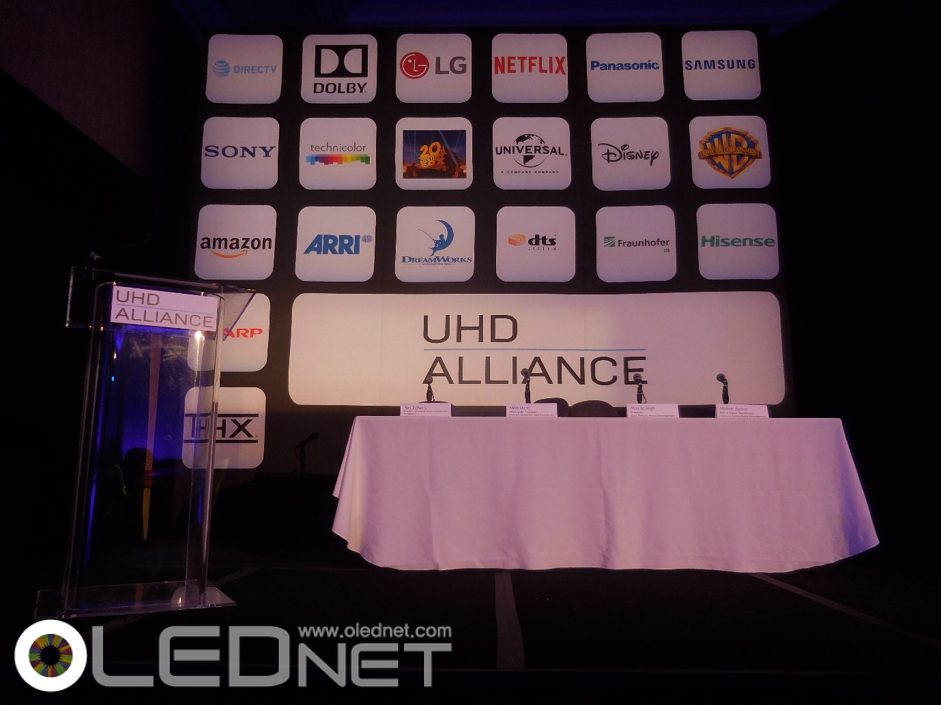
As a press event of CES 2016 (January 6-9), UHD Alliance, which was created by TV manufacturing companies, contents companies such as film studios, and picture and sound quality related companies to energize the declining TV market, gave a presentation on future UHD TV market and UHD Alliance activities.
The TV market recorded approximately 230 million units in 2015. However, this is 20 million units fewer than 2014’s 250 million, and CES reported that 2016 performance will be similar to 2015. 2016’s estimated UHD TV market, which is the premium market of 55 inch or larger, is 21% of the total TV market with approximately 48 million units.
The 4 key factors that UHD Alliance is pursuing in UHD TV are image resolution, color bit depth, color palate, and high dynamic range.
LCD TV and OLED TV that satisfy these factors are to be available from this year. In order to respond to OLED’s vivid color realization, LCD TV companies developed quantum technology. Also to draw near OLED’s contrast ratio of 1,000,000:1 they are continuing technology development, but the LCD contrast ratio remains around 3,000:1.
It is worth noting that UHD Alliance provided 2 HDR specs: more than 1,000 nits peak brightness at less than 0.05 nits black level, or 540 nits brightness with 0.0005 black level.
LG Electronics already achieved UHD Alliance’s HDR spec of 540 nit peak brightness last year, and this is analyzed to provide foundation for more invigorated future OLED TV market. Based on this, OLED TV is expected to be the main force within the UHD TV market.
Additionally, UBI Research estimated that 2016 OLED TV market will record 1,200,000 units.
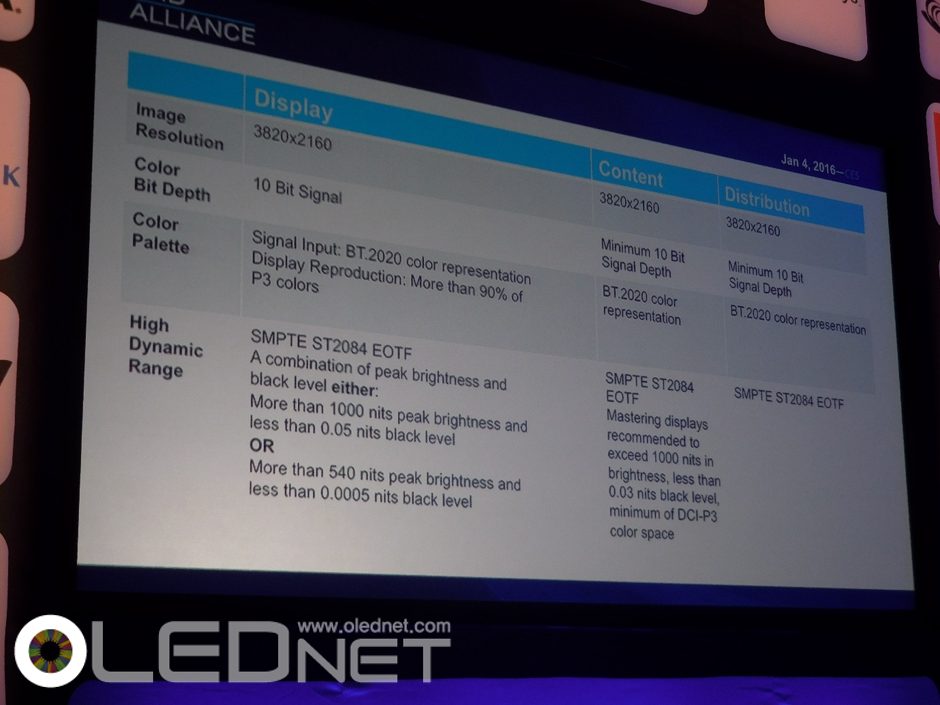
[CES2016] OLED TV, UHD Alliance 스펙 통과했다
/0 코멘트/카테고리: 세트, 시장 /작성자: OLEDNET
CES2016 프레스 이벤트로, 수축되어 가는 TV 시장에 활력을 불어넣기 위해 TV 제조 업체 들과 영화사 등의 콘텐츠 업체, 화질과 음질 관련 업체들이 모인, UHD Alliance에서 향후 UHD TV 시장과 UHD Alliance의 활용 내용에 대해 발표를 했다.
TV 시장은 2015년에 약 2억3천만대의 시장을 형성하였으나 2014년 2억5천만대에 비하면 2천만대가 감소하였으며, 2016년 역시 작년과 동일한 수준이 될 것으로 CES 관계자가 언급했다. 2016년 예상 55인치 이상 크기의 premium 시장인 UHD TV 시장은 전체 TV시장의 21%인 약 48백만대이다.
UHD Alliance가 추구하는 UHD TV의 주요 사양으로서는 image resolution과 color bit depth, color palate, high dynamic range 4개 요소이다.
이러한 사양을 만족시키는 LCD TV와 OLED TV가 올해부터 시판될 계획이다. LCD TV 업체들은 OLED가 가진 vivid한 color에 대응하기 위해 quantum technology를 개발하였고, 또한 OLED가 가진 1,000,000:1의 contrast ratio에 조금이라도 다가가기 위해 다양한 기술개발을 진행하고 있지만 아직은 3,000:1 수준이다.
주목할 사항은 UHD Alliance에서 2가지 HDR spec을 제시한 것이다. 1,000nit 이상의 peak brightness와 0.05nit 이하 black level 또는 540nit peak brightness와 0.0005nit black level으로 이다.
LG 전자는 OLED TV로 UHD Alliance가 요구하는 HDR spec인 540nit peak brightness를 이미 지난해 달성하였으며, 이는 향후 OLED TV 시장이 보다 활성화될 기반을 마련한 것으로 평가된다. 이를 바탕으로 OLED TV는 앞으로 UHD TV 시장의 주축이 될 것으로 전망된다.
한편 유비산업리서치에 따르면 2016년 OLED TV 시장은 120만대 규모가 될 것으로 전망하였다.

Reviewing 2015 OLED Industry through Keywords
/0 코멘트/카테고리: 디스플레이 /작성자: OLEDNET- OLED TV
OLED TV, first released in Q4 2013, recorded approximately 50,000 units of shipment each in Q1 and 2 this year. The shipment increased to 100,000 units in Q3, more than twice the amount of each quarter in H1 2015. As it is estimated that close to 200,000 units were released in Q4, over 90% of LG Display’s 2015 target is expected to be achieved. This is considered to be showing price competitiveness against other TV as the price of OLED TV fell to 1/2 of the initial price and effectiveness of aggressive marketing emphasizing the advantages of OLED TV compared to newly released LCD TV. In Q3 earnings results announcement, LG Display revealed their plan of 1,000,000 units of OLED TV panel shipment in 2016 and forecast OLED TV’s growth. For the industry, 2015 has been the year that secured foothold for OLED TV’s market expansion.
- Galaxy S6 Edge
At the time of Galaxy S6 and Galaxy S6 Edge’s release, Samsung Electronics estimated the initial supply to be 50:50. However, Galaxy S6 Edge showed 70% in actual demand and this led to shortage in supply. Samsung Display met the demand by starting flexible AMOLED line operation earlier than scheduled. 2015 proved future market growth potential by opening consumers’ wallets through designs possible only with flexible AMOLED panel.
- Samsung Display Supply Diversification
During the Q3 earnings announcement, Samsung Display revealed their plan to expand non-Samsung clients by 30%. Accordingly, in Q3, when smartphone market’s growth was expected to slow down, the sales performance improved by 13% compared to its previous quarter through key client’s new product release and expansion of client base. Particularly, the market occupation of AMOLED panel shipped toward China is analyzed to have increased within the global mobile market as Chinese set companies released AMOLED panel equipped smartphones.
- Apple’s OLED Application
Apple, which has been using LCD panel for all products, first applied flexible AMOLED panel, produced by LG Display, to 2015 smartwatch Apple Watch and drew much attention. In H2, Apple diversified suppliers by using Samsung Display’s flexible AMOLED panel. This move is analyzed to be groundwork for flexible OLED application to smartphone following smartwatch. 2015 has been a year with much interest in when flexible AMOLED panel equipped iPhone will be released.
- OLED Lighting
Global OLED lighting industry went through a great transformation in 2015. OLEDWorks announced they will acquire key parts of Philips’ OLED lighting business, relevant production facilities, and intellectual property. With this take over, OLEDWorks greatly expanded business through widened product portfolio and simultaneous lighting panel mass production in the US and Germany. LG Chem. transferred OLED lighting business to LG Display. The value of transfer is 1.6 billion KRW, and it is seen to be a strategy to increase competiveness by transferring the business to LG Display with their OLED panel mass production knowledge and to focus on existing materials business. The take over and business transfer of the main players in OLED lighting industry, OLEDWorks and LG Chem., are following their own business strategy. However, following these moves, related investment is expected to be delayed for some time and eyes are on how these will affect the OLED lighting business overall.
키워드로 돌아보는 2015 OLED 산업
/0 코멘트/카테고리: 디스플레이, 세트, 시장, 조명 /작성자: OLEDNET- OLED TV
2013년 4분기부터 출시된 OLED TV는 2015년 1, 2분기에 각 약 5만대가 출하되었고 3분기에 10만대가 출하되면서, 3분기에만 상반기 각 분기별 출하량의 약 두 배 이상을 출하했다. 또한 4분기에도 20만대 가까이 출하한 것으로 예상되어 LG Display의 2015년 목표의 약 90%이상이 달성될 것으로 예상된다. 이는 OLED TV의 가격이 초기 가격의 절반 가량으로 하락하면서 다른 TV와의 가격 경쟁력이 생겼고, 새롭게 출시되는 LCD TV보다 OLED TV의 장점을 부각시키는 공격적인 마케팅이 시장에서 발휘되고 있다는 신호로 보인다. LG Display는 지난 3분기 실적발표회에서 2016년 OLED TV용 패널 출하량을 100만대로 발표하면서 OLED TV의 성장을 예고했다. 업계 관계자들에게 2015년은 OLED TV의 시장 확대의 발판을 마련한 시기였다.
- Galaxy S6 Edge
Samsung Elec.은 Galaxy S6와 Galaxy S6 Edge를 출시할 당시 초기 물량을 5대5로 예상했었다. 하지만 실제 수요량에서 Galaxy S6 Edge가 70%를 차지하면서 공급 부족 현상이 일어났다. 때문에 Samsung Display에서 flexible용 AMOLED line을 예상 시점보다 앞당겨 가동하여 수요량을 충족시킬 수 있었다. 2015년은 flexible AMOLED 패널로만 구현할 수 있는 디자인으로 소비자들의 지갑을 열게 하여 앞으로 시장 성장성을 증명해 준 한 해였다.
- Samsung Display 공급 다변화
Samsung Display는 지난 3분기 실적발표회에서 외부 거래선을 30% 확대할 계획을 밝혔다. 이에 따라 smart phone 시장의 성장 둔화가 예상되었던 3분기에 주요 거래선의 신제품 출시와 공급처 확장을 통해 매출 기준 지난 분기 대비 13% 성장의 실적 개선을 이루었다. 특히 중국향 AMOLED 패널은 중국 set 업체들의 AMOLED 패널을 탑재한 smart phone의 출시가 되면서, 세계 모바일 시장에서 점유율이 늘어난 것으로 분석된다. 2015년의 Samsung Display 공급 다변화는 Samsung Display의 실적을 다시 성장세로 올리면서 AMOLED 패널이 모바일 display 시장 규모를 확대할 수 있었다.
- Apple OLED 적용
지금까지 모든 제품에 LCD 패널을 적용해왔던 Apple이 2015년에 출시된 smart watch제품인 Apple watch에 LG Display의 flexible AMOLED 패널을 처음으로 적용하여 큰 관심을 모았으며, 하반기에는 Samsung Display의 flexible AMOLED 패널도 공급받음으로써 공급업체 다변화를 이루었다. Smart watch에 이어서 smart phone에도 flexible OLED를 적용하기 위한 포석으로 분석되며, flexible AMOLED 패널이 적용된 iPhone의 출시 시점에 대한 관심이 높았던 한 해였다.
- OLED Lighting
2015년 전세계 OLED 조명 산업은 큰 변화를 겪었다. OLEDWorks는 Philips의 OLED lighting 핵심 사업부와 관련된 생산시설, 지적 재산권을 인수한다고 발표했다. 이번 인수로 제품 포트폴리오를 넓히고 미국과 독일에서 동시에 조명 패널을 양산하는 등 사업규모를 크게 확장했다. 또한 LG Chem.은 OLED 조명 사업을 LG Display에 양도했다. 양도가액은 1,600억원으로 OLED 패널 양산에 대한 노하우가 풍부한 LG Display에 관련 사업을 이관해 경쟁력을 높이고 기존 소재 사업에 더 집중하겠다는 전략으로 분석된다. OLED 조명 산업의 main player인 LG Chem.과 OLEDWorks의 사업 양도와 인수는 각 사업전략에 따른 것이지만 이에 따라 당분간은 관련된 투자가 지연될 것으로 보이며 이런 움직임들이 OLED 조명 산업 전반에 어떤 영향을 줄지 관심이 모아지고 있다.
[Analyst Column] LCD Industry Administration to Worsen after 3 Years
/0 코멘트/카테고리: 미분류 /작성자: OLEDNETChoong Hoon Yi, Chief Analyst, UBI Research
BOE is intending to carry out a large amount of investment in order to operate Gen10.5 LCD line from 2018. Meanwhile, key set makers including Apple, Samsung Electronics, LG Electronics, and Panasonic are devising strategy to move from LCD to OLED for smartphone and premium TV displays. As such, it is becoming more likely for the LCD industry to be in slump from 2018.
At present, the area where LCD industry can create profit is LTPS-LCD for smartphone. The forecast smartphone market for this year is approximately 15 billion units. Of this, Samsung Electronics and Apple are occupying 20% and 15% of the market respectively. OLED equipped units are less than 2 billion.
However, from 2018 the conditions change greatly. Firstly, Apple, which has been using LCD panel only, is estimated to change approximately 40% of the display to OLED from 2017 earliest and 2018 latest. Apple is testing flexible OLED panels of JDI, LG Display, and Samsung Display, and recommending them to invest so flexible OLED can be applied to iPhone from 2017. The total capa. Is 60K at Gen6. As new investments for Gen6 line of Samsung Display and LG Display are expected to be carried out from 2016, supply is theoretically possible from 2017.
If 5inch flexible OLED is produced from Gen6 line, under the assumption of 50% yield at 60K capa. 65 million units can be produced annually, and approximately 1 billion units if the yield is 80%. If Apple’s iPhone shipment in 2017 is estimated to be around 2.7 billion units, within the 50-60% yield range approximately 25% of the display is changed to OLED from LCD, and if yield reaches 80% around 40% will change. The companies that are supplying Apple with LCD for smartphone, LG Display, JDI, and Sharp, are expected to show considerable fall in sales and business. These 3 companies could be reduced to deficit financial structure just from Apple’s display change
Furthermore, as Apple is not producing low-priced phones, under the assumption that future iPhone could all have OLED display, Apple could cause the mobile device LCD industry to stumble after 3 years.
Samsung Electronics also is gradually changing Galaxy series display to OLED from LCD. Of the forecast 2015 shipment of 3 billion units, 50%, 1.5 billion units, has OLED display, but Samsung Electronics is expected to increase flexible OLED and rigid OLED equipped products in future. Particularly, as Apple is pushing for flexible OLED application from 2017, Samsung Electronics, whose utilizing OLED as the main force, is estimated to increase flexible OLED usage more than Apple. It is estimated that all Galaxy series product displays will be changed to OLED from 2019.
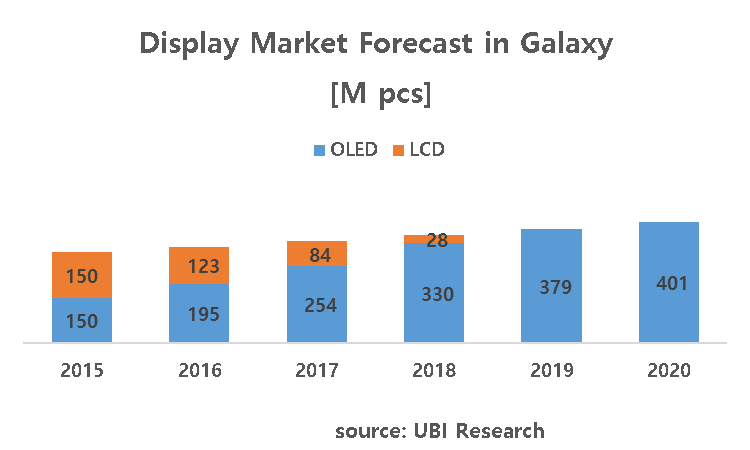
Under these assumptions, of the estimated smartphone market in 2020 of approximately 20 billion units, Samsung Electronics and Apple’s forecast markets’ 7 billion could be considered to use OLED.
Samsung Display is strengthening supply chain of set companies using their OLED panels. Samsung Display is supplying OLED panels to diverse companies such as Motorola and Huawei as well as Samsung Electronics, and also expected to supply rapidly rising Xiaomi from 2016. If smartphone display is swiftly changed to OLED from LCD from 2017, Chinese display companies that are currently expanding TFT-LCD lines are to be adversely affected.
Additionally, in the premium TV market, LG Electronics mentioned that they will focus on OLED TV industry at this year’s IFA2015. As a part of this, LG Display is planning to expand the current Gen8 34K to 60K by the end of next year. Furthermore, in order to respond to the 65inch market, Gen9.5 line investment is in consideration. In the early 2015, Panasonic commented that they were to withdraw from TV business but changed strategy with new plans of placing OLED TV on the market in Japan and Europe from next year.
As Samsung can no longer be disconnected from the OLED TV business, there are reports of investment for Gen8 OLED for TV line in 2016. Although OLED TV market is estimated to be approximately 350 thousand units this year, in 2016, when Panasonic joins in, it is expected to expand to 1.2 million units. The OLED TV’s market share in ≥55inch TV market is estimated to be only 4% but in premium TV market it is estimated to be significant value of ≥10%.
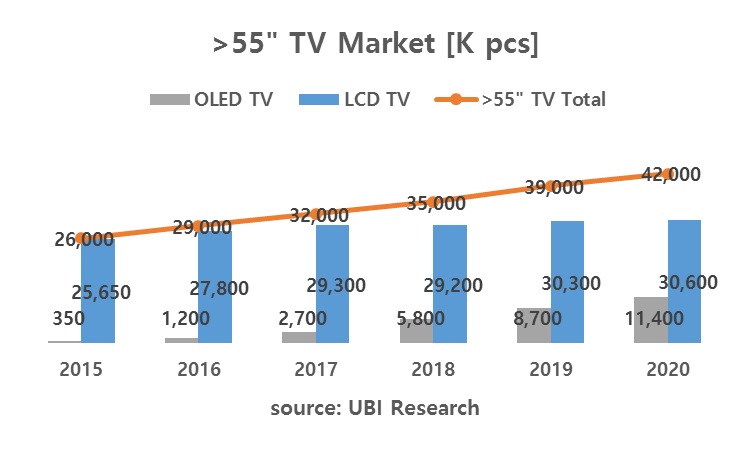
If Samsung Display invests in Gen8 OLED for TV line in 2016, from H2 2017 supply to Samsung Electronics is possible. As OLED Gen8 line’s minimum investment has to be over 60K to break even, it can be estimated that Samsung Display will invest at least 60K continuously in future.
Under these conditions, LCD industry can only be in crisis. Firstly, it becomes difficult for Sharp to last. Sharp, which is supplying TFT-LCD for Apple’s iPhones and LCD for Samsung Electronics’ TV, will lose key customers. Secondly, BOE, AUO, and JDI, the companies selling LCD panels to these companies, are not ready to produce OLED and therefore damage is inevitable.
BOE is carrying out aggressive investment with plans to lead the display industry in future with operation of Gen10.5 LCD line. Therefore, from 2018, as the main cash cow items disappear, administration pressure could increase.
[Analyst Column] 3년뒤 LCD 업계 경영 악화 예상
/0 코멘트/카테고리: 애널리스트 칼럼, 포커스온 /작성자: OLEDNET이충훈, Chief Analyst, UBI Research
BOE가 2018년부터 Gen10.5 LCD 라인을 가동하기 위해 막대한 투자를 집행할 예정인 가운데 Apple과 삼성전자, LG전자, Panasonic 등 주요 세트 메이커들이 스마트폰용 디스플레이와 프리미엄 TV용 디스플레이를 LCD에서 OLED로 전환할 계획을 수립하고 있어 2018년 이후에는 LCD 업계에 불황이 닥칠 가능성이 높아지고 있다.
현재 LCD 업계에서 수익을 창출할 수 있는 부분은 스마트폰용 LTPS-LCD이다. 올해 스마트폰 예상 시장은 약 15억개이며 이중 삼성전자와 Apple이 각각 20%와 15%의 시장을 점유하고 있다. OLED가 사용되는 부분은 2억개 미만이다.
하지만 2018년 이후에는 양상이 많이 달라지게 된다. 우선 LCD 패널만 사용하던 Apple이 빠르면 2017년, 늦어도 2018년부터는 디스플레이 물량의 40% 정도를 OLED로 전환할 것으로 예상된다. Apple은 JDI와 LG디스플레이, 삼성디스플레이의 flexible OLED 패널을 테스트 중에 있으며, 이들 3개사에게 2017년부터 iPhone에 flexible OLED를 채택할 수 있도록 투자를 권유하고 있다. 총 Capa.는 Gen6 기준 60K이다. 삼성디스플레이와 LG디스플레이의 Gen6 라인 신규 투자가 모두 2016년부터 진행될 예정이기 때문에 이론적으로는 2017년부터 물량 공급이 가능하다.

출처) UBI Research database
Gen6 라인에서 5인치 flexible OLED를 생산할 경우 60K Capa.에서 수율을 50%로 가정하면 연 65백만개가 생산 가능하며 80%로 가정하면 약 1억개가 나올 수 있다. Apple의 2017년 iPhone 예상 출하량을 2.7억대로 추산하면 50~60% 수율 범위내에서는 약 25%의 디스플레이가 LCD에서 OLED로 바뀌게 되며, 수율이 80%에 도달하면 40% 정도의 교체가 발생한다. Apple에 스마트폰용 LCD를 공급하고 있는 LG디스플레이와 JDI, Sharp는 매출과 영업 이익에 큰 악영향을 받게 된다. Apple의 디스플레이 교체만으로도 이들 3개사의 사업은 적자 구조로 돌아 설 수도 있다.
더욱이 Apple은 저가폰은 생산하지 않고 있어 추후 iPhone의 모든 디스플레이가 OLED로 바뀔 수도 있음을 가정하면 Apple에 의해 모바일 기기용 LCD 업계는 3년후부터 사업이 휘청거릴 수 있다.
삼성전자 역시 갤럭시에 사용하는 LCD를 점차 OLED로 전환하고 있는 추세이다. 2015년은 예상 출하량 3억대 중 50%인 1.5억개에 OLED를 탑재하고 있으나 추후 flexible OLED와 rigid OLED 탑재 물량을 늘려 나갈 것으로 예상된다. 특히 Apple이 2017년부터 flexible OLED 탑재를 추진하고 있어 OLED를 주력으로 삼고 있는 삼성전자는 Apple 보다 flexible OLED 사용을 늘릴 것으로 전망되며 2019년부터는 갤럭시의 모든 디스플레이가 OLED로 전환될 것으로 예상되고 있다.

이러한 가정하에서는 2020년 예상 스마트폰 시장 약 20억개에서 삼성전자와 Apple의 예상 시장 7억개가 OLED를 사용할 수 있다고 볼 수 있다.
삼성디스플레이는 자사가 생산하고 있는 OLED를 사용할 세트 업체 진영을 강화하고 있다. 삼성전자 이외에 Motorola와 Huawei등 다양한 업체들에게 OLED 패널을 공급하고 있으며, 새로운 강자로 급부상하고 있는 Xiaomi에도 2016년부터 OLED 패널을 공급할 예정이다. 2017년부터 스마트폰용 디스플레이가 LCD에서 OLED로 급 전환되면 현재 TFT-LCD 라인을 증설하고 있는 중국 디스플레이 업체들은 막대한 악영향이 시작될 것으로 예상된다.
또한 프리미엄 TV 시장에서는 LG전자가 올해 IFA2015에서 향후 OLED TV 사업에 집중할 것을 언급하였고, 이 일환으로 LG디스플레이는 현재 보유하고 있는 Gen8 34K를 내년까지는 60K로 확대할 계획이다. 더불어서 65인치 시장에 대응하기 위해 Gen9.5 라인 투자도 검토 중에 있다. Panasonic은 올해 초 TV 사업에서 철수 할 것으로 언급하였지만 계획을 수정하여 내년부터는 OLED TV를 일본과 유럽에 판매할 계획이다.
삼성 진영에서도 더 이상 OLED TV 사업에 손을 놓고 있을 수 없기 때문에 2016년에 TV용 Gen8 OLED 라인 투자에 대한 이야기가 가시화되고 있다. OLED TV 시장은 올해 약 35만대 수준에 불과할 것으로 전망되지만 Panasonic이 가세하는 2016년은 120만대까지 확대될 것으로 추정된다. 55인치 이상 TV 시장에서 OLED TV 점유율은 4%에 불과할 것으로 예상되지만 프리미엄 TV 시장에서는 10% 이상의 의미 있는 수치가 될 전망이다.

삼성디스플레이가 2016년 TV용 Gen8 OLED 라인을 투자하게 되면 2017년 후반부터는 삼성전자에 물량 공급이 가능해진다. OLED용 Gen8 라인은 최소 투자가 60K를 넘어야 손익분기점에 도달 할 수 있기 때문에 추후 삼성디스플레이는 최소 60K는 연속 투자 할 것이라고 가늠할 수 있다.
이러한 상황에서는 LCD 업계는 비상이 걸릴 수 밖에 없다. 첫번째로는 Sharp가 더 이상 버티기 어려워진다. Apple에 iPhone용 TFT-LCD를 삼성전자에 TV용 LCD를 공급하고 있는 Sharp는 주요 고객을 잃게 되기 때문이다. 두번째로 이들 업체들에게 LCD 패널을 판매하고 있는 BOE와 AUO, JDI 역시 OLED 생산 준비가 되어 있지 않기 때문에 타격은 불가피하다.
BOE는 Gen10.5 라인 가동으로 향후 디스플레이 업계에서 선두 주자로 도약할 계획을 가지고 공격적인 투자를 진행하고 있어 2018년 이후에는 오히려 주요 cash cow가 사라져 경영 압박이 가중될 수 있다.
LG Electronics Bets on OLED TV
/0 코멘트/카테고리: 디스플레이 /작성자: OLEDNETLG Electronics actively began aggressive marketing for OLED TV.
In IMID Exhibition (October 14-16), LG Electronics installed an OLED comparison experience zone to allow the visitors to see OLED TV and LCD TV at once. This direct comparison exhibition with OLED and LCD is the 2nd one after one in WIS 2015. In this exhibition in IMID Exhibition 2015, LG Electronics presented their new 2015 release 55inch UHD LCD TV and 55inch UHD OLED TV. This is considered a reflection of LG Electronics’ determination to target the market through OLED TV rather than LCD TV.
LCD TV is illuminated through BLU and therefore difficult to achieve perfect black. Through IMID Exhibition 2015’s comparison experience zone, LG Electronics emphasized OLED TV’s merits such as perfect black, perfect viewing angle, and ultra slim design.
Since the release of OLED TV, LG Electronics continued presentations that emphasized OLED TV’s advantages in diverse exhibitions. However, recently they are pursuing aggressive promotion focusing on OLED even exhibiting comparison against their own latest LCD TV. On the other hand, their rival Samsung Electronics is maintaining their 2-track strategy of using OLED and LCD in different applications each. The industry is focused on how these development will affect the large area TV market.
Samsung and LG’s Shared Vision for OLED
/0 코멘트/카테고리: 디스플레이 /작성자: OLEDNETOn the first day of OLEDs World Summit (October 27-29) held in Berkeley, USA, Samsung Display and LG Display gave their talks back to back. Samsung Display’s Vice President Chang Hoon Lee and LG Display’s Joo Soo Lim discussed their thoughts on OLED under the titles of ‘The Future of OLEDs’ and ‘A Future Game Changer’ respectively.
Samsung Display’s Lee, who gave his presentation first, reiterated Samsung Display’s leadership position in the mobile market and how Samsung Electronics’ recent mobile display reflects this. Comparing RGB pixel structure and their own diamond pixel structure, Lee drew comparison between human eyes and diamond pixels; due to cell distribution in eyes, humans are more sensitive to green colors and that diamond pixels reflect this by having twice as many green subpixels as blue and red ones. The diamond pixels also maximize the sub-pixel packing and increases the PPI.
Regarding the advantages of OLED display, Lee gave 2 examples using Samsung Electronics’ latest smartphone models. Utilizing the fact that selective control of each pixel is possible in AMOLED displays, Samsung provided Vision Aid to help people with color blindness. OLED’s ability to achieve total black is used in Super Dimming function where screen brightness can be reduced to 2nits to be used in the dark environment.
LG Display’s Lim revealed that an adult in the US spends 9 hours 40 minutes a day on average looking at one form of display or another. Highlighting the need and importance of quality display, Lim also discussed advantages of OLED display over LCD such as total black, 3D effects, and color gamut.
As the future OLED display, Both Lee and Lim placed slightly more emphasis on flexible (plastic) OLED than transparent or mirror display. Samsung Display discussed requirements necessary for a successful flexible display in more depth touching on the need for suitable cover window, flexible touch (sensor), flexible encapsulation, and flexible backplane. On the other hand, LG Display discussed flexible display’s design freedom and its influences on the wearable, mobile, and automotive markets. Lim also placed much importance on how flexible OLED can be used in virtual reality display market. The 2 speakers ended their talks affirming the need for new display market and innovation through OLED technology and new applications.
The presentations given by the 2 apparent leaders in the OLED display industry were remarkably similar with both speakers underlining major points of OLED in broad strokes. The need for solutions for future OLED, whether it be flexible, transparent, or mirror display, through innovation and technological advances is an absolute truth if not maybe too obvious. There also may be some comfort to be had in the shared vision within the OLED community. However, it is also a fact that numerous attendees of the conference commented on the similarities of the 2 presentations and the lack of any surprises.
LG전자, OLED TV로 승부수 던지다.
/0 코멘트/카테고리: Exhibition, 디스플레이 /작성자: OLEDNETLG전자가 OLED TV에 대한 공격적인 마케팅을 본격적으로 시작했다.
LG전자는 10월 14일부터 16일까지 진행되는 IMID 전시회에서 OLED 비교 체험존을 설치해 OLED TV와 LCD TV를 한눈에 비교할 수 있게 하였다. OLED와 LCD의 직접적인 비교 전시는 WIS 2015에 이은 2번째 전시이며, 이번 IMID 2015 전시회에서는 LG전자의 2015년형 신제품인 55inch UHD LCD TV와 55inch UHD OLED TV를 직접 비교했다. 이는 앞으로 LCD TV보다 OLED TV에 힘을 실어 시장을 공략하겠다는 LG전자의 의지로 비쳐진다.
LCD TV는 BLU를 통해 빛을 비추기 때문에 완벽한 black 구현이 힘들다. LG전자는 이번 IMID 2015 비교체험존을 통해 완벽한 블랙, 완벽한 시야각, 초슬림 디자인이 가능한 OLED TV의 장점들을 강조했다.
LG전자는 OLED TV 출시 후 다양한 전시회에서 OLED TV의 장점을 강조하는 전시를 지속해왔지만 최근에는 자사의 최신 LCD TV와 비교하여 전시할 정도로 OLED에 중점을 둔 공격적인 홍보를 이어가고 있다. 반면 경쟁사인 삼성은 OLED와 LCD 각각을 다른 application에 적용해 시장에 공개하는 2-track 전략을 고수하고 있어 앞으로의 대면적 TV 시장의 판도가 어떻게 변할지 업계의 관심이 쏠리고 있다.
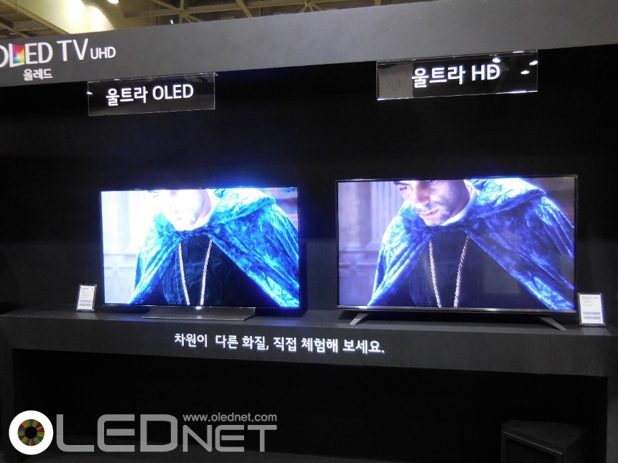
2015 IMID 전시회, OLED 비교 체험존, LG디스플레이
LG UHD OLED TV Price Falls Once More
/0 코멘트/카테고리: 디스플레이 /작성자: OLEDNETThe price of OLED TV by LG Electronics is falling fast. The 55inch flat UHD OLED TV (55EF9500), released last month, fell to $3,999 in 3 weeks, a 27% decrease from the initial $5,499. This price decrease is much faster than that of LG Electronics’ curved model of 55inch UHD OLED TV released in April.
Samsung Electronics’ 55inch SUHD TV, UN55JS9000, showed approximately over $2,500 price difference in comparison with 55EF9500 between the 1st week and the 2nd week of September. However, in the 3rd week, UN55JS9000 and 55EF9500 each showed 4% and 15% of decrease rate to record $2,497 and $3,999 respectively, with approximately $1,500 difference. This is the highest reduction rate for LG Electronics’ OLED TV.
In addition to the price reduction, LG Electronics is marketing their products aggressively. They are in the process of installing OLED TV this month in 39 key airports in 23 countries including the US, Germany, and Russia, with plans to install approximately 200 units of OLED TV by the end of October.
LG UHD OLED TV가격, 또 하락
/0 코멘트/카테고리: 디스플레이, 시장 /작성자: OLEDNETLG전자의 OLED TV 가격이 빠르게 하락하고 있다. 지난달 출시한 55인치 Flat UHD OLED TV(55EF9500)는 출고가 $ 5,499에서 3주만에 27% 하락한 $ 3,999를 기록했다. LG전자가 출시한 55인치 UHD OLED TV 중 4월에 출시한 Curved 모델보다 월등히 빠른 속도로 하락했다.
삼성전자가 출시한 55인치 SUHD TV인 UN55JS9000는 9월 1주차와 2주차에는 55EF9500과 비교하여 약 $2,500 이상의 차이를 보였다. 하지만 3주차에 UN55JS9000과 55EF9500은 각각 주별 평균 하락률 4%, 15%를 보이며 $ 2,497, $ 3,999까지 하락하여 약 $ 1,500 차이를 기록했다. 기존 LG전자 OLED TV중 가장 높은 가격하락률이다.
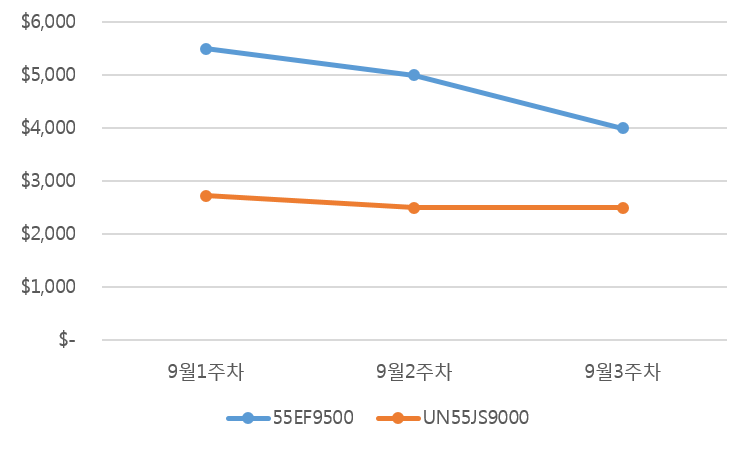
한편 LG전자는 가격 하락뿐만 아니라 마케팅도 공격적으로 하고 있다. 이달 들어 미국, 독일, 러시아 등 23개국 39개 주요 공항에 OLED TV를 설치하고 있다. 10월 말까지 200여 대의 OLED TV 설치하겠다는 계획이다
OLED TV, Pay Attention to China and UHD
/0 코멘트/카테고리: 디스플레이 /작성자: OLEDNETIFA 2015 that opened on September 4, closed its curtains on 9. This year’s IFA was similar to IFA 2014 in terms of diverse OLED TV exhibition, but when analyzed in detail there were several differences.
First, the emphasis on UHD TV greatly increased. The percentage of UHD resolution of exhibited OLED TV was approximately 71% in IFA 2013, and 70% in IFA 2014. However, in IFA 2015, the percentage increased to approximately 92%. If the main theme for IFA 2014 was curved OLED TV products, UHD was the keyword for IFA 2015.
Another important factor is increasing participation by Chinese companies. In IFA 2013, only Haier exhibited OLED TV but this increased to 2 companies, Changhong and TCL, in IFA 2014. In IFA 2015, 3 companies, Haier, Changhong, and Skyworth, presented OLED TV. It is estimated that the OLED TV exhibition attendance by Chinese electronics companies will continue to consistently increase.
There is much attention on how many more Chinese companies will participate with OLED TV in IFA next year, and whether a new keyword following UHD will appear. Although IFA 2015 ended, OLED TV market continues to move.
OLED TV, China와 UHD에 주목하라.
/0 코멘트/카테고리: Exhibition, 디스플레이 /작성자: OLEDNET9월 4일에 개최된 IFA 2015가 9일 모든 일정을 마쳤다. 이번 IFA 2015는 다양한 OLED TV 제품이 전시되었고 큰 주목을 끌었다는 점에서 지난 IFA와 비슷했지만 구체적으로 분석하였을 때 몇 가지 차이가 있었다.
먼저, UHD TV의 비중이 크게 늘었다. IFA 2013에서는 전시된 OLED TV의 약 71%가, IFA 2014에서는 약 70%가 UHD 해상도였다면 IFA 2015에서는 약 92%가 UHD 해상도의 OLED TV를 전시했다. 작년 IFA 2014가 curved OLED TV 제품 전시가 주류를 이루었다면 IFA 2015의 키워드는 UHD라고 볼 수 있다.
또한 중국업체의 참여가 늘어간다는 것도 주목해야 할 점이다. IFA 2013에서 Haier 단 한 업체만이 OLED TV를 출품하였지만, IFA 2014에서는 Changhong, TCL 두 업체가 참여했으며, IFA 2015에서는 Haier, Changhong, Skyworth 세 업체가 OLED TV를 전시하였다. 중국 전자 업체들의 OLED TV 전시 참가는 지속적으로 상승할 것으로 전망된다.
내년 IFA에서는 중국업체의 OLED TV 전시 참여 비중이 얼마나 더 늘어날지, UHD를 이은 새로운 OLED TV의 키워드가 등장할 지, 업계의 관심이 모아지고 있다. IFA 2015는 막을 내렸지만 OLED TV 시장은 지금도 끊임없이 움직이고 있다.
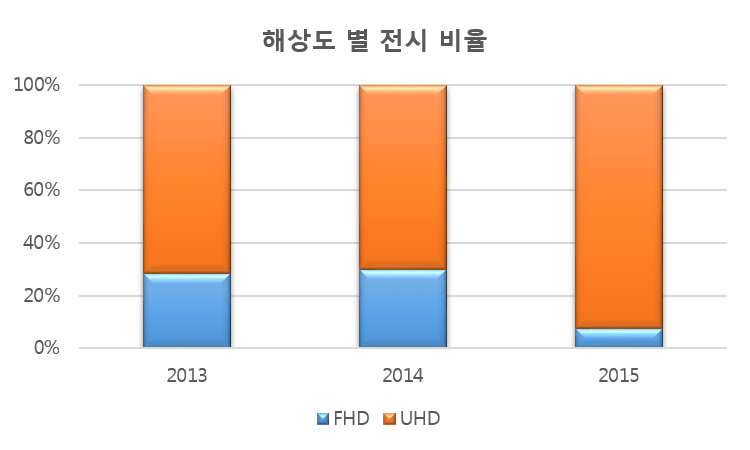
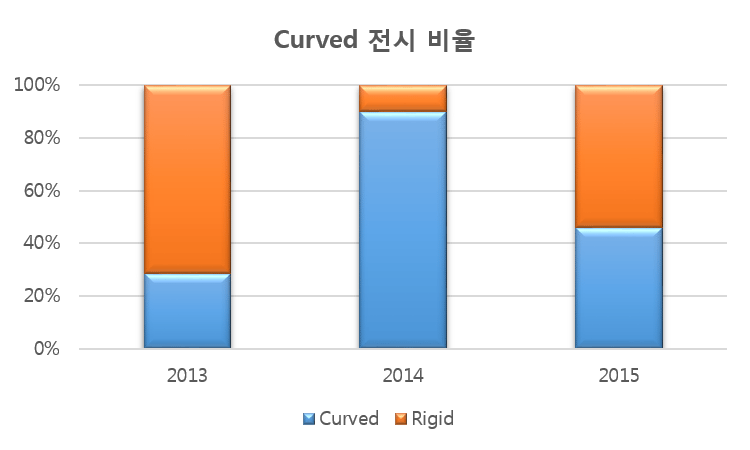

Minus Growth for H1 OLED Material Market with Mere US$ 564 Million*
/0 코멘트/카테고리: 디스플레이 /작성자: OLEDNETAccording to UBI Research, the 2015 H1 OLED material market recorded approximately US$ 564 million; this is a 14% increase compared to 2014 H2, but a 24% decrease against 2014 H1.
Despite reports that Samsung Electronics and LG Electronics are selling much larger volumes of flexible OLED applied Galaxy S6 Edge and OLED TV respectively compared to last year, the OLED material market is gradually stagnating.
The main reason for this OLED material market’s downward turn is Samsung Display’s operation level which remained stationary at 50% in H1. This led to stationary material usage compared to the year before. LG Display is producing flexible OLED and large size OLED panel for TV. However, approximately only 100,000 units of OLED panels were sold in H1 and material usage was also lowl. The current capa. is 34K but as the OLED material cost spent in H1 is approximately US$ 36 million, the operation rate is analyzed to be only 30% of the total capa.
The OLED material market is decreasing because the supply price is rapidly falling without increase in production volume. OLED material companies are frustrated at the 10-15% price decrease per quarter. At present, as the only clients are Samsung Display and LG Display, material companies are compelled to reduce the price as the failure to do so could lead toward the termination of business. OLED material companies spend several thousands of millions of dollars annually on development to meet constant improvement demanded by clients. There is much difficulty for OLED material companies as display companies continue with one-sided demands without compensation regarding development cost.
For OLED industry to maintain its continued growth, it requires more than success of panel companies. Material companies that play a pivotal part within the industry have to continue development and production of quality materials in order to create a healthy growth cycle. However, display companies are destroying the ecosystem.
What OLED material companies currently crave is for Chinese display companies to mass produce OLED panels as soon as possible.
* 1 USD = 1,100 KRW
상반기 OLED 발광재료 시장 2600억원에 불과한 마이너스 성장
/0 코멘트/카테고리: 디스플레이, 시장 /작성자: oled유비산업리서치에 따르면 올해 상반기 OLED 발광재료 시장 규모는 약 2600억원으로 전 반기대비 14% 상승했지만 전년 동기 대비 24% 감소했다.
올해에는 삼성전자가 flexible OLED를 탑재한 Galaxy S6 Edge를, LG전자에서는 OLED TV를 작년 보다 수십배 이상 판매하고 있다고 하지만 OLED 재료 시장은 점차 얼어 붙고 있는 실정이다.
OLED 재료 시장이 마이너스 성장으로 돌아 선 것은 무엇보다도 OLED 대표 기업인 삼성디스플레이의 상반기 가동율이 50% 수준에 머물러 재료 사용량이 전년 동 반기 대비 늘지 않았기 때문이다. LG디스플레이는 flexible OLED와 TV용 대형 OLED 패널을 생산하고 있지만 상반기 OLED 패널 판매는 약 10만대에 불과하여 재료 소모량 역시 얼마 되지 않는다. 전체 capa는 34K이지만 상반기 구매한 OLED 재료비는 약 400억원 정도에 불과하여 가동율이 전체 capa의 30%에 불과한 것으로 추정된다.
OLED 재료 시장이 줄어든 이유는 생산량 증가 없이 공급 가격만 심하게 깍이고 있기 때문이다. OLED 재료 업체들은 분기당 10~15% 가격이 인하되고 있다고 불만을 토로하고 있다. 현재로서는 수요 기업이 삼성디스플레이와 LG디스플레이 밖에 없는 실정이기 때문에 가격 인하에 불응하면 거래 자체가 단절될 수 있어 울며 겨자 먹기로 가격을 낮추고 있다. OLED 재료 업체들은 수요 기업들이 성능이 향상된 재료 개발을 끊임없이 요구하고 있어 연간 개발비가 수십억원 이상 소요되고 있지만 디스플레이 업체에서는 개발비에 대한 가격 보전 없이 일방적인 요구만 지속되고 있어 사업에 어려움이 심각하다.
OLED 산업이 지속 성장하기 위해서는 패널 업체만 살아서는 유지될 수 없다. 산업을 지탱하고 있는 한 축인 재료 업체들이 좋은 재료를 끊임없이 개발하고 생산해야지만 선순환 구조로 산업이 성장할 수 있다. 하지만 디스플레이 업체들은 생태계를 완전히 망가뜨리고 있다.
OLED 재료 업체들이 현재 가장 바라고 있는 것은 중국 디스플레이 업체들이 하루 속히 OLED를 대량으로 생산하는 것이다.
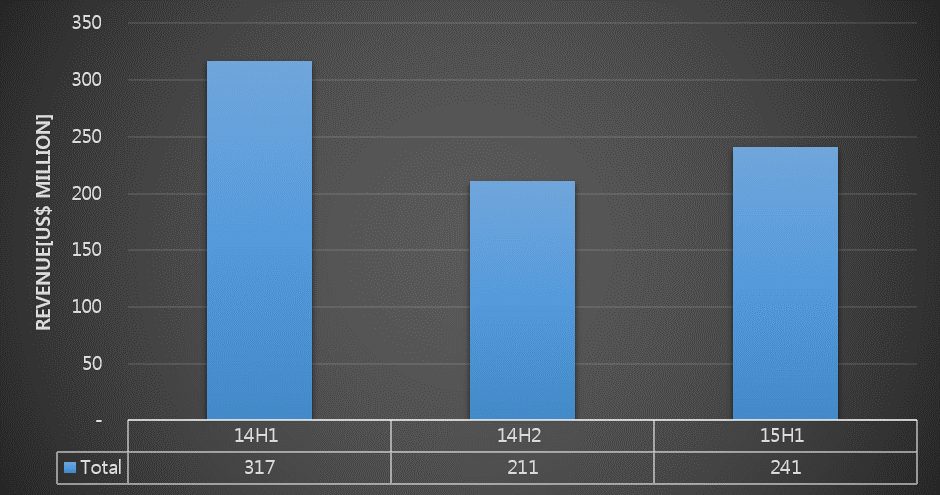
반기별 OLED 발광재료 시장 실적 2014H1~2015H1
[IFA 2015] Directions for LG Electronics’ OLED TV?
/0 코멘트/카테고리: 디스플레이 /작성자: OLEDNETDuring the media day event for IFA 2015 (September 4 – 9), LG Electronics introduced diverse products centering around OLED TV such as LCD TV, G4, and G Watch Urbane.
LG Electronics clearly confirmed that the ultimate TV for the company is OLED TV. At the company booth under the title of the Evolution of TV, LG Electronics revealed that the TV’s final destination is OLED TV.
At this exhibition, the OLED TV presentation theme returned to the flat design from HDT’s emphasis on black and previous curved design. Until now, curved design focused OLED TV were exhibited, but with the spotlight on flat design in IFA 2015, LG Electronics strongly hinted that future LG OLED TV will switch to flat products.
Competitors greatly improved contrast ratio through application of LCD TV and HDR. LCD’s basic contrast ratio is approximately 1,000:1, and in premium products currently being mass produced it has improved to 3,000:1. However, as OLED TV does not use backlight, the minimum contrast ratio is 100,000:1 with maximum of infinite contrast ratio. Through IFA 2015 LG Electronics is planning to actively release HDR technology applied products. In order to achieve this, the company will demonstrate HDR transmission with broadcasting companies such as BBC and publicize OLED TV’s black and white’s superiority over LCD TV.
LG Electronics provided ‘perfect color’, ‘perfect black’, and ‘perfect angle’ as the superior characteristics of OLED TV. These advantages are inherent characteristics that LG’s WRGB OLED TV can provide that show excellence over LCD TV in any environment.
However, the OLED TV presented in this exhibition did not show much improvement from one in IFA 2014, leading to disappointment. It is a point of concern whether WRGB OLED TV has already reached its limitation.
[IFA2015] LG전자 OLED TV 방향은?
/0 코멘트/카테고리: 디스플레이 /작성자: OLEDNET9월 4일부터 개최된 IFA2015의 Media day에서 LG전자는 OLED TV를 중심으로 LCD TV와 G4, G Watch Urbane 등 다양한 제품들을 소개했다.
우선 LG전자가 추구하는 궁극의 TV는 OLED TV임을 이번 전시회에서 명확히 밝혔다. LG전자는 자사 부스에서 TV의 진화라는 제목하에 TV의 종착역은 OLED TV가 될 것임을 소개하였다.
이번 전시회에서 OLED TV 전시 컨셉은 “black”을 강조한 HDR과 이전의 curved design에서 flat design으로 되 돌아왔다. 이제까지의 전시회에서는 curved design 위주의 OLED TV가 전시되었지만, 이번에는 flat design이 주를 이룸으로 인해 향후 LG전자 OLED TV는 평면 제품으로 전환될 것임을 강하게 암시하였다.
경쟁업체들은 LCD TV와 HDR을 적용하여 contrast ratio를 상당히 향상 시켰다. LCD는 기본적으로 1,000:1 정도이며 최근 생산되고 있는 premium급 제품에서는 3,000:1정도까지 향상되고 있다. 하지만 OLED TV는 backlight를 사용하지 않기 때문에 최소가 100,000:1이며 최대는 무한대의 명암비를 나타내고 있다. 이번 IFA2015를 통하여 OLED TV에도 HDR 기술을 적용한 제품을 본격적으로 출하할 예정이다. 이를 위해 LG전자는 BBC등 방송사들과 함께 HDR 방송을 시연하며 OLED TV의 black과 white가 LCD TV 대비 비교되지 않을 정도로 우수함을 홍보할 예정이다.
LG전자는 OLED TV의 가장 우수한 특성으로 “Perfect Color”와 “Perfect Black”, “Perfect Angle”을 꼽았다. 이 특성들은 LG의 WRGB OLED TV가 나타낼 수 있는 유전적인 특성으로서 어떠한 환경에서도 LCD TV 보다는 우수함을 소개했다.
하지만 이번 전시회에 소개된 OLED TV는 IFA2014에 비해 개선된 특성이 보이지 않아 많은 아쉬움을 남겼다. WRGB OLED TV의 한계가 벌써 도달했는지 걱정되는 시점이다.
UHD OLED TV, Rapidly Catching Up to SUHD TV Price
/0 코멘트/카테고리: 미분류 /작성자: OLEDNETOLED TV price, once again, dropped down by a large margin. LG Electronics’ new 2015 model 65inch 4K Ultra HD curved OLED TV (65EG9600) on Amazon (www.amazon.com) fell to US$ 6,999 which is a drop of US$ 2,000 from previous US$ 8,999. The price for 55inch 4K Ultra HD curved OLED TV fell US$ 1,000 to US$ 4,499 from its release price of US$ 5,499. The 2015 new model EG9600 series has panel with improved brightness of 450nit from previous 400nit.
The price of Samsung Electronics’ SUHD TV, similar premium product to LG Electornics’, is US$ 4,997 for 65inch (UN65JS9500), and US$ 2,497.99 for 55inch; there is a difference of approximately US$ 2,000 between LG Electronics’’ UHD OLED TV of same size.
The comparison between 2015 65inch UHD OLED TV and SUHD TV shows that approx. 40% price difference was shown in April 2015. However in July 2015, the difference was approx. 30%, showing that UHD OLED TV price further fell by approx. 10%.
These show that the UHD OLED TV price reduction is occurring rapidly. It is analyzed that the biggest factor for LG Electronics’ UHD OLED TV price fall is production cost reduction due to UHD panel yield increase and competition with set companies that actively began OLED TV sales.
UHD OLED TV, 빠른 속도로 SUHD TV 가격 따라잡는다
/0 코멘트/카테고리: 시장 /작성자: OLEDNETOLED TV 가격이 다시 한번 큰 폭으로 하락했다. 아마존(www.amazon.com)에서 LG전자의 2015년 신모델인 65inch 4K Ultra HD curved OLED TV(65EG9600)의 가격이 US$ 6,999로 기존의 US$ 8,999에 비해 US$ 2,000이 하락한 것으로 나타났다. 55inch 4K Ultra HD curved OLED TV의 가격은 US$ 4,499로 출시가인 US$ 5,499보다 US$ 1,000이 하락 하였다. 2015년 신모델인 EG9600 series는 휘도가 기존 400nit에서 450nit로 향상된 panel을 적용한 제품이다.
비슷한 프리미엄 제품군인 Samsung전자의 SUHD TV의 가격은 65inch(UN65JS9500)가 US$ 4,997, 55inch(UN55JS9000)가 US$ 2,497.99로 같은 size의 LG전자의 UHD OLED TV와 비교하여 약 US$ 2,000씩 차이가 나는 것으로 나타났다.
2015년 65inch 모델기준 UHD OLED TV와 SUHD TV의 가격차이를 비교해보면 2015년 4월 기준 약 40%의 가격차이가 났지만 2015년 7월 기준으로는 약 30%의 가격차이로 UHD OLED TV의 가격하락이 약 10%만큼 더 큰 것으로 분석되었다.
이처럼 UHD OLED TV의 가격 하락 속도가 빠르게 이루어 지고 있다. LG전자 UHD OLED TV의 가격하락의 가장 큰 요인은 UHD panel의 수율 상승으로 인한 원가하락과 본격적으로 OLED TV 판매를 시작한 경쟁 set업체들을 고려한 것으로 분석된다.
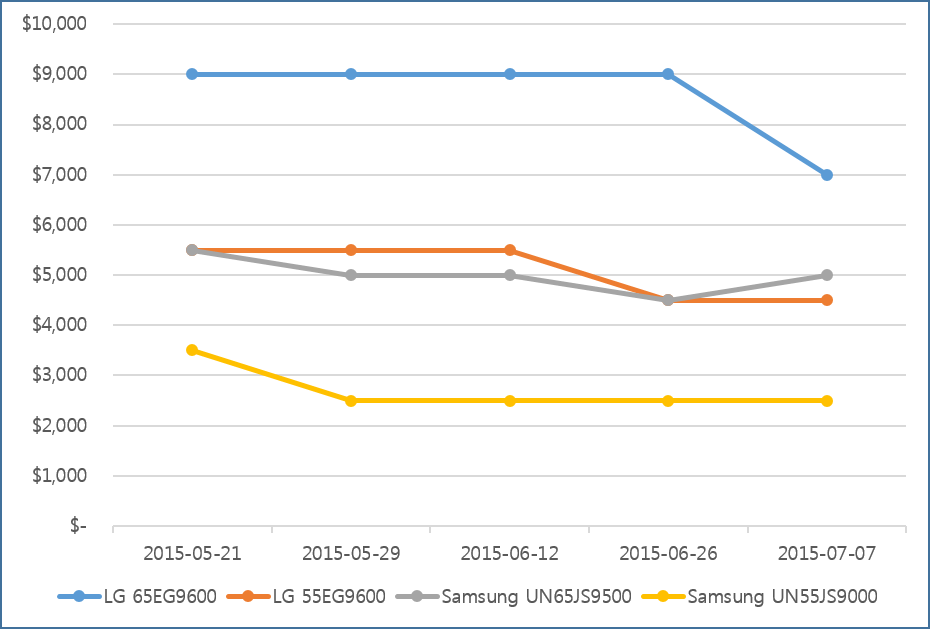
UHD TV 가격 추이, Source : 유비산업리서치
[Analyst Column] Korean TV Industry, Where to Go?
/0 코멘트/카테고리: 미분류 /작성자: OLEDNETDr Choong Hoon Yi, UBI Research Chief Analyst, ubiyi@ubiresearch.co.kr
Korean TV industry, according to recent reports by media, is showing a red light not being able to escape the deficit structure.
Samsung Electronics and LG Electronics possess high market share in costly premium TV market. However, in 30inch grade market, the two companies struggle against economically priced sets. In order to maintain sales, Samsung Elec. and LG Elec. are managing diverse product portfolio but business profit keep falling. Due to this, LCD panel stocks produced by Samsung Display and LG Display are steadily increasing.
LCD panel business is sinking into a pit.
What is the reason that Korea’s LCD TV and LCD business values can only become worse?
This can be forecast from looking at Japan’s TV and LCD business. Until the early 2000s, Japan was one of the leaders in electronics. However, Japan’s TV business is gradually dying out. Japan’s leading companies, Sony and Panasonic’s TV business began to be deteriorate because of Korean mid-low price products. In succession, Sony ended up spinning off the TV business, and Panasonic stopped TV business other than for domestic supply. Korean TV companies began to dominate the market. However, only a few years since then, Korean TV industry is losing commercial value, pushed aside by mid-low price products manufactured by China and others.
Second is display investment. As Japanese TV industry began to crumble, Japanese display companies had no choice but to stop the investment. The companies could not see a way to make profit through investment even if TV market grew as client companies’ panel purchasing power fell. Korea is the same. Samsung Elec. and LG Elec.’s TV business profitability deterioration led toward Samsung Display and LG Display’s halting the investment. On the other hand, Chinse display companies began Gen10.5 line investment. TV industry relies on assembly business and business network and therefore initial investment cost is low. In comparison, display industry is high risk as it requires large scale investment from early stages. If the business profit falls without investment cost return, companies face great loss and business closure is also not easy.
The third reason that Japanese TV companies are dying out is because they could not produce premium TV. Sony, which lost its competitiveness in LCD TV, tried to strengthen its market leadership through 4K TV. However, the brand value was already down and with the lack of marketing value, Sony easily gave up the market to companies in pursuit such as Samsung Elec. and LG Elec. LCD TV already had no difference in quality whether it was produced by a Korean or Japanese company, and brand value order had switched. LCD TV quality produced by Chinese companies is already reached the top. They are no longer companies who produce cheaper knockoffs. Furthermore, LCD panel production technology of Korea, Japan, Taiwan, and China can now be deemed equal.
The final reason that stops Japanese TV business from securing market is that they failed to suggest differentiation point in premium TV. Fundamentally, differentiation is not possible for LCD TV. The biggest differentiation factors in the current TV market are picture quality and design. Any company can produce thin LCD TV and curved LCD TV. Panel size, resolution, and QD-LED using color gamut that LCD can actualize can no longer be differentiated technology. The difference of LCD panel and TV manufacturing technology between Korea, Japan, Taiwan, and China is already within a year. No matter what kind of product is released, market control has one year of expiration period. Considering the promotion period required in the market is approximately 6 months, the period where profit can be made is shortened even further.
So what is the solution for the Korean TV industry to survive?
As I have mentioned dozens of times for several years, what is left is OLED TV. What LCD cannot do in terms of picture quality and design, with OLED it is possible. Therefore, only the non-LCD products can enjoy the key factors of differentiation in premium TV market.
Existing premium TV is IPTV, a market that Japanese TV companies have been pursuing since early 2000s. Internet connection is possible through TV and allows for exchange of information in both directions. The basic concept of IPTV is watching TV while searching the information on TV via internet. But how useful is this concept at present? The usefulness of IPTV is becoming increasingly low as smartphone is used to search information, use the internet, and even watch TV. With no reason to use the internet via TV, TV companies should seriously consider whether TV with high white brightness is really needed. Rather than white TV with high brightness, it is time to place more importance in the functions of the TV itself. TV screen only uses 20-30% of full white brightness. Films, with outdoor shooting, falls under 20%, and for contents shot at night, black is more important.
Considering ‘blackness’ and design, anyone can find where the solution lies. If the foolish notion of trying to make OLED as bright as LCD is abandoned, there is hope.
[Analyst Column] 한국 TV 산업, 어디로 가야 하나?
/0 코멘트/카테고리: 시장, 애널리스트 칼럼, 포커스온 /작성자: OLEDNET이충훈 / 수석 애널리스트 / 유비산업리서치 / ubiyi@ubiresearch.co.kr
최근 신문 지상을 통해 보도되는 한국의 TV 산업은 적자 구조에서 벗어나지 못하고 있는 빨간 불이다.
프리미엄급 고가 TV 시장은 삼성전자와 LG전자의 시장 점유율이 높지만 30인치급에서는 저가 제품에 밀려 고전을 면치 못하고 있기 때문이다. 삼성전자와 LG전자는 매출을 유지하기 위해 제품 포트폴리오를 다양하게 운영하고 있으나 영업 이익은 점점 바닥으로 떨어지고 있다. 이러한 여파로 삼성디스플레이와 LG디스플레이에서 생산하는 LCD 패널 재고가 점차 증가하고 있다.
LCD 패널 사업이 점차 수렁으로 빠져들고 있다.
한국의 LCD TV와 LCD 사업성이 나빠질 수 밖에 없는 이유는 무엇일까?
이것은 이미 일본의 TV와 LCD 사업이 걸어온 길을 보면 예견 할 수 있다. 2000년대 초반까지만 해도 일본은 전자 왕국이었다. 하지만 일본의 TV 사업은 점점 도태되고 있다. 한국의 중저가 제품에 의해 일본을 대표하는 Sony와 Panasonic의 TV 사업이 붕괴되기 시작했고, 이어서 LCD 사업마저 적자 구조로 급변화하게 되었다. 급기야 Sony는 TV 사업을 분사하게 되었고, Panasonic은 내수용을 제외한 TV 사업을 중단시켰다. 한국 TV 업체가 시장을 지배하게 되었다. 하지만 불과 수년 만에 한국의 TV 사업이 중국 등지의 중저가 제품에 의해 점차 사업성을 잃어가고 있다.
두 번째는 디스플레이 투자이다. 일본 TV 산업이 무너지기 시작하자 일본의 디스플레이 업체들은 투자를 중단할 수 밖에 없게 되었다. 고객사들의 패널 구매력이 나빠졌기 때문에 TV 시장은 성장하여도 투자를 해서 이익을 창출 할 수 있는 통로가 보이지 않았기 때문이다. 한국 역시 마찬가지이다. 삼성전자와 LG전자의 TV 사업 수익성 악화가 곧 삼성디스플레이와 LG디스플레이의 투자 중단을 불러왔다. 하지만 중국 디스플레이 업체들은 Gen10.5 라인 투자도 시작하였다. TV 사업은 조립 사업과 영업망에 의존되고 있어 초기 투자 비용이 적다. 하지만 디스플레이 사업은 초기부터 막대한 자금을 투입해야 하기 때문에 리스크가 매우 큰 사업이다. 투자비 회수를 하지 못하고 영업 이익이 떨어지면 기업들은 막대한 손실을 입게 되며 사업 정리도 쉽지 않은 특성이 있다.
일본의 TV 사업이 도태된 세 번째 이유는 프리미엄 TV를 만들지 못한 것이다. LCD TV에서 경쟁력을 상실한 Sony는 시장 지배력 강화를 위해 4K TV로서 시장 부활을 노렸지만, 이미 브랜드 가치가 하락하고 마케팅력이 상실되었기 때문에 뒤이어 추격한 삼성전자와 LG전자 등에 시장을 쉽게 내주게 되었다. LCD TV는 이미 일본 기업이 만드나 한국 기업이 만드나 차이가 없으며 브랜드 가치는 역전되었기 때문이다. 중국 기업들이 생산하는 LCD TV 수준도 이미 정상에 도달했다. 더 이상 짝퉁을 만드는 기업들이 아니다. 더구나 LCD 패널 제조 기술은 한국과 일본, 대만, 중국이 대등하다고 봐도 무방한 시대가 되었다.
일본 TV 사업이 시장 확보를 하지 못하고 있는 마지막 이유는 프리미엄 TV에서 차별화 포인트를 제시하지 못하기 때문이다. 기본적으로 LCD TV로서는 차별화를 시킬 수 없다. 현재 TV 시장에서 가장 큰 차별화 요소는 화질과 디자인이다. 어떤 기업이든지 얇은 LCD TV와 curved LCD TV는 만들 수 있다. LCD가 할 수 있는 패널 사이즈, 해상도, QD-LED를 사용한 색재현율은 더 이상 차별화된 노하우가 될 수 없다. 한국과 일본, 대만, 중국의 LCD 패널과 TV 제조 기술 격차는 이미 1년 이내이기 때문에 어떤 제품을 내놓아도 시장 지배 유효 기간은 겨우 1년에 불과하다. 시장에서 제품 홍보에 필요한 6개월 정도 기간이 소요되는 것을 감안하면 이익을 낼 수 있는 기간은 더욱 줄어든다.
한국 TV 사업이 살아 남을 수 있는 대안은 무엇일까?
이미 수년간 수 십 차례 언급하였지만 남은 것은 OLED TV 뿐이다. LCD가 할 수 없는 화질과 디자인은 OLED에서는 가능하기 때문이다. 즉 프리미엄 TV 시장에서 차별화 시킬 수 있는 핵심 요소는 LCD가 아닌 제품뿐이다.
기존의 프리미엄 TV는 IPTV로 이미 2000년대 초반 일본 TV 업체들이 추구해 온 시장이다. TV를 이용해 인터넷을 하며 쌍방향으로 정보를 교환하는 방식이다. TV를 보면서 TV에 나오는 정보를 인터넷으로 검색한다는 것이 IPTV의 기본 개념이다. 하지만 현재 사회에서 과연 IPTV라는 개념이 유효한지에 대해서는 의문이다. 왜냐하면 smart phone으로 정보를 검색하고 인터넷을 하며, TV까지 보게 된 지금 시대에서 IPTV의 실효 가치는 점차 낮아지기 때문이다. TV에서 인터넷을 할 이유가 없기 때문에 full white 휘도가 높은 TV 제품이 과연 필요한지에 대해서는 TV 업체들이 다시 한번 심각하게 고민해야 한다. 고휘도의 white TV 보다는 오히려 TV 그 자체 기능에 충실하게 돌아가야 할 시점인 것이다. TV 화면은 full white 기준 20~30% 정도의 밝기만 사용한다. 영화는 야외 촬영이 많기 때문에 20% 이하로 떨어지며 오히려 야간에 촬영된 콘텐츠는 black이 더욱 중요하다.
“black”과 디자인을 고려하면 답이 어디에 있는지는 누구도 찾을 수 있다. OLED를 LCD처럼 밝게 만들려는 어리석은 생각만 버리면 미래는 있다.
Korea, China, and Japan’s OLED TV Alliance to Boost the Market
/0 코멘트/카테고리: 미분류 /작성자: OLEDNETKorean companies had been leading the OLED TV industry. Before SID 2015 (31 May – 5 June), LG Display and Samsung Display had been the only companies to reveal 4K OLED panels, and until now, LG Electronics has been the only company to sell 4K OLED TV in large quantity. In terms of OLED TV market, despite OLED’s superior characteristics compared to LCD regarding contrast ratio, high viewing angle, fast response time, and thinness, the market share has been limited mostly due to its relative high price. However, this is expected to change soon.
LG Electronics has been pushing for OLED TV alliance and corporation with Chinese and Japanese companies. As a result, Chinese and Japanese companies resolved to jump into OLED TV market from the second half of 2015. Japan’s Panasonic and Sony are expected to release OLED TV for the first time later this year. China’s Skyworth, Changhong, Konka, and Hisense are expected begin sales from this fall.
Consequently, the number of set companies producing 4K OLED TVs will increase to 7 by the end of 2015. LG Display, the only company that can mass produce OLED panel with 4K resolution, is planning to increase production by 4 times this summer to supply these new to OLED TV set companies.
As mentioned above, until SID 2015, LG Display and Samsung Display had been the only companies which showed 4K OLED panels, and with LG Display being the sole company able to mass produce 4K OLED panels. However, in SID 2015, AUO showed their own 4K OLED panel during an author interview session, and CSOT and BOE presented paper on 4K resolution OLED panel. This signifies they possess technology needed for OLED panel production, and with proper investment they can begin mass production.
Soon LG Display will no longer be the lone supplier of OLED panels contributing toward increase in shipment of OLED panels and OLED TVs. This will naturally lead to lower cost for consumers and energize OLED TV market.
한국과, 중국, 일본의 OLED TV 동맹, OLED TV 시장 본격 개화
/0 코멘트/카테고리: 시장 /작성자: OLEDNETOLED TV 산업은 지금까지 한국 기업들이 이끌어 왔다. 미국 산호세에서 열린 SID 2015 (5/31~6/5) 전까지는 LG디스플레이와 삼성디스플레이가 4K OLED 패널을 공개한 유일한 패널업체였고, 현재까지 OLED TV를 대량으로 판매하는 업체는 LG전자가 유일하다. 그 동안, TV 시장에서는 OLED가 LCD보다 명암비와, 시야각, 응답속도, 두께에 관하여 우월하나 비교적 높은 가격으로 인해 시장점유율이 제한되었다. 하지만, 이제 이는 곧 달라질 것으로 예상된다.
그 동안, LG전자는 OLED TV 동맹으로 중국, 일본 업체들과의 협력을 추진해 왔다. 그 결과 중국과 일본 업체들은 2015년 하반기부터 OLED TV 시장에 뛰어들기로 하였다. 일본의 파나소닉과 소니는 올해 하반기에 OLED TV를 처음으로 출시할 예정이며, 중국의 스카이워스와, 창훙, 콩카, 하이센스는 이번 가을부터 판매를 시작할 계획이다.
결과적으로 2015년 말까지 4K OLED TV를 생산하는 세트업체는 7개로 늘어난다. 4K 해상도의 OLED 패널을 대량 생산할 수 있는 유일한 업체인 LG디스플레이는 OLED TV 생산을 시작하는 세트업체들에 공급하기 위해 올 여름 생산량을 4배 증가시킬 예정이다.
위 언급한 내용과 같이, SID 2015까지 4K OLED 패널을 공개한 업체는 LG디스플레이와 삼성디스플레이가 유일했고, 이 두 업체 중 LG디스플레이만이 4K OLED 패널을 대량 생산 할 수 있다. OLED TV를 생산할 세트업체는 늘어나고 있지만 패널 공급업체는 LG디스플레이 한 곳으로서 장기적으로 봤을 때 추가적인 공급업체가 더 필요할 것으로 예상된다.
이번 SID 2015에서 AUO는 author interview 시간에 4K OLED 패널을 선보였고, CSOT와 BOE는 4K OLED 패널 관련 논문을 발표했다. 이는 AUO와 CSOT, BOE가 OLED 패널 제작에 필요한 기술을 보유하고 있다는 것을 나타내고 있으며, 적절한 시기에 투자가 이루어진다면 대량생산을 시작할 수 있다는 것을 의미한다.
따라서 앞으로 증가할 것으로 예상되는 OLED TV 수요에 맞춰 LG디스플레이뿐 아니라 후발 업체들 또한 OLED TV용 패널을 양산할 것으로 기대되어 OLED 패널과 OLED TV 출하량 증가에 기여할 것으로 전망된다. 이러한 발전은 소비자에게는 낮은 가격으로 연결될 것이고 OLED TV 시장은 활성화 될 것이다.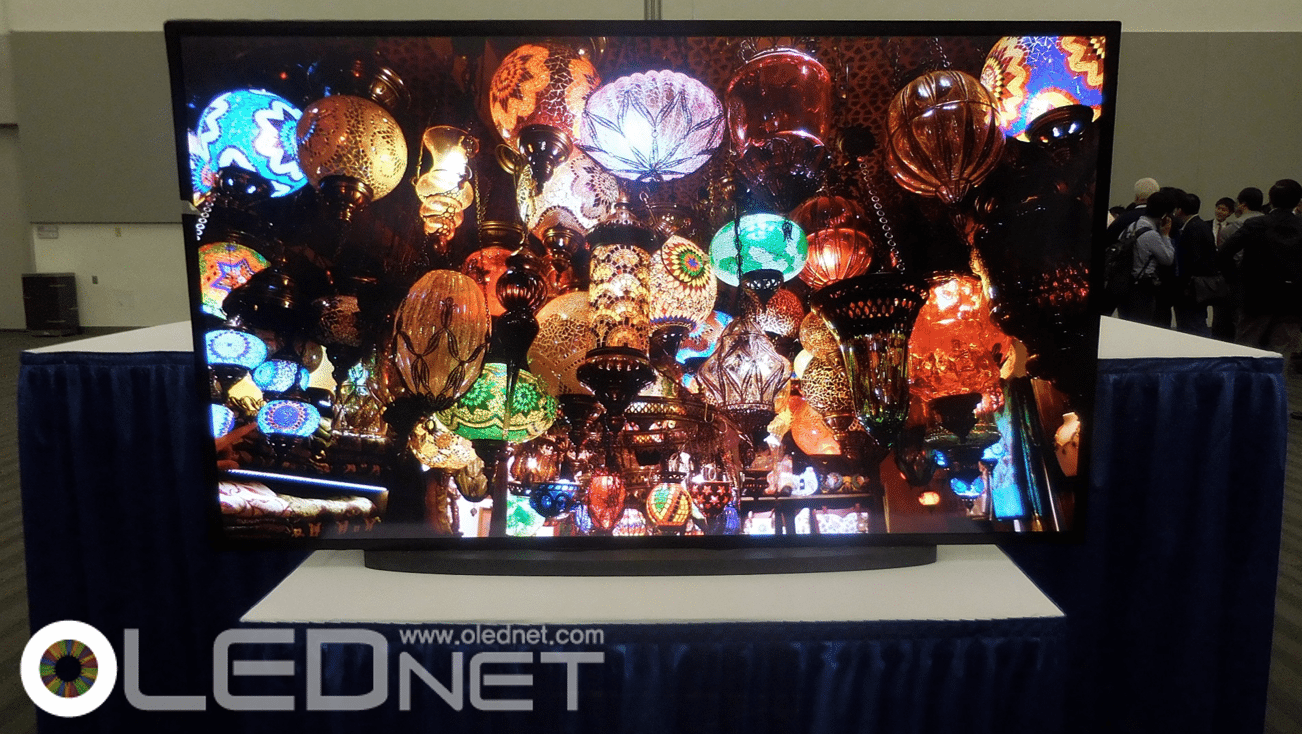
LG Electronics, Not Selling OLED TV? Or Can’t Sell?
/0 코멘트/카테고리: 미분류 /작성자: OLEDNETOLED TV business that LG Electronics ambitiously prepared for is remaining at a standstill for more than 2 years. Korean media is reporting that the OLED TV sales in Korea reached 3,000 units per month, but this figure is too weak.
The money that LG Display have invested in line establishment for OLED panel for TV is already exceeding approx. US$ 1,400,000,000. Annual depreciation cost for equipment investment alone, excluding cost of labor and material, is approx. US$ 280,000,000.
Considering the current cost for FHD OLED TV is approx. US$ 1,800 – 3,300, monthly sales of 3,000 units in Korea only result in approx. US$ 9,400,000. With approx. 10,000 units per month being sold in the world, monthly revenue is merely US$ 23,000,000.
Although LG Display is aiming for 600,000 units of OLED panel for TV shipment this year, with LG Electronics’ first quarter world OLED TV sales of approx. 30,000 units, there is concern that only 100,000 – 200,000 units will be sold in 2015.
It is difficult to understand whether this uncommonly low sales of LG Electronics’ OLED TV is because they are not selling them or unable to sell them.
It seems plain that the initial price of OLED TV in 2013, approx. US$ 14,000, was set in order to not sell. LED TV at the time was being sold at approx. US$ 2,800, and the 5 times more expensive price was too high to be considered a normal premium price. Consequently, the 2013 OLED TV market stopped at around 10,000 units, and in 2014 remained around 100,000 units.
At this point, feasible production rate for LG Display’s 55 inch FHD OLED panel needs to be compared. In 2013, LG Display’s M1 line yield rate was approx. 40% with annual possible production of 50,000 – 100,000 units. As the yield rate increased to 80% in 2014, it is estimated that 200,000 units or more would have been produced.
Compared to LG Display’s investment cost and production potential, the LG Electronics’ OLED TV sales results are too shabby.
Of course, as the current main product on the market is FHD, when the newly released UHD OLED TV market actively opens the figures could always change. However, with 55 inch UHD OLED TV having to compete with Samsung Electronics’ SUHD TV, the market is not so easy. SUHD TV costs approx. US$ 3,700, and UHD OLED TV costs about 25% more with US$ 5,100.
Compared to the initial price of FHD OLED TV, approx. US$ 14,000, 2 years ago the UHD OLED TV price is low enough to be quite reasonable. However, with the performance of past 2 years it appears that LG Display might be inadequate to widely open the OLED TV market.
It makes one wonder how Samsung Electronics became the world leading company with their OLED panel equipped Galaxy series achieving 20% mobile market share, a market that used to be dominated by LCD panel.

